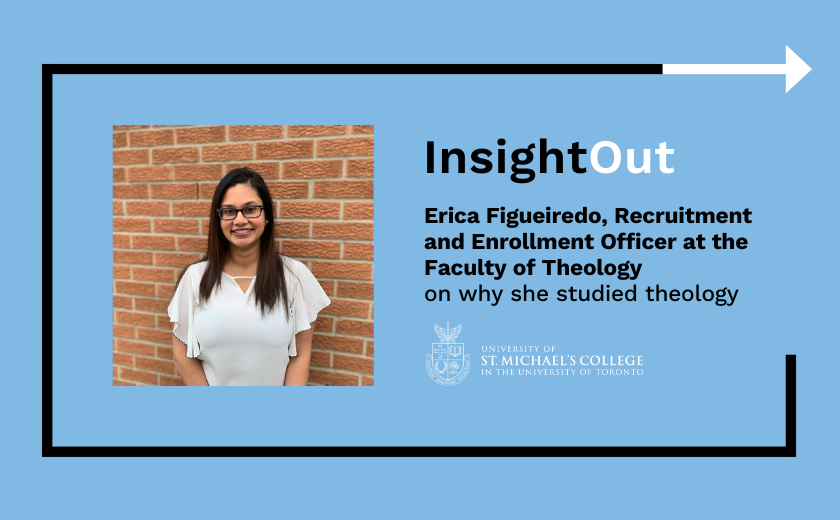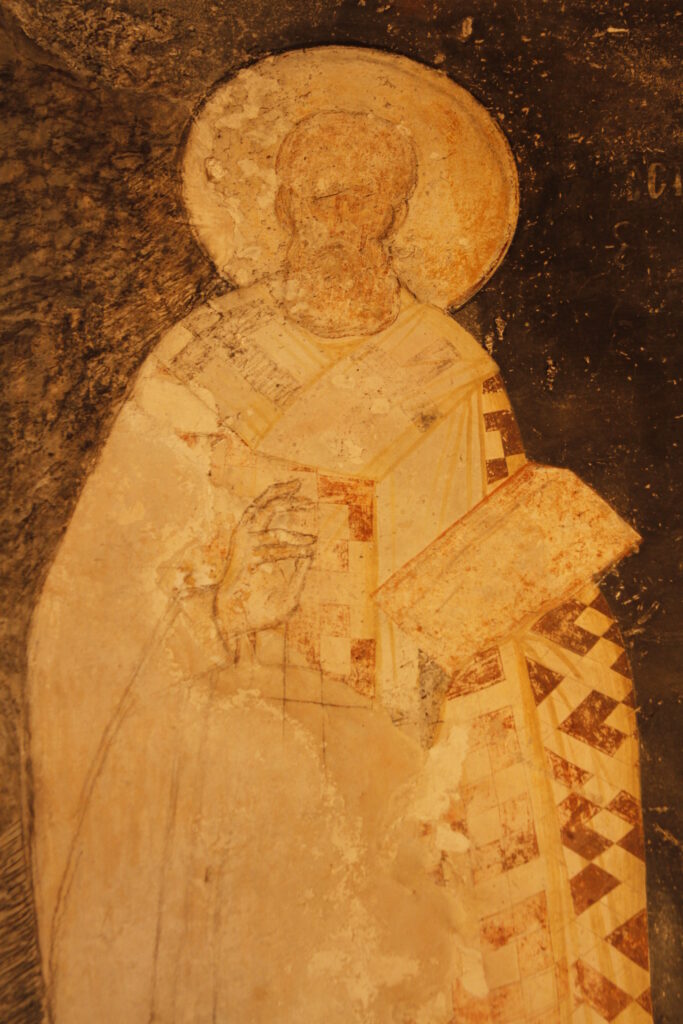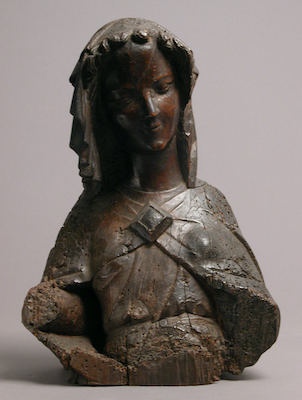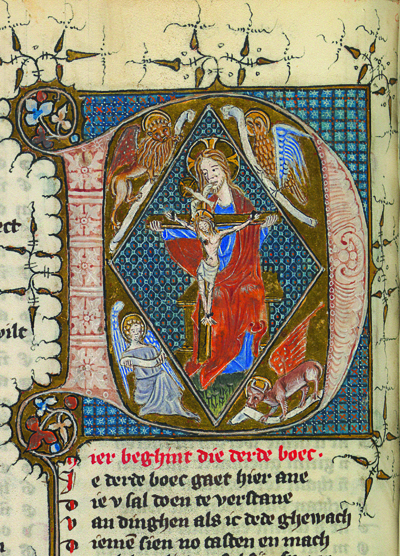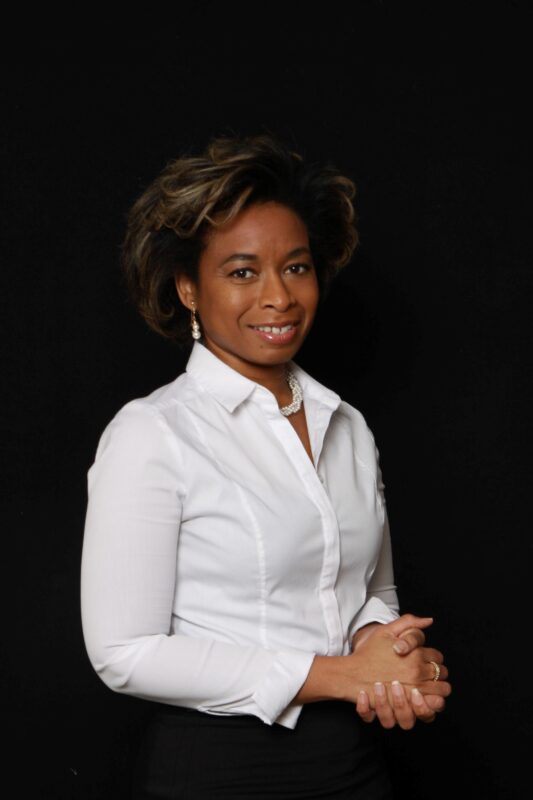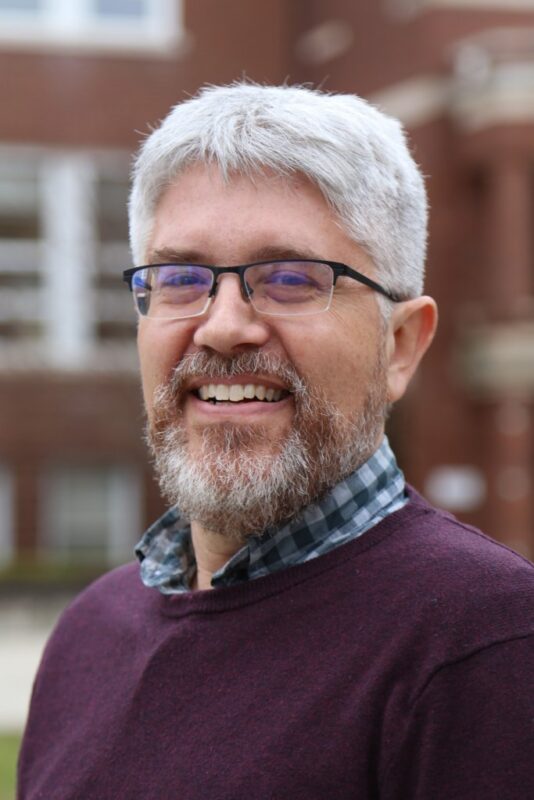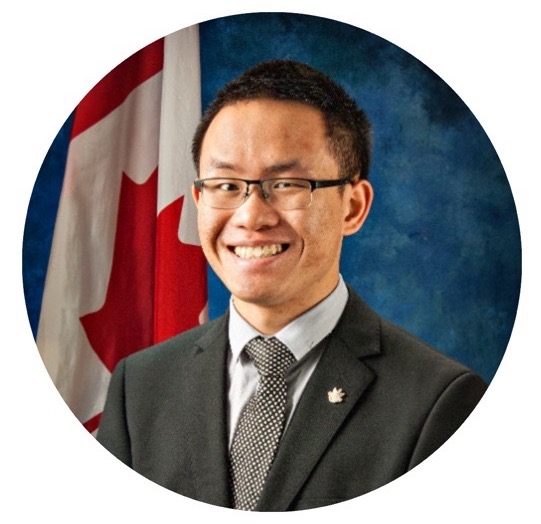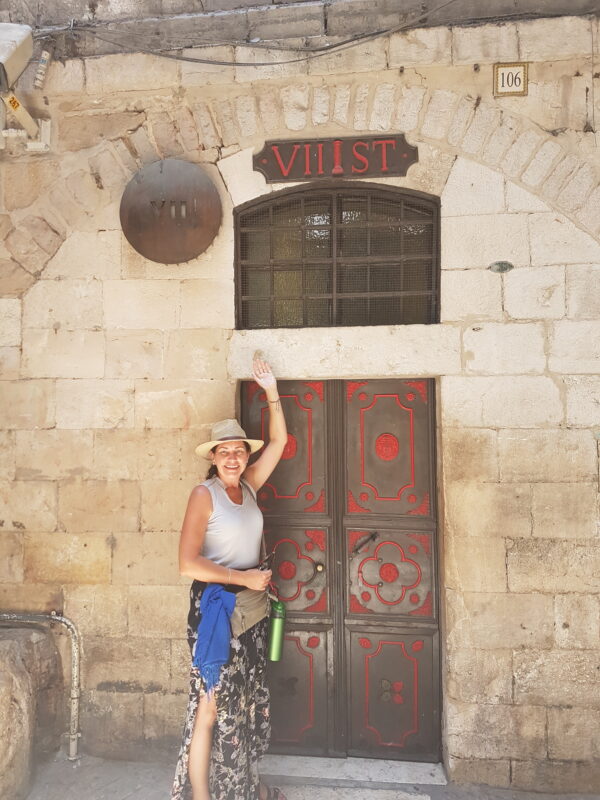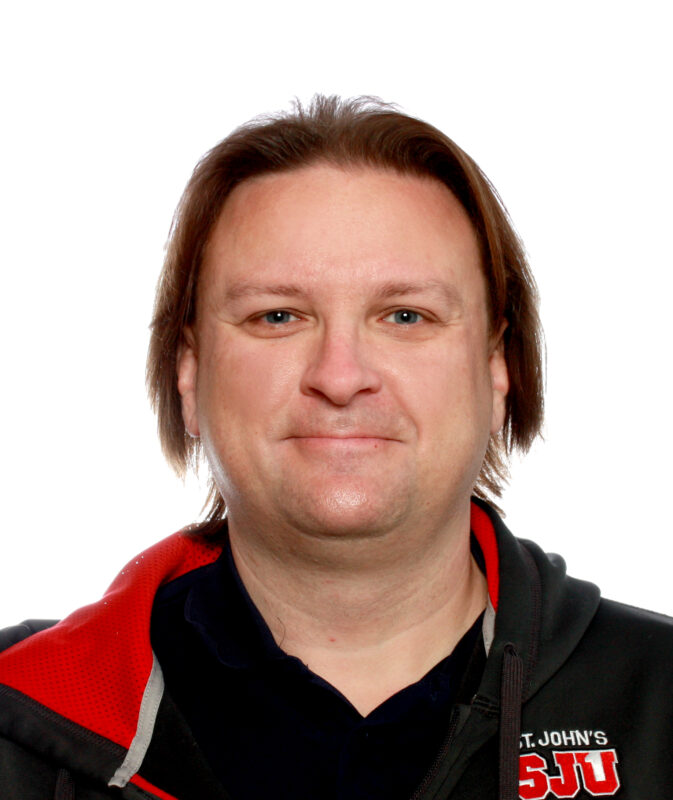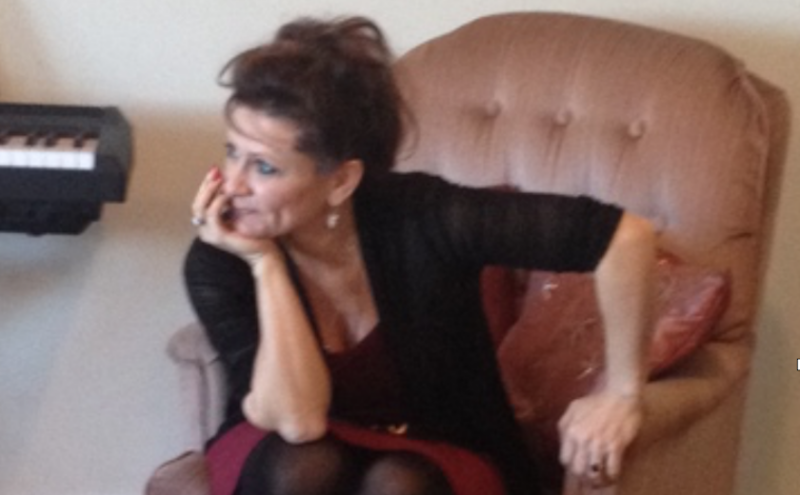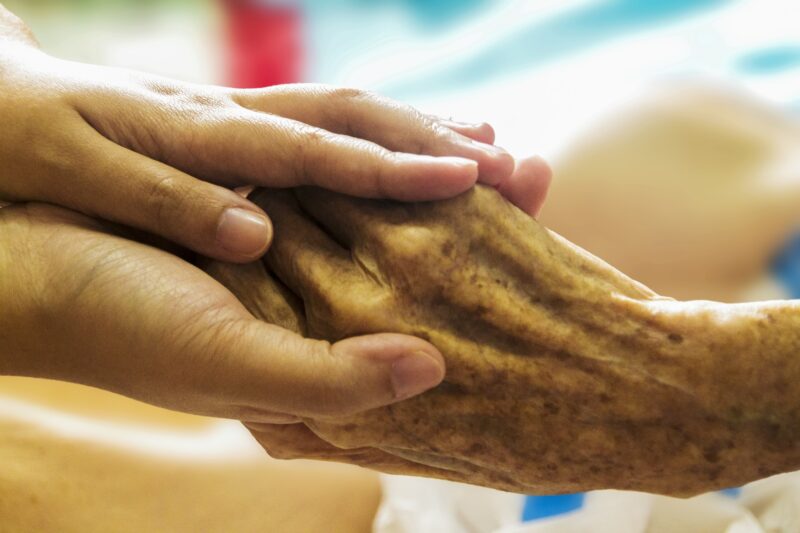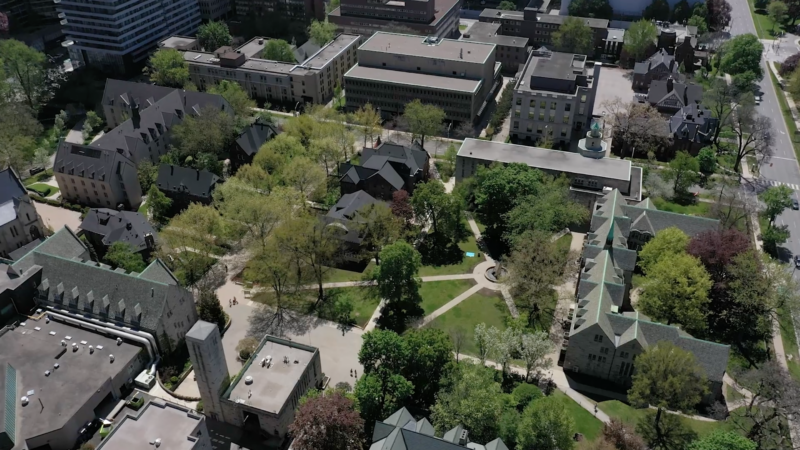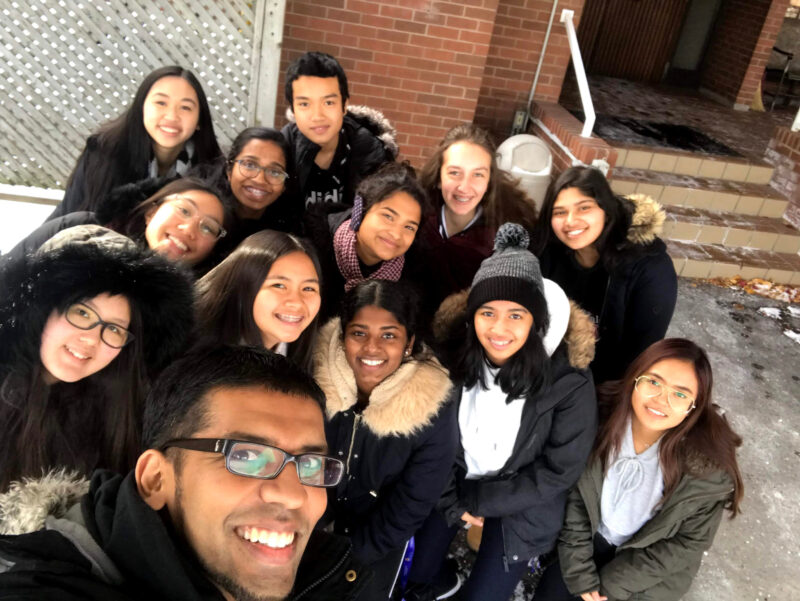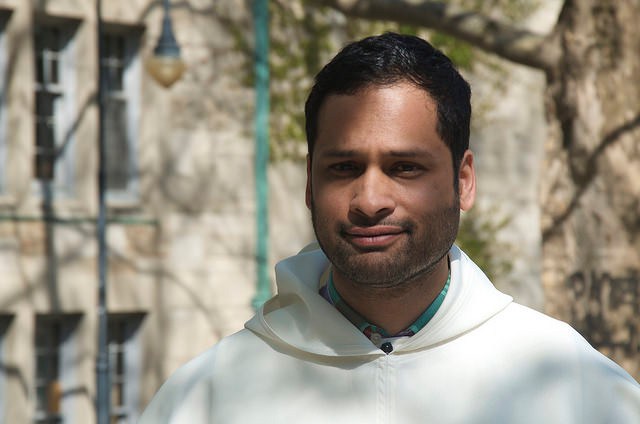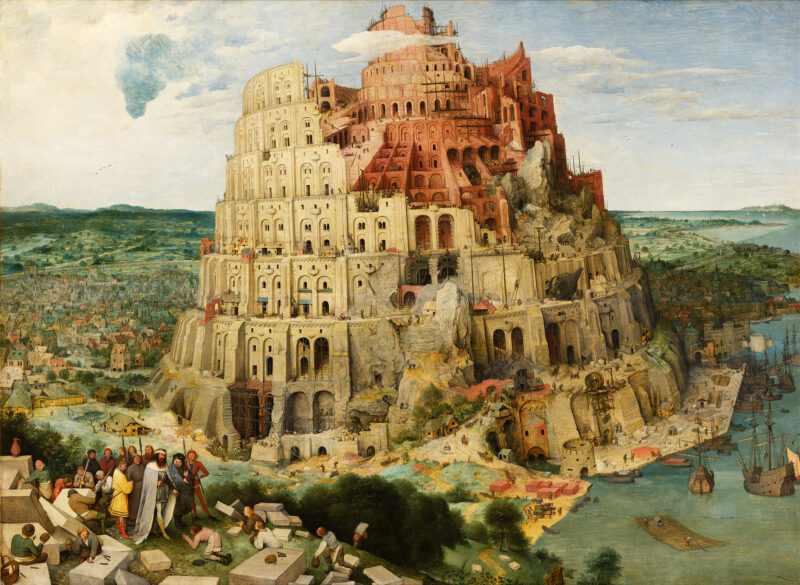Erica Figueiredo is the Recruitment and Enrollment Officer at the Faculty of Theology. Prior to this role, she completed her Master of Divinity degree at Regis College and served as a Director of Campus Ministry for seven years. She has been married to her best friend Carl for over four years.
I was 22 years old, sitting in my cubicle at the first job I landed after graduating from university. On my computer screen, I found myself oscillating between two tabs: one, an Excel spreadsheet compiling something about reinsurance companies (companies that insure insurance companies, I learned) and the other an application form for a Master of Divinity degree program. I recall the motivations I had to proceed with each tab. On the one hand, I could remain here and continue what likely could have been a quickly rising, lucrative career in the financial district. Conversely, the prospect of studying theology and entering ministry was something that had not even registered as a possibility until recently.
My mind raced back to the surprising turn of events during the last two years of my undergraduate degree. After a profound experience at a retreat, I finally felt convinced that instead of waiting for someone else to form a Catholic club at my university, the person whom God was calling to do that was me. From there, an unforgettable journey ensued. Once I plucked up the courage to start this club (which only two other students had agreed to support thus far) God led me past the realms of what I thought possible. Within a year I was the inaugural president and co-founder of a vibrant Catholic community. Students from all fields of study came to the meetings with an eagerness to know their faith more deeply. For my part, I couldn’t be anything but honest about the doubts I had also had as a cradle Catholic. But the philosophy student in me sought to tackle these doubts head-on and in a Lewisian style, embark on a journey to conclude if Christianity was true or completely false, in which case I should abandon it entirely. In His own beautiful time, God revealed to me that the former was undeniably true and the quest for truth, beauty and goodness could be found within my Catholic faith instead of looking elsewhere. As I graduated from university and fondly recalled my latter two years of journeying with this group, I also recalled a priest I met telling me that this club could over time develop into a formal campus ministry. Upon graduation, I pushed this thought to the back of my mind and preoccupied myself with finding a ‘normal’ job.
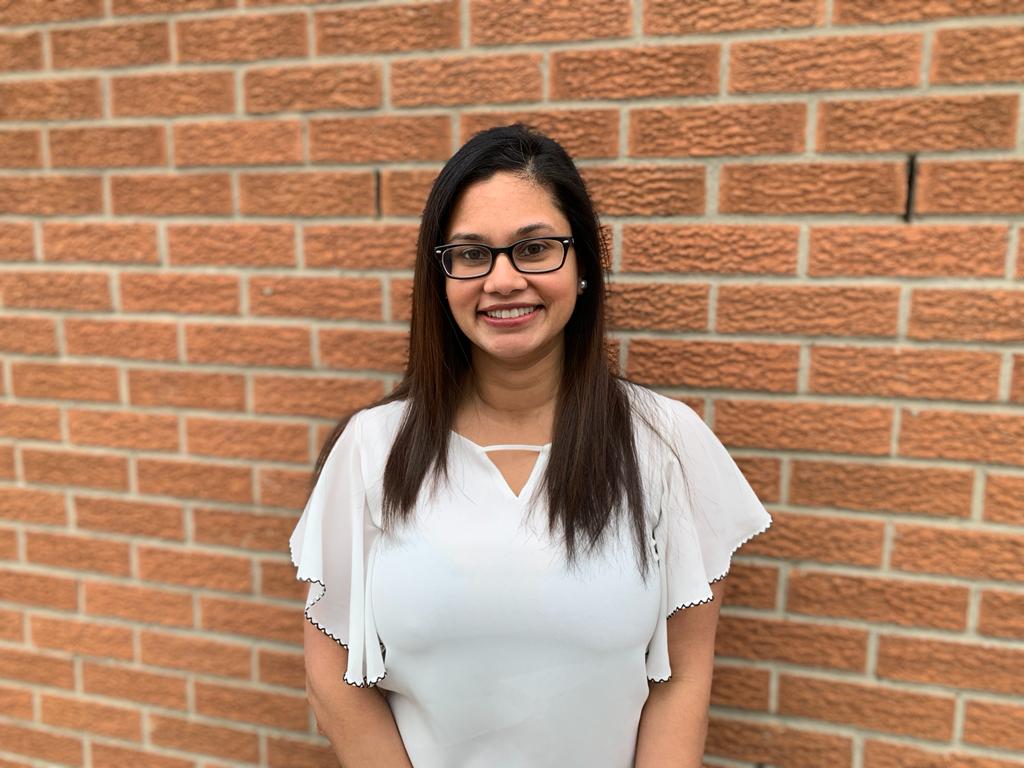
Close your eyes and think about a moment in your life when you had the most joy.
Erica Figueiredo, is featured smiling in a picture above, wearing a white top and glasses, standing against a brick wall.
For me, the reasons were two-fold. The theology degree was where God had been leading me to finally figure out the “why” behind the “what” of Catholic teachings. Furthermore, a theology degree would, in turn, serve to professionally prepare me for a future career in ministry. When I sat in the cubicle of the insurance company thinking about what I wanted to do with the rest of my life I took a piece of advice I heard at a Catholic talk: Close your eyes and think about a moment in your life when you had the most joy. The answer for me was simple–I felt most alive when I was ministering to university students and meeting them in their spiritual joys and doubts. Thus, though I had no idea how to even go about translating this joy into a career, I left my full-time job and began my MDiv studies full-time in the upcoming Fall. Lo and behold, before I could complete my thesis, I was hired as the first Director of Campus Ministry at the exact university where I had founded the Catholic club.
You now know a little about my journey and what led me to study theology. In serving as the Recruitment and Enrollment Officer at the Faculty of Theology, I hope to be able to help you think about your potential or ongoing journey with theology!
Read other InsightOut posts.
Fr. Andrew Summerson, S.Th.D., is an Assistant Professor of Greek Patristics with the Sheptytsky Institute of Eastern Christian Studies in the Faculty of Theology in the University of St. Michael’s College.
History and Theology as Contemporary Wisdom from the Ancient Desert
In Athanasius of Alexandria’s 4th century “best seller,” Life of Anthony, we are told that upon his parents’ death, he begins soul-searching. An interior inquietude overtakes him and he starts to wonder about the writings of the New Testament. He ponders the apostles’ single-hearted mission to leave everything and follow Christ. He also considers the life of the early Church documented in Acts, where the company of believers laid everything at the apostles’ feet and put it in service of others (Acts 4:35). Anthony’s mental ruminations are confirmed one day in church, when he hears the proclamation of the Lord’s words to the rich man in the Gospel: “Sell everything you have and give to the poor” (Mt 19:21). With this, Anthony offloads his inheritance and takes to the desert. He learns from elder ascetics, practices prayer unceasingly, wrestles with the devil, keeps vigil in caves, heals the sick, and confutes philosophers.
Athanasius explains that Anthony, “a man in the flesh,” is assisted in all these efforts by the “Lord who for our sakes became flesh.” This is a rather loaded statement that needs untangling. Athanasius, the writer of the Life of Anthony, is also one of the greatest theological minds of the early Church, who forcefully defended the faith articulated at Nicaea in 325. The council aimed to narrate precisely who is this “Lord who for our sakes became flesh.” This Lord is of one substance (homoousios) with the Father, a detail still recited every Sunday in the Nicene Creed today, or in the Byzantine tradition, to which I belong, it is sung at every Divine Liturgy.
What is at stake for Athanasius in this doctrinal battle is not simply an ethereal philosophical dispute about the nature of God but rather the accurate reception of God’s revelation to us “according to the Scriptures.” Nicaea means the difference between worshiping a false idol or worshiping the living God, who providentially connects the dots between Anthony’s initial interior stirrings and the public proclamation of the Gospel. The Life of Anthony details the process of the ascetic’s transformation from a quiet kid to a heroic saint, “initiated in the mysteries and filled with the spirit of God.”
Nicene theology creates the conditions for more Anthonys to spring forth in this world. Anthony has internalized Nicaea and proclaims it in his own flesh. If Jesus is a human creature, he is no more than a model to imitate. On the other hand, if Jesus is God who takes on a human nature, he offers human nature a new possibility: to bear “all the fullness of God” (Eph 3:19).
Perhaps Athanasius’ greatest contribution as a theologian is his ability to bridge the gap between the heights of doctrinal controversy and grassroots spirituality. As a historical theologian, I specialize in gaps, particularly gaps between the past and the present. My principal sources are figures from the first millennium. I engage them precisely because it is here, in the cauldron of the first millennium, the language for naming God’s activity in Scripture is formulated for ages to come. These writers developed a grammar that Christians are heirs to. Truthfully, one can speak a language without knowing the grammar. Infants surely begin to formulate sentences long before they can diagram the contents of their principal parts. But learning grammar shows us the sheer power of language, exposing the heights and depths of what words can do when used to their full potential. For us, the grammar of the Nicene Creed may just be a common place prayer that is muttered through Mass. For Athanasius, the creed is the very condition that provides a way for saints to emerge in this world, charged with the power that comes from “the Lord who was made flesh.”
We are continually tempted to forget how we learned Christian language. In our own speaking, we lean on clichés, phrases coined by others so often repeated they have lost their meaning. Such repetition excuses us from the burden of thinking. One must not forget that clichés come about in the first place because they are powerful statements that conjure up popular agreement and therefore are worth repeating. Studying the sources of Christian language ensures that the truths of the faith do not become vacuous statements but remain powerful and transformative. When properly interrogated, reading the texts of the ancient dead ensures that we can hear them as clearly as Anthony did the Scriptures. Historical theology aims at the same results. Without access to these sources, we cut the Christian tradition short. We miss the power of its language, capable of cultivating Anthonys, whose life captivated a 4th century crowd and is worth the hard work of making sense of in the 21st.
Read other InsightOut posts.
Mary E. Hess is Professor of Educational Leadership at Luther Seminary in St. Paul, MN. During the 2016-2017 academic year she held the Patrick and Barbara Keenan Visiting Chair in Religious Education at the University of St. Michael’s College, in the University of Toronto. Her most recent book, co-authored with Stephen S. Brookfield, is Becoming a White Antiracist: A Practical Guide for Educators, Leaders, and Activists (Stylus Publications, 2021).
Living into the Light
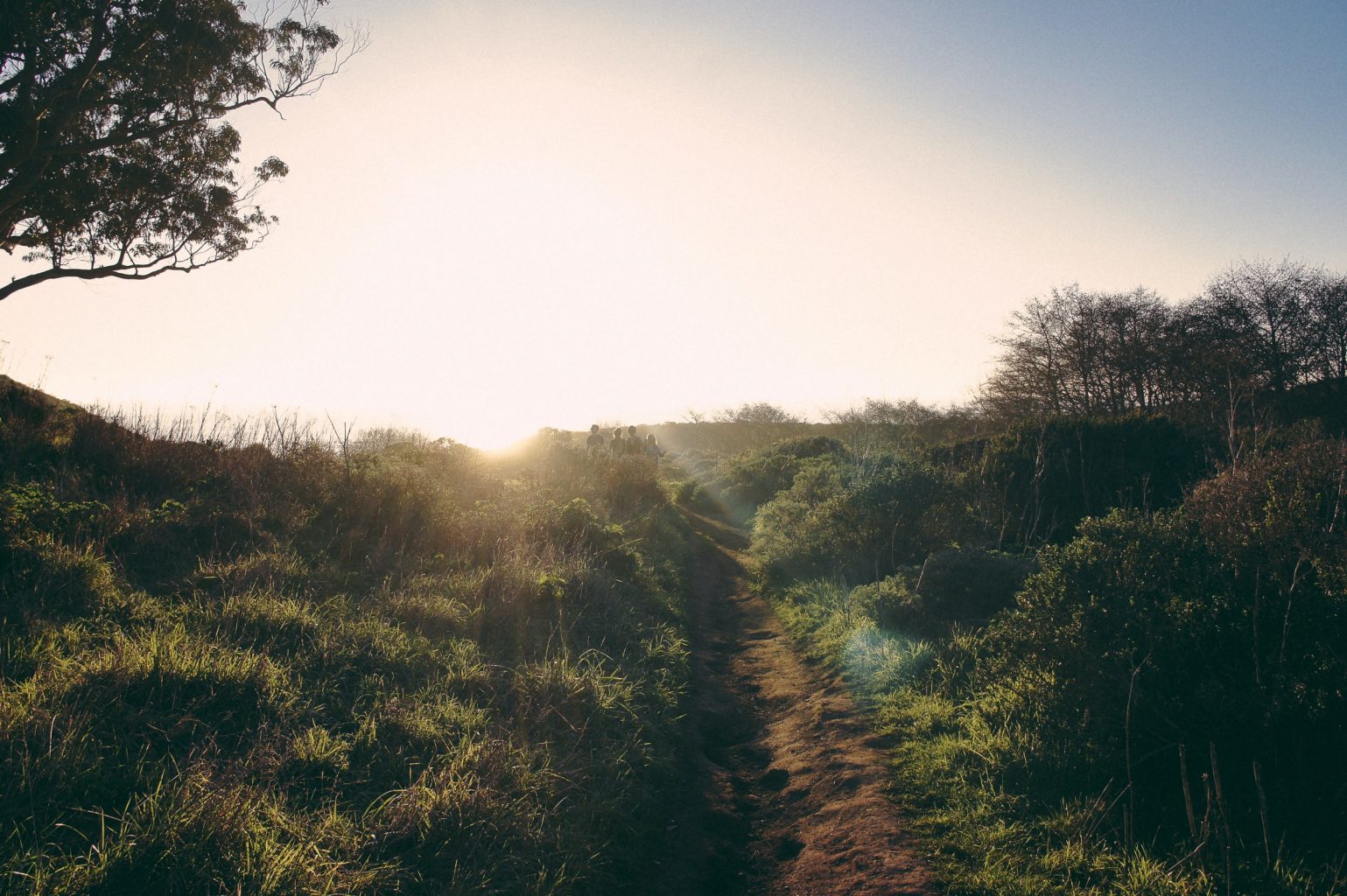
I’ve lived in St. Paul, Minnesota for more than two decades. St. Paul is a deeply Catholic city, and I live in a parochial space that has a vibrant K12 school, as well as many, many Catholic organizations which have long been active.
The last five years, however, have been a time of great urgency and anguish, as those of us who are white and middle class have finally begun to listen deeply to our neighbors who do not resemble us. The world joined us in that listening in May of 2020, when a video recording of George Floyd being murdered in the city next door to us, by a Minneapolis police officer, was shared around the globe.
That new awareness brought along with it a deep recognition of how blindly we—and here I mean to speak only of my white and middle-class neighbors—how blindly we accepted the dominant stories of a zero-sum world in which racism was only a personal attitude, and justice meant being “color blind.” I share that now, to offer context for the rest of what I want to say here.
Pope Francis wrote in Laudato ‘Si that a key conviction of our faith is that we have: “an awareness that each creature reflects something of God and has a message to convey to us, and the security that Christ has taken unto himself this material world and now, risen, is intimately present to each being, surrounding it with his affection and penetrating it with his light (221)”.
What can it mean to live into that awareness and that light—in all the rich meanings of those words? And how might persons who look white, and thus benefit from racialization, participate deeply in the kind of communion to which our faith witnesses?
I have come to believe that doing so requires being actively involved with learning how to dismantle racism, learning what it means to inhabit an anti-racist stance in the world. I don’t think this is a place I can ever fully come to, a stance that I ever fully achieve, but rather it is something into which I am always growing, always seeking, always yearning towards, always becoming.
Much of the learning I have done in the past decades in this journey has to do with recognizing a few key insights.
First, whether I want to or not, whether I understand this or not, whether I choose to draw on it or not, I live within a world defined by white privilege. That doesn’t mean that various other aspects of who I am might not be challenged or oppressed, but it means that my whiteness prevents me from seeing, from experiencing, much of what my neighbors who do not resemble me, live with in daily ways. Rather than seeking to deny that I participate in racism, I need to stop, take a deep breath, and learn what that means. A really good book that spells this out is Heather McGhee’s Sum of Us: What Racism Costs Everyone and How We Can Prosper Together. While her book was written in the US context, I believe it has resonance for the broader North American continent.
Second, doing this work never ends, and I have grown to understand that as a white person, I have two choices: I can do it imperfectly, or not at all. And so I choose to try, and to realize that I will often fall down, mess up, make mistakes, and need to start again. Here is where my faith is a crucial resource, because I have learned what it means to repent, to seek forgiveness, to accept God’s grace, and to take the next step. There is much to lament about how the Catholic hierarchy has engaged with racism, but there is also much to draw upon—and here the many documents, sermons, hymns, and catechetical resources offer us so much! I start with the work of theologians Fr. Bryan Massengale and Dr. Shawn Copeland, but many dioceses have also put together excellent materials.
Third, this is collective, systemic work. It is never only personal and individual. Here again, my faith sustains me because it invites me to see all of the many ways in which human brokenness—human sin—puts stumbling blocks in my path. Yet it also invites me to see all of the ways in which God has created us in deep interdependence. We are created for each other; we are drawn into relationship. When one hurts, we all hurt. We need to be open to seeing and hearing and feeling that hurt. There is deep wisdom in our tradition, wisdom forged through centuries of pain and anguish, wisdom that invites us into lament, and from lament into remembering whose we are, to whom we belong. We are a communal people, and “re-membering”—putting back together the Body of Christ —that communion means that we can look to collective action, to practices that challenge systemic and structural forms of racism. Humans have created racism, and humans can deconstruct it and live into God’s light.
Fourth, breath matters. I often remind my students that we can live for many days without food, and even a day or two without water, but we cannot live for even 10 minutes without breath. In an era in which “I can’t breathe” resonates not only due to police brutality, but also through a COVID-19 pandemic, and in the midst of climate catastrophe, remembering to breathe, to slow down, to feel God’s love in our lives in the midst of trauma – that is an essential practice. It is also an ancient form of contemplative prayer. Whenever I feel particularly anxious or defensive or even despairing, I stop, I slow down my breath, and I pray this short prayer based on one verse from Psalm 46: “Be still and know that I am God (inhale/exhale slowly), Be still and know that I am (inhale/exhale slowly), Be still and know (inhale/exhale slowly), Be still (inhale/exhale slowly), Be.”
Fifth, and finally (at least for this moment), learning to be anti-racist as a person who looks white means leaning into relationships of accountability. To whom am I looking for leadership? Am I hearing the voices of communities which have been oppressed? One of the glimpses of hope I draw, as a US person, from the Canadian context, is that acknowledging the painful history of residential schools can open up new avenues of relationship and hope. Here in Minnesota we have a Lieutenant Governor who is a member of the White Earth Band of Ojibwe, and she is leading us in the hard work of truth and reconciliation. I draw comfort from the years long work of Canada’s TRC, and I try to live in a posture of learning and humility. I have been startled by how energizing and hope-filled that work can be, even in the midst of the deep pain and anguish to which I need to be present.
I return, now, to the reminder from Pope Francis with which I began, that a key conviction of our faith is: “an awareness that each creature reflects something of God and has a message to convey to us, and the security that Christ has taken unto himself this material world and now, risen, is intimately present to each being, surrounding it with his affection and penetrating it with his light (221)”.
May Christ’s light continue to illumine our anguish, and draw us ever more deeply into God’s love.
Read other InsightOut posts.
Dr. Hilda P. Koster is an Associate Professor of Theology and Director of the Elliott Allen Institute for Theology and Ecology.
Of Heatwaves, Floods and Climate Change—Our Kairos Moment
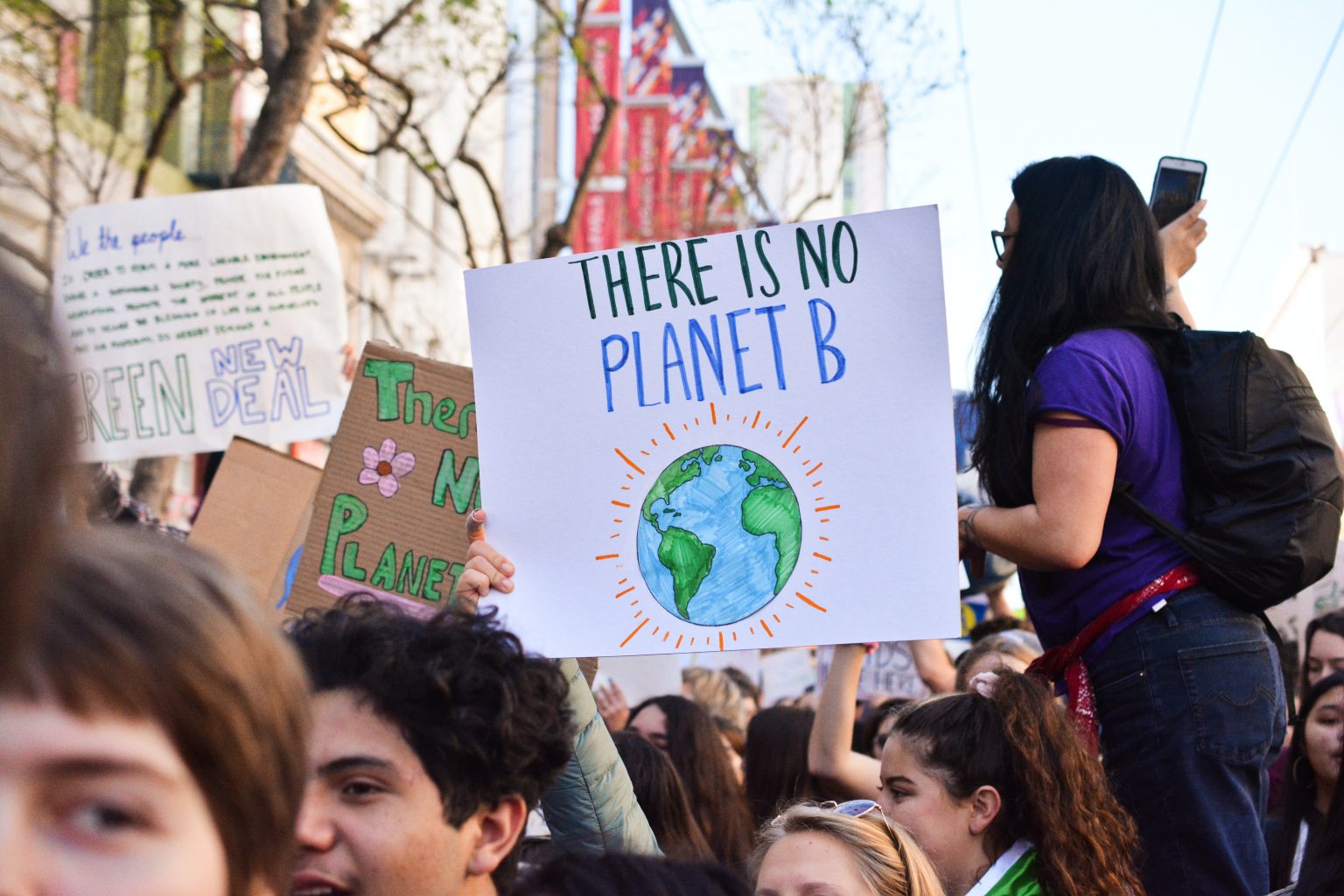
What could have been a summer of cautious optimism about life post COVID-19 has unfortunately become a summer filled with climate change-related horrors. Wildfires due to the record-breaking temperatures and a prolonged drought in the Pacific Northwest took human life and destroyed homes. It also ravaged thousands of acres of forest and seriously endangered marine wildlife. In Northern Europe, including in my native country, The Netherlands, torrential rains caused unprecedented flooding and mudslides. In South Madagascar, off the coast of East Africa, the worst drought in four decades is driving more than a million people into famine.
While the connection between climate and weather is complex, climate scientists agree that the heat waves and rains of this past summer are clearly linked to anthropogenic changes to the climate. What has scientists alarmed, however, is not that there is a connection between extreme weather events and climate change but that these events have been so severe and prolonged. Harvard environmental policy professor John Holdren, who served as senior adviser to former U.S. President Barack Obama, observes that “[e]verything we worried about is happening, and it is all happening at the high end of projections, even faster than the previous most pessimistic estimates.” (Los Angeles Times, July 21). The world truly is running out of time and many people seem to sense this.
The Ecumenical Patriarch Bartholomew has called the climate crisis a Kairos moment for our churches and the world: “For the human race as a whole there is now a Kairos, a decisive time in our relationship with God’s creation. We will either act in time to protect life on earth from the worst consequence of human folly, or we will fail to act.” (Closing Address to Symposium on the Arctic, 2007). The Greek word Kairos means the right or opportune moment. From a theological perspective Kairos indicates that time takes on a holy urgency. Time is no longer simply linear time, stretching open towards the future. Instead, it becomes critical to act. Calling climate change a Kairos moment thus marks the present as a moment of truth and opportunity; a moment where our collective response will have far-reaching consequences.
This fall the eyes of the world are on the 26th UN Climate Change conference in Glasgow (Scotland). COP26 is meeting with the urgent task to implement the climate commitments of the 2015 Paris Climate Accord, which seek to limit the increase of the planet’s temperature to 1.5 degrees Celsius. The question before us then is whether the world community (especially the world’s wealthiest nations) can seize the moment of pandemic recovery as an opportunity to enact the necessary climate policies. For if we fail to grasp this moment and do in fact return to pre-pandemic rates of fossil fuel emission the world could be 1.5̊ Celsius hotter than it was prior to the industrial revolution as soon as 2030 and on track for much higher temperatures.
It is tempting to be skeptical about international climate conferences. After all, the world has passed many climate thresholds since the first UN climate conference in 1992. Climate change, however, is not just a political challenge; it is also a theological and spiritual one. In fact, our response to climate change touches upon the very core of Christian witness. For according to the Biblical tradition, God did not just create the world but also called it good. The Hebrew word for good, tov, means more than “good.” It implies a goodness that is life furthering, a life-generating capacity. Human induced climate change does not just go against this life-furthering capacity but is also undoing it. For those of us living in climate privileged communities, despair, resignation, or indifference are therefore not an option. Instead, we are called, in Pope Francis’ words, to an ecological conversion —that is, a change of heart in the way we look at, interact with, and behave towards the more-than human world with which we are entangled and on which we depend.
Kairos language keeps open the possibility of such an ecological conversion. It is stubbornly hopeful. In the Book of Revelation, John of Patmos sketches doomsday scenarios that eerily resemble those of our day. Yet with all its woes, Revelation does not foreclose the possibility of repentance (metanoia) and turning around. According to the New Testament scholar and eco-theologian Barbara Rossing, the catastrophes depicted by John are neither willed by God nor follow a cosmic destiny. In Revelation, God laments the state of the earth yet places the Christian community at an ethical crossroad (a Kairos moment) where it needs to choose between the polluting, death-dealing powers of Rome/Babylon or God’s New Jerusalem. While time is of the essence, John holds out the hope that the world will listen to the witnesses he so powerfully invokes towards the end of his book. It is significant, too, that Revelation ends with an attractive vision of the tree of life. There is no return to Eden, but there is a vision of what is possible. A vision rooted in the beauty and resilience of planetary life and in practices of an alternative political ecology, symbolized by the city-garden.
Many have heeded Pope Francis’ call for an ecological conversion. This September several religious communities and interfaith groups are embarking on a pilgrimage to COP26. They are visionary witnesses. Those of us outside the United Kingdom and Scotland are invited to add our own witness by walking to a special place or spot near us, posting our pictures and messages #Walkingtheland2021. Our messages will be collected and shared with delegates at COP26. In a time such as this, a time in which the world is running out of time, I invite all of you to participate in the Walking the Land project at https://www.pilgrimagefornature.com/walking-the-land and add your voice, dreams and hopes for our life together on this fragile planet.
Read other InsightOut posts.
Dr. Cynthia Cameron is the newly appointed Keenan Chair of Religious Education and Assistant Professor of Religious Education in the Faculty of Theology. Prior to coming to St. Mike’s, she taught undergraduate students at Rivier University and graduate students at Boston College and Loyola University New Orleans. Her research focuses on adolescence, particularly female adolescence, and the history and mission of Catholic schools.
Pandemic Safety and the Classroom

“I don’t want to see my students as threats.”
This was the anguished comment from a Catholic high school theology teacher in a graduate religious education course last summer, in the midst of the COVID-19 pandemic. We were discussing the challenges and opportunities presented by teaching during the pandemic and, in particular, the possibility of Catholic high schools returning to face-to-face instruction in the fall of 2021. This student’s entreaty struck a chord with the class.
On some level, this reflects a common problem in schools. The busyness of planning for in-person teaching leads to a tendency to treat students as pieces in a complex puzzle. The task for educators is to figure out how to arrange the pieces so that students can be in classrooms efficiently and, now, safely. A rather de-humanizing perspective on the young people in our classrooms.
But, more importantly, these teachers were reflecting on how the push to in-person instruction— often decided on without much input from the teachers themselves—made them feel unsafe. The students, as potential carriers of the coronavirus, were threats to the physical safety of teachers. At this point in the pandemic, at least in the United States, it seemed that children and adolescents contracted the virus at lower rates and tended to suffer milder cases of COVID when infected. Which was, of course, good news. However, teachers are adults and, as such, were at greater risk from the virus. And, teachers were being asked to take on this significant risk in order to teach in a face-to-face environment. All over the US, some teachers decided the risk was too great, that their students were a threat, and some even left their jobs.
For the students in my class—all dedicated, but relatively novice, Catholic high school teachers—this led to a fascinating conversation about how we think about, talk about, and treat the adolescent students in our classrooms in a time of pandemic. What happens when we think about our students as threats? How can this not change the ways that we relate to them? And how can Catholic theological anthropology guide us in resisting this kind of thinking?
Theological anthropology is the branch of theology that wonders about what it means to be a human person created by God and in relationship with God and others. This is where the Church reflects on the meaning of our humanity. The two doctrines that most often come up in contemporary Catholic theological anthropology are that we are created in God’s image and that God took on human form in the person of Jesus. The first of these doctrines—that we are created in God’s image (Genesis 2:26-27)—suggests to us that there is something about humanity that reflects the reality of the divine, that we are like God in some way, that humans reveal in some small and imperfect way what God might be like. And, importantly, since God created humanity in God’s own image, humanity is fundamentally good. The second doctrine—that God became human in Jesus (John 1:14)—also points to this fundamental goodness in humanity. For God to take on the human condition suggests that God thinks highly enough of the human condition to be concerned for humanity. In Jesus, God is telling us that humanity is taken on by God, loved by God, and saved by God. So, drawing from these two doctrines, we can be comfortable saying that humans are created by God and loved by God and that there is goodness in our humanity.
But humans have historically struggled to act as if we are fundamentally good. We don’t always treat one another and ourselves in ways that reflect our theological commitments to the fundamental goodness of humanity. And, since teachers, even Catholic school teachers, can fall into this trap just as easily as anyone else, I often ask them to reflect on this question: “Are your students basically good or basically bad? Are they good kids who occasionally mess up or are they little monsters who need to be whipped into shape?” How a teacher answers this question reveals a great deal about how they will relate to their students. And, in my experience, the vast majority of teachers view their students as fundamentally good human beings, even when they are difficult or annoying.
But, how is this positive vision of the human person disrupted when the students become unintentional threats to the lives of the teacher? How are we to maintain and live out a conviction that they are fundamentally good if we are afraid of them? Does our conviction that they are fundamentally good mean that we have to ignore the threat that they may pose?
I don’t have any answers for my student or for any of us who found ourselves fearing our fellow human beings and the risk that they posed to us simply by existing alongside of us. On the one hand, the gradual reopening of things that has accompanied increasing vaccination rates in 2021 has started to lessen the need to think of my fellow human beings as a threat to my health and safety. On the other hand, as it has done with so many other issues, the pandemic has revealed to us the ways that we fail to live up to our theological ideals. The fact that we did think of our fellow human beings as threats is a challenge to all of us to think about what it means to love our fellow human beings, who are created by and loved by God, who are fundamentally good.
Read other InsightOut posts.
Colleen Shantz is Associate Professor of New Testament and Christian Origins in the Faculty of Theology and cross-listed to the Department for the Study of Religion, University of Toronto. Her research explores the formation of Christianity in the first three centuries CE and especially the role of affect, ritual, and religious experience in the origins of Christianity. She teaches a course on the foundations of justice in the gospels, which is where she first got to know Michael Iafrate.
Between the Present and the Hoped-for Future: Reflecting on the Life of Michael J. Iafrate

Last week a memorial service was held on campus (and Zoom) for Michael J. Iafrate who died in May of this year. Michael was a doctoral student at the Faculty of Theology, beloved to friends across the continent, a prophetic voice in the Catholic Church, a gifted singer-songwriter, a father, partner, brother, and son.
Such a list of roles may seem pro forma in a reflection on a life, but I muted it—considerably. Let me add just two more characteristics to illustrate: Mike was also a committed Weird Al fan and the lead author of The Telling Takes Us Home (2015), a call to justice that is intimately tied to the work of the Catholic Committee of Appalachia (CCA) where he was Co-Coordinator. Few lives encompass such breadth of passion.
Mike’s death came unexpectedly. He was just 44 and he left behind his three young children and his spouse, Jocelyn Carlson, after being diagnosed with leukemia about 6 months earlier. But his death violated expectations in another way, simply by being so out of sync with the size and vitality of his life and the work of justice ahead of him. His work with CCA regularly engaged coal mining in West Virginia, especially its effects on the dignity of labourers, care for the environment, and attention to the poor and vulnerable. You may recognize these three themes as central to Catholic Social Teaching. Mike gave urgent voice to their intersecting effects for the people of West Virginia.
Perhaps without realizing it, I think that many of us who knew Mike had invested in the future of his work for justice. Every day that he took up those causes—sometimes in the face of significant opposition—he helped me, among others, to hope that better conditions were possible. When we saw him pursuing justice, we saw a bridge between things as they are now and the world as it should be. Often, we fallible humans don’t realize we’ve been depending on such links between reality and hope until our expectations are violated.
Of course, Mike’s death also came in the middle of an even larger set of meaning violations: a pandemic, for goodness’s sake; a more urgent awareness of the pervasiveness of racism; and here, in Canada, the devastating proof of genocide and the failure of episcopal leadership to respond meaningfully. Many of the links between our values and expectations, and the realities of the world have been fractured during these past months. To borrow an image from Romans 8, the earth itself groans with grief for the children who were harmed as it groans in the degradation of strip mining.
In fact, that section of Romans was one of the readings from the memorial service for Michael. In Romans 8:18-27, Paul talks about the whole of creation groaning as it waits for liberation: “Even we—who have the first harvest of the spirit—even we groan within ourselves longing for our adoption, the liberation of our bodies. …However, hope that is seen is not hope—for who hopes for what they already see?”
To the degree that Catholic universities are formed by principles of Catholic Social Teaching, they can also generate such bridges between the present disorder and what we only hope for. When we foster attention to human dignity, for example, not only in what we teach but how we teach it, we better prepare people to create the pathways between the present moment and the liberation for which the world is aching. I give thanks for the way our brother Michael Iafrate lived into that vision in his particular, powerful, complex, too-short life. May many more like him be nurtured through relevant and hopeful education.
Read other InsightOut posts.
Dr. Darren Dias teaches in St. Michael’s Faculty of Theology, specializing in Trinity, Religious Diversity, and teaching methods. He is currently working of a SSHRC funded project with colleagues Gilles Routhier (Laval) and Michael Attridge (St Michael’s) entitled: “One Canada, Two Catholicisms: Divergent Evolutions in the Catholic Church in Quebec And Ontario, 1965–1985.”
Burning up Privilege
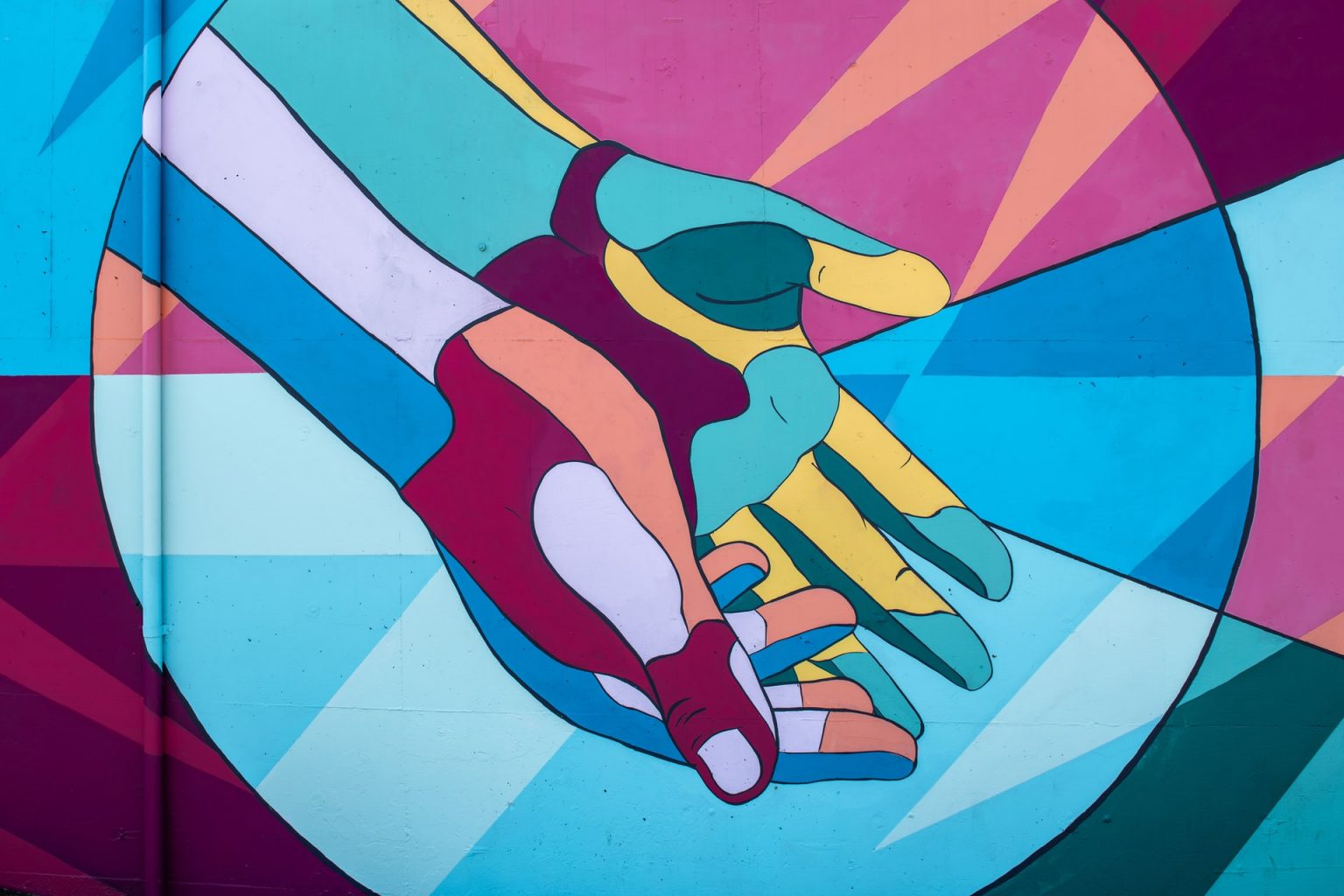
On May 10 the University of St. Michael’s College hosted a colloquium on the role of the Catholic university in the 21st Century. A statement was made by one of my co-panelists and colleagues that “racists should be welcome here [St. Mike’s] in love and in truth.” If the statement itself was surprising, perhaps the silence with which it was met was even more so. Not one participant, me included, no one from among the faculty, staff, or leadership challenged that statement.
Perhaps there were reasons for not responding. Zoom is not the most conducive medium to discuss difficult topics. It’s likely that some people were simply not paying attention behind their faceless Zoom screens. People may not have wanted to draw attention to a remark that might have drawn us away from what they thought were more important foci of the colloquium. Or else there may still be a certain amount of discomfort talking about issues such as racism, sexism, homophobia, etc., even in an open academic forum, whether on Zoom or in person. But as the days passed after the colloquium, I thought about what the statement “racists should be welcome here in love and in truth” and the idea that a “discussion group for racists” could be established at St. Mike’s sounded like for the few racialized students and staff participating in the colloquium. And then I thought about the effects of our silence. Increasingly, I felt that not saying anything was irresponsible of me.
As astounding as it might seem in 2021, to my knowledge, I am the only racialized member of the teaching faculty at St. Mike’s. As such, it is has become both my privilege and responsibility to speak to racism and to try to advocate for those who are underrepresented in the academy whenever I can. My seemingly broken record interventions are authentically welcomed by my colleagues. There is no small amount of irony that I do what is expected of me, performing my own racialized identity in my interventions. A few years ago, my then only female colleague in my faculty and I lamented the conventional roles we played in faculty meetings and discussions. She found herself gently but firmly drawing our attention to sexist language and micro-aggressions as though this had become her responsibility instead of a shared responsibility of all community members. Maybe that’s why I didn’t say anything at the time; maybe I hoped someone else would.
If indeed silence is consent, then such statements should not be met with silence. The statement “racists should be welcome here in love and in truth” is provocative and merits response, especially for the sake of the few racialized participants in that colloquium as much as for the wider St. Mike’s community. I’d like to now say what I should have said then: racists should not be welcome at St. Mike’s.
A Catholic university is not a parish, or pious association, or a catechetical institute. Like any university, it is a place for serious, critical, and rigorous academic dialogue and debate. These dialogues and debates are based on accepted facts and not opinions. Racist beliefs and theories are predicated on theories of white supremacy. While these theories may have been taken seriously many years ago in disciplines like phrenology, biology, philosophy, and theology, they have since been debunked based on evidence (or lack thereof) and uncovered for what they truly are. No academic discipline holds even a remote possibility that theories of white supremacy are true or worthy of debate. Further, they are not only false but exceedingly dangerous. Having a discussion group for racists would be akin to inviting people who contend that the earth is flat to an academic discussion with members of the astronomy department or asking biologists to debate the merits of spontaneous generation.
The idea that racists should be welcomed or a discussion group for racists be established on campus seems to be predicated on the questionable claim that catholicity means a Derridean form of “pure” or “absolute” hospitality. Absolute hospitality “welcomes whomever or whatever arrives, without calculation or limit, without concern for self-protection… [it] entails the surrender of one’s home, one’s identity, even one’s life.”[1] This contrasts “conditional” hospitality as the gracious and willing “reception of a guest into safe and friendly space.”[2] All hospitality, in reality and practise, is conditional with “thresholds of possibility, limits and conditions that allow hospitality to be what it is.”[3]
For St. Benedict, all guests, strangers and pilgrims, should be welcomed as if they were potentially Christ. Chapter 53 of the Rule of St. Benedict instructs the monks, however, that before the stranger can be welcomed into the community, the superior and brothers must first meet the stranger in charity and pray together for peace, before exchanging the kiss of peace (the sign of welcome). The wise and prudent Benedict warns his monks that the kiss of peace should not be exchanged until it can be established that the stranger brings peace and not “the devil’s deceptions” into the community. Even for Western Christianity’s great proponent of welcome, hospitality has its limits when it poses a threat to the wellbeing of the community. Racism is not just a bad idea but an embodied practice that threatens the psychic, psychological, spiritual, and physical well-being of members of the university community. Racialized members already find themselves at risk in so many ways outside of the aspirational safe and friendly space of the Catholic university. Thus, racists should not be welcome into the space of the Catholic university.
One of my colleagues once offhandedly used the term “burning up privilege.” It has stuck with me ever since. He was referring to ways in which he used up his own acknowledged privilege as a white male university professor to empower others—something he does intentionally and regularly. We “burn up” the privilege that we have not earned to draw others into safe and friendly spaces for exchange, rigorous and critical debate. I think this is what a popular rabbi and itinerant preacher from Nazareth did about 2,000 years ago when he “burned up” his privilege to touch lepers, allowed himself to be touched by prostitutes, ate with sinners and tax collectors, and spoke publicly against religious and social structures that dehumanized. He burned up his privilege, sharing it with those without in order to empower them. Eventually he burned it all up. And we know where that got him. No one was willing to burn up their privilege for him: neither his elite followers nor his most intimate friends would speak up for him. In fact, they denied him into silence. He threw his lot in with the likes of Colten Boushie, Alana Cardinal, Breonna Taylor, Joyce Echaquan and the countless other victims of racism today.
[1] Jessica Wrobleski, The Limits of Hospitality (Collegeville: Liturgical Press, 2012) 22.
[2] Wrobleski, xi.
[3] Wrobleski, xi.
Read other InsightOut posts.
Part of the communications team, Catherine Mulroney studied English and Medieval Studies at St. Mike’s and returned recently to complete an M Div at the Faculty of Theology.
A Shot in the Arm

“Love hurts,” the old song says. But a little short-term pain for long-term gain is always worth it—and especially in these unusual times.
A few days ago, I joined the millions of Canadians now vaccinated. I got a shot of Pfizer and, in the spirit of full disclosure, it didn’t really hurt at all, but for a little site tenderness that lasted all of 18 hours.
My injection moment made me want to recreate Rocky’s famous run up the steps of the Philadelphia Museum of Art, or Braveheart’s freedom speech, or Gene’s Kelly’s iconic “Singin’ in the Rain” dance because had been so long in coming and meant so much.
In truth, though, the only thing I did do was get a little teary-eyed because taking 20 minutes out of my day meant I was now one step closer to seeing my children again, a little bit closer to getting back to my real office, and I could now say I was helping in my own small way to end the nightmare we’ve all been living for more than a year. I think I’d forgotten what a pleasant sensation relief can be.
I’m happy to say that my employer, the University of St. Michael’s College, has been supportive as vaccinations have been rolled out, encouraging staff and faculty to get a shot, and offering time off to attend vaccine clinic appointments. It’s a mindset that brings our 180 strategic plan alive for me.
In these days of the coronavirus, I am reminded that the 180 is not just a statement to hang on the wall but a reflection of a lived attitude. The references to such things as concern for the common good, the need to recognize the dignity of all, and our need to care for all creation actually mean something to all of us. Challenging times are bringing that to light. I see this in the professors’ concern for students’ wellbeing, and their understanding that, these days, support and encouragement trumps deadlines. I see it in the student life staff and volunteers’ outreach to students, ensuring they know about extra funding available during COVID or offering reminders to take a break and engage in self-care, informing students of how they can get extra emotional support if needed. And I see it in email traffic and Zoom calls where we are all beginning to realize, via expressions of longing to be together again, that we might all be a little closer than just colleagues.
Daily, I watch the very lessons lived out on campus that I learned in ethics classes while studying theology at St. Mike’s, or while reading the classics here as an undergrad. Life is beautiful and precious and we are called to do our best not only to respect and protect it, but to celebrate it, too. To me, that lesson includes getting a shot—for myself and for my neighbours. We are to live out the now oft-used phrase that we are all in this together. I’m proud to be an alumna—and an employee—of a workplace that practises what it preaches.
As strong as all these motivations are, though, my primary impetus for getting a shot was to ease my kids’ worries. Their dad died a week before the pandemic lockdown began, and the early warnings about the severity of COVID had them stressed about their mother’s health.
“We’ve just had one parent die. We don’t want to lose the other,” said the oldest, soon after the pandemic began, speaking as the now-elder statesman in his usual blunt fashion.
For the following six weeks, I only went as far as our garden, guiltily answering the door on occasions, but mostly watching the world pass by from our front window.
But then, early May dawned, and with it, my first solitary wedding anniversary. I felt an overwhelming desire to visit the garden centre and buy some plants, something that Mike and I had done in May for as long in as we’d been homeowners.
I can’t say it was a fun trip, as it was laden with guilt: guilt for co-opting my youngest into accompanying me on my covert operation, and guilt that I was contravening a heartfelt request from my children. On an up note, though, I felt 17 again, because it reminded me of being in high school and bending a few of my parents’ rules—just slightly, of course.
I monitored dropping age limits and expanding availability and leapt when my chance came. It took close to an hour on hold with the Ministry of Health to book an appointment, and the poor woman who answered my call had a wailing child in the background, but it was all worth it.
My kids put on a brave face at all times for their mother but I know they were relieved. I was just happy I could do something that would ease some of the pile of worries each of them has these days. Then attention shifted to when they could be vaccinated, too, jealous that Molly, the child living in Florida for the year, has already had both doses of Moderna.
This has been an extended period of loss for all of us. Some of the those losses, of course, are trivial—the inability to hit the links, or the discovery that not being able to go to the hairdresser’s means saying goodbye to a preferred hair colour.
And some, of course, are profound. I don’t know anyone who hasn’t lost a friend or relative in the past year, including some to COVID, with their grief compounded by the inability to say a proper goodbye.
That’s why the vaccine, along with continuing measures such as masking and social distancing, remain so important. A shot in your arm is a shot in the arm for all of us. Take one for the team.
Read other InsightOut posts.
Fr. Gustave Noel Ineza, OP, is a doctoral student at St. Michael’s Faculty of Theology. Born and raised in Rwanda, he lived through the 1994 genocide against the Tutsi and went into exile for a month in what was then Zaire. His family left the refugee camps and returned to Rwanda after three members of his family developed cholera. He studied in the minor seminary and joined the Dominican Order in 2002. He studied Philosophy in Burundi, and Theology in South Africa (SJTI/Pietermaritzburg) and the UK (Blackfriars/Oxford). Ordained in 2014, he worked for Domuni (www.domuni.eu) and was a chaplain to university and high school students. In 2018, he came to Canada to pursue studies in Christian-Muslim dialogue. He is currently reading on post-colonial approaches to the taxonomies assigned to religious traditions (Muslims and Christians) by colonial powers in Rwanda.
Do We Need Someone to Die to Remind Us that Black Lives Matter?
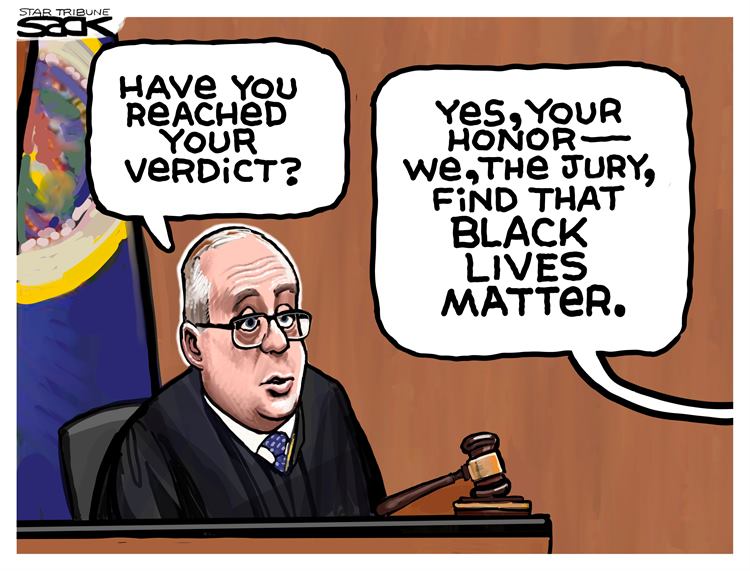
Black lives matter! That was more or less the verdict, 11 months after the brutal killing of George Floyd by Officer Derek Michael Chauvin, and 43-day-long traumatic trial. Twenty-nine years and a month after the trial of four police officers who savagely beat Rodney King, the fear of an acquittal gripped American society used to police officers’ trials ending with disappointing verdicts and acquittals.
The trial finished ahead of the U.S. Senate vote on a bill on April 21, 2021 to combat anti-Asian American hate crimes. Racial tensions have spiked in the United States, tensions that followed the empowerment of white supremacists, a reality which reached a peak with the Unite the Right rally in Charlottesville, a gathering of racist groups that envied the 1930s Reichsparteitage or Nuremberg Rallies.
Four years prior to George Floyd’s murder, a 24-year old Malian-Frenchman, Adama Traoré, died, on his birthday, in police custody, after he was brutalized by French police. Since Traoré’s death, a huge debate has begun in France. Universalist leftist thinkers were scared that rhetoric that generalizes about police brutality might hinder the “Republic,” a chimeric ideal of French unity that assumes all French citizens are equal and equitably treated by the law. Realist activists, often represented by a courageous woman named Rokhaya Diallo, never stop warning the French that there is a risk of considering the American police brutality as something particular to America, because it is widespread in many European cities. Diallo, who seems to carry alone the Black Lives Matter movement on her shoulders, has become the black sheep of a denialist French media because of her positions. The French President’s attacks on “American” Postcolonial movements, “a catch-all term covering everything from anti-colonial thought to critical race theory, intersectional theory to Black Lives Matter,” highlight the persistent denial of oppression towards racialized minorities in many former colonial European powers. Protests to bring to justice Traoré’s murderers were met with brutal police reactions. France is deeply immersed in denial of its racist colonial past, which lives on in its treatment of racialized minorities.
Indeed, change may take several decades to come, even in the United States. After the verdict was announced, the U.S. Representative for New York’s 14th congressional district, Alexandria Ocasio-Cortez, wrote on her Facebook page: “That a family had to lose a son, brother, and father; that a teenage girl had to film and post a murder; that millions across the country had to organize and march just for George Floyd to be seen and valued is not justice. And this verdict is not a substitute for policy change.” Former U.S. President Barack Obama wrote that “true justice requires that we come to terms with the fact that Black Americans are treated differently, every day [and] millions of our friends, family, and fellow citizens live in fear that their next encounter with law enforcement could be their last.” Obama added: “While [the] verdict may have been a necessary step on the road to progress, it was far from a sufficient one. We cannot rest. We will need to follow through with the concrete reforms that will reduce and ultimately eliminate racial bias in our criminal justice system. We will need to redouble efforts to expand economic opportunity for those communities that have been too long marginalized.”
Japanese Tennis player Naomi Osaka, who grew up and lives in the U.S., tweeted these very heartbreaking words: “I was going to make a celebratory tweet but then I was hit with sadness because we are celebrating something that is clear as day. The fact that so many injustices occurred to make us hold our breath toward this outcome is really telling.” In other words, no reasonable person believes that the verdict on Chauvin’s crimes signifies the end of police brutality to Black people. It becomes even harder when some influential TV hosts, like Fox News’ Greg Gutfeld, made it clear they believe Chauvin may not be guilty. Gutfeld stated that the only reason he would want the verdict to incriminate Chauvin is because his neighborhood was looted last summer.
The whole idea of looking at Black people as a threat has been used to justify the discriminatory policing of Black neighbourhoods and unreasonable stop-and-frisks of Black people by law enforcement in the U.S. One highlight of the trial occurred when one of the prosecutors, Steven Schleicher, explained the difference between a threat and a risk. That some insecure white law enforcement agents, empowered by systemic racism in their institutions, might be inhabited by an unreasonable fear of black people transforms Black people neither into threats nor risks. That Brooklyn Center Police Officer Kim Potter, while training a rookie, had to pull a gun on Daunte Demetrius Wright for an outstanding driving ticket explains what may go on in the routine training of American police officers. The fact that she screamed “taser, taser, taser” while shooting him with a gun is also confusing. My training officer in my military service forgot to tell me about the usefulness of screaming “gun, gun, gun” while I am shooting at the target! The most surprising thing is the many peaceful arrests of white mass shooting perpetrators, such as Kyle Rittenhouse and Dylann Roof, which proves that police officers are trained in how to de-escalate tensions, even with highly dangerous individuals. Apparently, that training does not equally apply to people of colour.
One of the most racist whataboutisms on police criminal treatment of Black people in the U.S. is the objection phrased in these words: “What about Black-on-Black crime?” Black-on-Black crime is punished, sometimes beyond the realms of reasonable corrections. In almost all instances when police are accused of the summary execution of Black people, judicial institutions focus on police training guidelines. The fact that Black lives matter is not news to Black people. Black people who take other Black peoples’ lives know they committed a crime and that they would be seriously punished if caught.
The verdict in Chauvin’s trial does not end anti-Black racism. Orchestrated attacks on Colin Kaepernick’s knee may have ended but it will still take years before Black people start feeling safe anywhere around the police. I still get followed by the police in some liquor stores. When I am, I still have the luxury to bother them with words like: “Oh! Because you are here, can you help me find a Coudoulet de Beaucastel Côtes du Rhône Blanc and a Philippe Colin Chassagne-Montrachet, please?”—in a very French accent. However, most Black people are extremely bothered by their presence. An African American friend advised me to never ask them to fetch me a lemonade.
I think the Church must be careful in these times. When people marched against police brutality following George Floyd’s killing on June 1st, 2020, President Donald J. Trump ordered the peaceful dispersal of the crowds protesting near the White House so that he might stage a photo-op before St. John’s Episcopal Church. In a brilliant article for The Atlantic, Garrett Epps, Professor of Constitutional Law at the University of Baltimore, called it “Trump’s Tiananmen moment.” However, the most alarming aspect is that President Trump chose to violate American citizens’ First Amendment rights so that he could take a picture in front of a church, holding a Bible. The following day, President Trump and first lady Melania Trump visited the Saint John Paul II National Shrine in Washington. While many religious leaders condemned the photo ops, Trump still managed to sow discord among Christians—those who thought his attitude toward protests against police brutality was godly versus those who were disgusted.
Many police departments have Christian chaplains, and law enforcement agents are members of our parishes. Just as Church leaders in the past transformed the pulpit as a place to theologically defend civil rights, it is a Christian duty that it become clear to all the faithful that to God, Black lives matter.
Read other InsightOut posts.
Fr. Gustave Noel Ineza, OP, is a doctoral student at St. Michael’s Faculty of Theology. Born and raised in Rwanda, he lived through the 1994 genocide against the Tutsi and went into exile for a month in what was then Zaire. His family left the refugee camps and returned to Rwanda after three members of his family developed cholera. He studied in the minor seminary and joined the Dominican Order in 2002. He studied Philosophy in Burundi, and Theology in South Africa (SJTI/Pietermaritzburg) and the UK (Blackfriars/Oxford). Ordained in 2014, he worked for Domuni (www.domuni.eu) and was a chaplain to university and high school students. In 2018, he came to Canada to pursue studies in Christian-Muslim dialogue. He is currently reading on post-colonial approaches to the taxonomies assigned to religious traditions (Muslims and Christians) by colonial powers in Rwanda.
The Other Sister
The COVID-19 pandemic has taught many to value more highly essential workers who are usually underpaid after long hours of vital work. Nurses are among the most praised as they daily risk contracting the virus while trying to offer a treatment to the sick. It is not the first time that nurses, women in particular, have risked their lives to save other people’s lives during pandemics. Several pandemics affected the pre-modern world. Some of those who offered treatment to the sick were non-cloistered women religious whose identities have not been comprehensively studied. These women were part of bigger movements which flourished in the Middle Ages and Early Modern Times.
In September 2020, I joined a team of academics as an assistant researcher to Dr. Alison More. Dr. More is the undergraduate Medieval Studies coordinator and the inaugural holder of the Comper Professorship in Medieval Studies at the University of St. Michael’s College. She works on a joint project with Dr. Isabelle Cochelin (Department of History & Centre for Medieval Studies/UofT), and Dr. Isabel Harvey (Department of Humanistic Studies of the University of Venice Ca’ Foscari). The project is called “The Other Sister” and its focus is “women who pursued forms of religious life outside of the cloister in medieval and early modern western Europe and New France.” The other members of the project are Dr. Angela Carbone (University of Bari Aldo Moro) and Dr. Sylvie Duval (Università Cattolica in Milan), research assistants Laura Moncion, Emma Gabe, and Meghan Lescault (Centre for Medieval Studies or Department of History/UofT), and Camila Justino (USMC Book and Media and Mediaeval Studies).
The women studied are known by many names, including beguines, tertiaries, recluses, oblates, secular canonesses, lay sisters, pizzochere, bizzoche, beatas, and others. Their names and forms of life varied according to location. Our research group organizes thematic meetings which are the main venue for discussing current research, and recent books, chapters in books, articles, both published and forthcoming. As the COVID-19 pandemic has affected people’s movements, presenters invited from different academic institutions around the world working on aspects of the project meet by Zoom each month. Although the situation has made it impossible for people to have actual face-to-face meetings, it has allowed those on different continents to virtually meet.
To date, the group has prepared and successfully conducted five thematic meetings. The first meeting was entitled Women Serving Enclosed Women (held on September 29, 2020), the second was on Working in Premodern Hospitals (October 27, 2020), the third’s theme was Charity, Caregiving and Female Social Roles from the Middle Ages to the Early Modern Period (December 17, 2020), the fourth was on Naming The Other Sister: Tertiary, Lay, or Penitent? (February 8, 2021), and the fifth was held on Medieval and Early Modern Beguines, from Provence to Northern Europe (March 15, 2021). Details about those thematic meetings are found on the group’s blog.
The attendance has recently been reaching about 40 participants, mainly professors, post-docs, and PhD students from around the globe, all interested in the subject. Our discussion inevitably yields new insights which cross the usual temporal and geographic boundaries.
The main group of the ten researchers attached to “The Other Sister” has working meetings where we prepare the rest of our activities: thematic meetings, workshops for larger audiences, a workshop for our members on using ArcGIS Software to create maps of the communities of non-cloistered religious women, the construction and development of a blog, etc. The blog is named “The Other Sister.” It presents an overview of research and has space for recent updates and news of importance or interest to our community of scholars.
On a personal note, with this project I am learning about historical methodologies that do not aim at proving hidden agendas but analytically and objectively examine all possible data. Also, I have gained a new perspective as a student in Christian-Muslim relations. My usual methodology is historical and postcolonial. It investigates silenced and othered voices in my country’s religious identity construction. I have learned much from “The Other Sister.” Apart from the finesse in the communication of the members and the rigour in the historical research with its requirements for accuracy, I have come to appreciate the academic enthusiasm involved in understanding subjects that touch a given identity. I am also interested in understanding the power relationship between identity and those who write history: in our case, the image given to these non-cloistered, lay-religious women by predominantly male and clerical historians.
Our work values the religious zeal of women who were willing to live a life given to the poor, the sick, prayer, and teaching, often in the face of incomprehension and negative judgment from their society and the Church. Some were considered heretics or witches simply for wanting to live this life outside the walls of a cloister. A deconstruction of the meta-narrative on them that at times portrayed them as uncontrollable dangers to the Christian faith aims to restore their proper image. As the Church strives to include women in its decision-making bodies, it will surely be inspired by the findings of “The Other Sister” project, and the genius of the women working on it.
Read other InsightOut posts.
Carla Thomas is a member of the Dominican Sisters of St. Catherine of Siena, based in Trinidad and Tobago, West Indies. She is a national of Guyana, South America, and worked at the Ministry of Foreign Affairs for several years. Carla is passionate about young adult ministry and adult faith formation. She sums up her self-understanding as a Dominican by means of the following bible quote, “But how are they to call on one in whom they have not believed? And how are they to believe in one of whom they have never heard? And how are they to hear without someone to proclaim him? And how are they to proclaim him unless they are sent? As it is written, ‘How beautiful are the feet of those who bring good news!’” (Romans 10:14-15). At present, Carla is involved in parish ministry among Caribbean nationals in Toronto. She is looking forward to gardening again this summer and, hopefully, to visit a few more places in and around Ontario. She is a doctoral student in the Faculty of Theology and is developing a thesis prospectus at the intersection of family theology and ecclesiology.
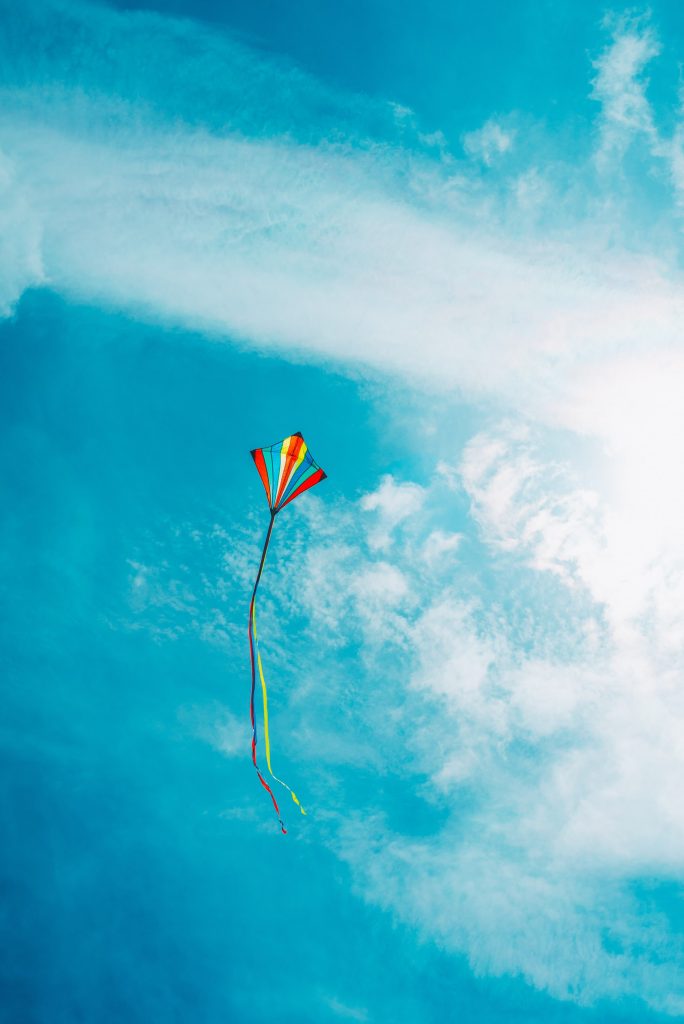
This Is the Day the Lord Has Made
Alleluia! Christ is risen! This is the day the Lord has made; let us rejoice and be glad! Alleluia!
Dear Easter, it is wonderful that you are here again! You are truly one of the best times of the year and I delight in the signs of your presence everywhere. Thank you for bringing your friend, Spring. You began to alert me about two weeks ago that you were just around the corner when I noticed the new life springing up all around. The perennials have begun to emerge promising to bring a feast of color to the front lawn soon and I admit that I have been eagerly keeping an eye on the trees next door looking for the first sign of leaves. In this neighborhood, the children have begun to play on the sidewalk again and some parents have hung Easter eggs on trees. You are welcomed with joy for you bring re-birth, new life, hope and God’s promise of faithful love for the world.
As I reflect on the hope that this season represents two different kinds of events come to mind. First, in my homeland of Guyana, South America, Easter is kite-flying season. It is a national tradition that on Easter Monday families would spend the day outdoors enjoying a picnic and helping children to raise their kites in the air. I consider the sight of hundreds of kites dotting the sky throughout the day to be one of the most beautiful experiences of the Easter season. From an early age I learned to associate this event with the resurrection. Catechists used this local tradition as a symbol to help children understand in faith the biblical testimony that Jesus rose from the dead and that He is truly alive. While Easter is a Christian celebration, kite-flying is for everyone. On Easter Monday, social and political struggles are transcended as communities share in a day of fraternity, friendship and mutual goodwill. This cherished national tradition provides for the people of Guyana a glimpse of the reconciled unity and hope promised by the resurrection of Christ and articulated recently in Pope Francis’ encyclical letter Fratelli Tutti.
The second event is the Holy Saturday liturgy during which the Elect receive the sacraments of Christian initiation. Having served on RCIA teams in parishes in Guyana as well as Trinidad and Tobago, I would say that there is no greater joy that night than witnessing the baptism of new members who were preparing for that moment for at least two years, in most cases. Their faces are usually filled with peace and hope as they look forward to life as Christians. Indeed, the newly-baptised often become much more enthusiastic members of their parish communities than life-long Christians. Their journey as neophytes continues throughout the Easter season as they move into the period of the mystagogia until Pentecost. The RCIA renews parishes. In my case, the recitation of baptismal promises became even more meaningful when made in the presence of new members who were an inspiration for a deeper engagement with the faith. The celebration of the sacrament of baptism is one of the preeminent signs of hope at Easter.
Dear Easter, you beckon Christians to look to the future now, especially as the pandemic comes to an end. For the Catholic Church, it means celebrating to the fullest extent possible over the next year and a half, two very important milestones Pope Francis has asked us to observe. The first is the Year of St. Joseph which began on December 8, 2020. It marks 150 years since he was proclaimed patron of the universal church. The second is the launch of “Amoris Laetitia Year of the Family” on March 19, 2021 to mark the fifth anniversary of the publication of this apostolic exhortation. After a year of sheltering-in-place with family, with all its tension and struggles, joys and delights, it is fitting that our church should celebrate families in their triumphs and accompany them in their challenges. In addition, for persons who had to shelter-in-place without family, ‘Amoris Laetitia Year of the Family’ coincides with the beginning of their ability to be reunited after months of separation. This is cause for celebration. In cases where families lost loved ones and could not gather in their time of grief, the year also coincides with their opportunity to finally meet to comfort each other in community.
The resurrection of Christ is the foundation of Christian hope. No matter what comes next the Easter event is the assurance that ultimately in Christ “all shall be well” (Julian of Norwich). Alleluia!
Happy Easter to all!
Read other InsightOut posts.
Emmaus O’Herlihy is an Irish Benedictine monk of Glenstal Abbey, Ireland. Trained in graphic design, he worked as an Art Director in Los Angeles, U.S.A., after receiving his BDes from National College of Art and Design, Ireland. Currently a doctoral candidate at the Faculty of Theology in the University of St. Michael’s College, Emmaus is exploring ways that liturgical art advance the full, conscious and active participation of the assembly during liturgy.
A Reflection for Good Friday: The Triune God’s Solidarity with Those Who Suffer
The primary ritual action of this Good Friday liturgy is the showing and veneration of the cross. Although everyone here is already familiar with how the cross symbolizes divine purpose, it’s worth remembering how Jesus’ violent and humiliating death by crucifixion posed an enormous challenge for early believers.
Crucifixion was an intentionally brutal and humiliating form of capital punishment in the Roman empire that was administered to rebellious slaves, enemies of the state or leaders of insurrection. Because of this, Robin Margaret Jensen’s study on the significance of the cross in the history of Christianity begins with, what she terms, the ‘Curse of the Cross.’1 She refers to Paul’s first letter to the Corinthians in which he writes that for Jews awaiting a kingly messiah, it was incomprehensible that this messiah would be crucified since crucifixion signalled a cursed death; for Greeks, a crucified god was, to put it simply, ludicrous. Such a death was contrary to logic and scandalous.2
The early Church’s response was to embrace the paradox of Christ’s death; to preach of Christ crucified and proclaim that such a form of death represented both the most intense expression of Jesus’ humility and the clearest indication of his glorious identity.3
Nevertheless, it took almost another three hundred years for images of the crucifixion to become commonplace as the identifying marker of the Christian faith.4 Even today, images of the crucifixion remain challenging—and I don’t mean to suggest those occasions when contemporary artists reinterpret Christian iconography. Images of the crucified Christ engage our imagination, they tease out the significance of the events of Christ’s death: It is not enough to recall that Jesus died but to reflect upon how he died.
In the Pauline epistles, arguably the earliest testimonies to the place of the cross in Christian theology, Paul explains that those who count themselves wise or who seek more positive signs will judge any celebration of the crucifixion to be a kind of madness.5 What’s more, it’s the kind of madness that has multiple sides to it. One side to this madness can be identified in the accompanying image (see illustration). It reflects the theme that the Dominican community in Toronto has chosen for this year’s Triduum: the Triune God’s solidarity with those who suffer, especially those victims of violence.
The image shows an illumination from the 14th century that depicts what would, by the 16th century be termed the Gnadenstuhl motif.6 Translated as Mercy Seat or Throne of Grace, the German term refers to this trinitarian motif to underline the significance of identifying the Trinity as present in the death of Christ. In her study of the Incarnation through an aesthetics of vulnerability, Susie Paulik Babka writes that among those images that attempt to translate difficult and abstract concepts into visual expression, this motif invites Christians to consider that the darkness which accompanies us in times of catastrophic suffering, and especially at the moment of our death is nothing less than “the dwelling place of God.”7
An initial glance at the illustration is enough to show that this motif involves a trinitarian dynamic centred on the passion of Christ. God the Father is usually seated (sometimes on a throne), and supports the dying or dead Christ. The Holy Spirit, represented as a dove, is most often positioned between the Father and the Son. In seating the figure of the Father on a stool or a throne, this motif subtly alludes to Old Testament references to the mercy seat “understood as the point of contact between God and humanity; the locus of divine presence on earth,” …the critical point of mediation between heaven and earth.9
In the composition in this image, symbols of the four evangelists surround the diamond shape within which the Father holds the horizontal beam of the cross onto which Christ’s body is nailed. Whether or not an actual cross is present, “the unifying thread of nearly all the works of art that utilize [this] motif is the theme of unity between heaven and earth in the passion of Jesus…”10
The Holy Spirit, symbolised as a dove in flight, is a “vital part of the composition.”11 Positioned between the Father and the Son, the wings of the dove touch the Father’s lips and the head of Christ, acting as a bridge between the first and second persons of the Trinity. By echoing the shape of the cross, the figure of the dove emphasizes the Spirit’s dwelling with Christ, becoming what Jurgen Moltmann describes as “Christ’s ‘companion in suffering’.”12 Jesus’ experience of catastrophic suffering effects all three divine persons: The “tenderness of the relationship between the Father and the Son,” a bond preserved by the Spirit, “is somehow comforting” even while it reminds us of the suffering of the tortured.13
This image highlights something of both the ordeal of human suffering and the depth of Divine witness to it. Babka writes that “just as heaven and earth join to praise God in the liturgy, … heaven and earth join to mourn the death of the Son in solidarity with all who suffer catastrophically.”14 As an image of God, the ‘highest being,’ the Three in One, the Gnadenstuhl motif subverts any understanding of God as abstracted from our own experiences of isolation or illness, humiliation, brokenness, or pain.15 The cross is “the event in which God takes the absurdity of catastrophic suffering into God’s life and being” ; the triumph of the cross affirms the depth of God’s solidarity with the ordeal of suffering, with all who suffer.16 The “emotionaland theological impact of this image …occurs in an aesthetics of vulnerability” that challenges indifference to the suffering of others.17
By offering us a glimpse of both human frailty and divine grace, this image alerts Christians of the need to maintain a vigilance to the suffering ‘other.’ In venerating the cross, we are not only called to behold Christ in his great act of love and respond with veneration to the symbol of the way he died. When we kiss, bow or genuflect to the cross, we also commit ourselves to seeking Christ in the ‘other’ who suffers. We testify to what this image’s depiction of the Trinitarian presence at the moment of Christ’s death encapsulates: that God becomes incarnate where there is catastrophe; that by fully sharing human suffering in a humiliating death, God invites us to “stake our subjectivity” in the suffering of Christ, of the ‘Other,’ the Christ who suffered and died on the cross two thousand years ago, and the ‘other’ whom we identify as Christ suffering in the present.1 And in this is our hope, because we are ‘followers of Jesus’ whose death on the cross did not end in failure but in Resurrection—the definitive revelation of Jesus as Son of God, the second person of the triune God, and the conclusive reassurance that belief in the risen Jesus correlates with our deepest experiences and our ultimate hope for renewal.
1 Robin M. Jensen, The Cross: History, Art, and Controversy (Massachusetts: Harvard University Press, 2017), 1.
2 Ibid, 4-5. Although Jensen writes that “Paul’s focus on the mode of Christ’s execution emerges most fully in his letter to the Galatians [when he] “acknowledges the fact that Christ’s death on the cross was an obstacle to belief in Jesus as Messiah,” (Gal. 5:11), she adds that “Paul employs the cross in a more metaphorical sense” in 1Cor. 1:19.
3 See, for example, 1 Cor 1:23, where Paul writes “we preach Christ crucified…”
4 See also Jeffrey Spier, Picturing the Bible: The Earliest Christian Art (New Haven: Yale University Press, 2008), 227: “…there is a rarity of depictions of the crucifixion in Early Christian art. The image is entirely absent from the catacombs and sarcophagi in Rome and does not become common until the Byzantine period [during] the late sixth century.”
5 See Justin Martyr and 1 Cor 1:18-25. Also Robin M. Jensen, The Cross: History, Art, and Controversy, (Massachusetts: Harvard University Press, 2017) 1, 5.
6 This illumination is found in the Die Dietsche Doctrinale by Jan van Boendale, c.1374. The word Gnadenstuhl is thought to originate with Martin Luther’s use of the term in his 16th century translations of Exodus (25:21-22) and Hebrews (4:16) which refer to ‘mercy seat.’
7 See Susie Paulik Babka, Through a Dark Field: The Incarnational through an Aesthetics of Vulnerability (Minnesota: Liturgical Press, 2016), 225.
8 The most familiar probably being Masaccio’s Trinity at the Dominican church of Santa Maria Novella in Florence, c.1427.
9 Babka, Through a Dark Field, 207, (who also refers to Ezekiel, Isaiah, Daniel, 204-205).
10 Ibid, 196.
11 Ibid, 204.
12 Ibid.
13 Ibid, 225.
14 Ibid, 196.
15 Ibid, 194.
16 Ibid.
17 Ibid, and 192.
18 Ibid, 225.
Read other InsightOut posts.
Samuel Ojiefo Ejeregbe was born in Nigeria but spent most of his adulthood in the United Kingdom. He holds a First-Class Honours degree in Law from the University of Buckingham, with legal mini pupillages in London and Internship in New Jersey. U.S.A.. He also attended Allen Hall, Archdiocesan Seminary of the Archdiocese of Westminster, London UK, where he was awarded a Diploma in Philosophy from the Pontifical University of Saint Patrick in Maynooth, Ireland. He was awarded a scholarship from the Sir Christopher Ondaatje Scholarship Board for a master’s degree in law as a specialist in Financial Services Law and graduated with Distinction. He is currently studying for the Master of Divinity (M.Div.) degree at the Faculty of Theology in the University of St. Michael’s due for graduation in Fall 2021. He loves playing tennis, cooking and theological discourse.
Readying Ourselves for Palm Sunday

The COVID-19 pandemic, without any shred of doubt, made the annual Lenten observances move so fast due to restrictions in public worship, with many following with online liturgy. Despite a limited number of people—10—allowed to attend public Masses—and with all the restrictions—we have journeyed through Lent with a monastic spirit. Whatever the case, it is certainly a Lent that we will always remember! Perhaps now we can reflect upon all the many and rich symbols that we associate with Holy Week and Easter. So, let us begin by reflecting on the signs of Palm Sunday that would lead us through the Easter Triduum to celebrate the resurrection of our Blessed Lord.
As a teenager, I always braced myself for Palm Sunday prior to Easter celebrations because of the lengthy readings. I got exhausted standing whilst the Narration of the Arrest, Trial, Death, Burial, and Resurrection of Jesus Christ was read, though moving to hear. I quietly wondered why the long narration when we were marking the triumphant entry of Jesus into Jerusalem. I felt it should be called Passion Sunday. The drama group of my local parish, St. Patrick’s Sapele, made it even more special as an adult would ride on a donkey with palms, depicting the triumphant entry of Christ.
What I quickly noticed from Palm Sunday was the very fact that the people who applauded Christ’s entrance into Jerusalem, shouting “Hosanna” and words of adoration, within a week, would be crying, “Crucify Him.” Previously, our Lord had deliberately avoided popular acclaim, even fled, but this, upon entering Jerusalem, he accepts. Seeing him on a donkey, those around him remembered the words of the Prophet Zechariah, “Exult O daughter of Jerusalem, behold your king is coming to you and riding on a donkey” (Zec 9:9-10).
Pope Benedict XVI explained that the prophecy of Zachariah relates to Jesus: He is a king who destroys the weapons of war, a king of peace and simplicity, a king of the poor and he was clearly not building any revolt against Rome. Riding on the borrowed donkey, Jesus made a humble entry into the city of Jerusalem whilst the crowds surged at him and scattered their garments on the floor and waved branches, a poignant moment that foretells that this triumphant hero will be dealt with like a criminal and killed. Palms do have a symbolic gesture, a sign of victory. On Palm Sunday thankfully with the increased numbers for public worship, hopefully we can be able to go out to meet Jesus, carry the blessed palms, joyfully sing out our hosanna and join in his triumphant entry into Jerusalem.
But our joy soon turns to utter sadness as, holding our palms, we hear the narrative of Christ’s passion. We realize, once again, that his triumph, his true victory, will come through the Cross. We know, as Jesus did, how Holy Week will eventually end. We know that joy will turn to sorrow and back to joy. We know that through the sufferings of Christ, followed by his resurrection, good will surely triumph over evil. We know that many today are fatigued and may be going through mental challenges triggered by the continuous lockdown caused by COVID-19 but we are assured that it will not last forever and we shall, God willing, return to normalcy in no distant future and healing to those suffering.
What is customary on Palm Sunday is the opportunity to take our palms home, a subtle reminder of victory, that no matter how long the darkness may last, brightness will come and joy will be overflowing. Let us not forget that it was on the Cross that Christ conquered. So, as we begin Holy Week with Palm Sunday, let us keep our eyes on the Cross; Christ is with us always till the end of time.
Palm Sunday is a robust time to reflect on what Jesus has done for us; it is not just some distant story or something remote from us. It is about what God has done for us; it is about our salvation and our life. We are not just passive spectators, or listeners: all that we recall on Palm Sunday (and during Holy Week and Easter of course) is about what Jesus has done for us. This is such a hopeful message as we continue to try and do our best in this strange and difficult situation that we face at the moment in a pandemic.
The opening address on Palm Sunday Mass expresses this very well: “with all faith and devotion, let us commemorate the Lord’s entry into the city for our salvation, following in his footsteps, so that, being made by his grace partakers of the cross, we may have a share also in his Resurrection and in his life.” Amen.
I wish you, your loved ones and families a Blessed Palm Sunday.
I call you blessed.
Read other InsightOut posts.
In 2020, Sister Penny McDonald celebrated her diamond anniversary of her entrance into the Congregation of the Sisters of St. Joseph of Toronto. After obtaining a BA at St. Michael’s, her main ministry until 1995 was in education, as a secondary school teacher and administrator. Sister Penny realized her need to deepen her theological understanding for her work with students and in the field of vocational discernment, and was awarded a Master of Divinity degree at St. Michael’s Faculty of Theology. In 1995, Sister Penny moved from teaching to volunteering at St. Michael’s Hospital in the HIV clinic. Later, she directed the Drop-In, a place for women who were homeless or under-housed. For the past 14 years, Sister Penny has worked at Providence Healthcare as a volunteer in the Adult Day Program. The joy and satisfaction of serving in one of the original ministries of the Sisters of St. Joseph in Toronto, and of being part of a welcoming community of compassion, hope, and healing, has been source of joy.
“Listen to what life is asking you”
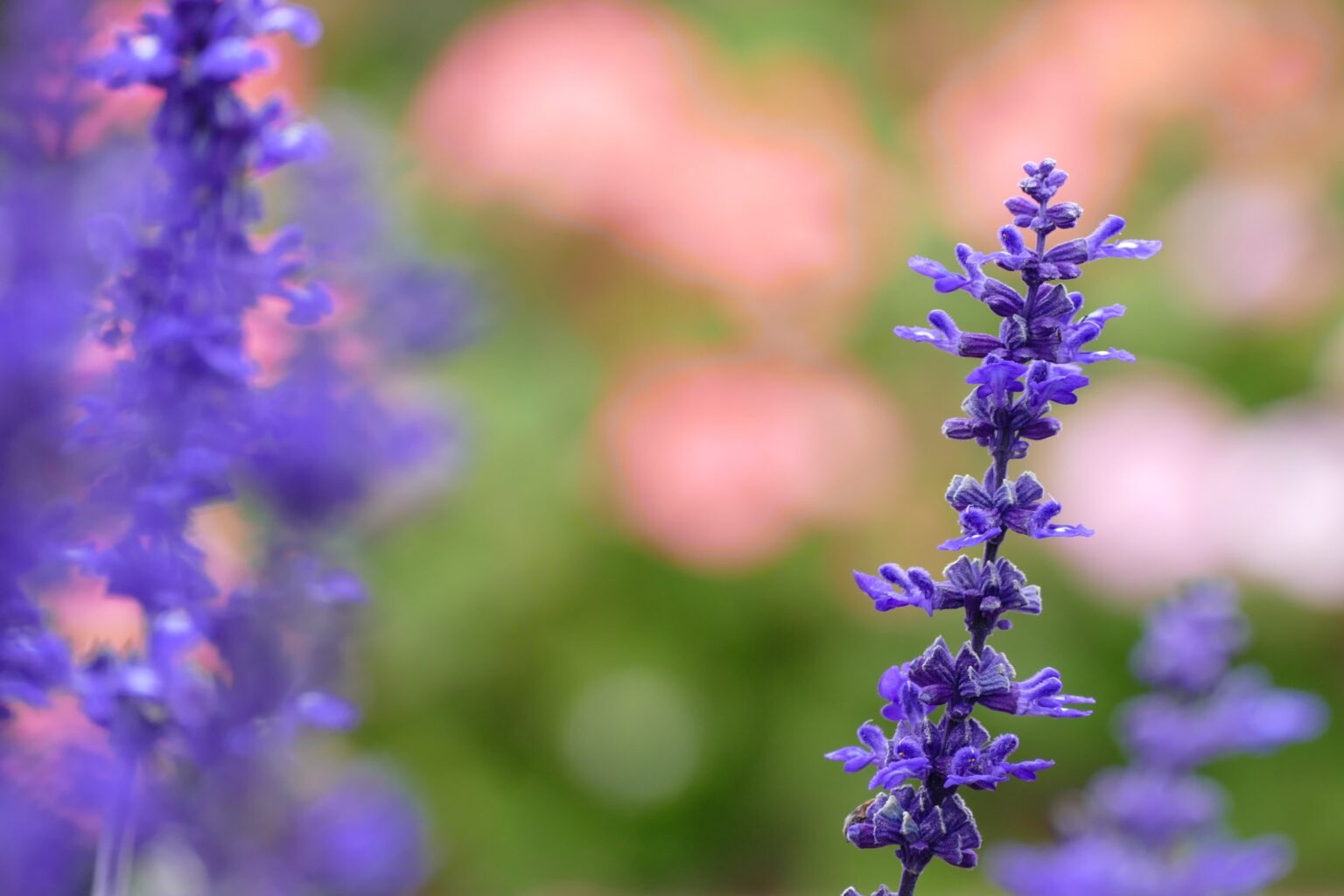
On Thursday March 13, 2020, I returned home from Providence Healthcare, where I have volunteered for 12 years in the Adult Day Programme (ADP), a programme for people who have dementia and are living at home. The following day I received an e-mail informing me that all volunteers were suspended until further notice. When I left Providence Thursday I had no idea that I would not be returning on Tuesday to be with the club members and staff.
I am a Sister of St. Joseph of Toronto, and the Charism of our Community is reconciliation and service of the dear neighbour. It is a challenge for me to accept that loving my neighbour is to stay home, to wash my hands, to wear a mask. In contrast, Our Foundress, Sister Delphine Fontbonne, arrived in Toronto in 1851 with three other Sisters in the midst of the Typhus epidemic and took on the management of an orphanage on Jarvis Street. For these Sisters, loving the dear neighbour meant living with the orphans, establishing schools, planning the House of Providence, which would accommodate hundreds of poor seniors, the sick, and immigrants. Sister Delphine died on February 7, 1856. She had stayed with a woman who was alone and distraught, and she had tended to the sick Sisters in her Community.
Today, of course, I want to be with the club members and staff of the ADP, and I await the day when the COVID-19 pandemic will end. Until such time, in the words of Dr. Ted Dunn, as expressed in his book The Role of Meaning-Making in Transitional Times, I “listen to what life is asking me.” I find purpose and meaning in being aware of the suffering in our world, following the news and world events, entering into committee work carried on with Zoom, sorting and organizing and packing, exercising, praying, gardening, reading, listening to music, crosswording. For this moment in time my life is changed. I believe the change is not forever!
This year our Congregation is celebrating God’s goodness to us for 170 years. It is our prayer that we be healers and show the compassionate face of God to our dear neighbour. March 8 is International Women’s Day and I thank God that I belong to a Community of women—a Community that dates from 1648 in France. I live in the Grace of all the women who spent their lives in service of the dear neighbour without distinction and in fidelity to our call to continue the mission of Jesus “that all may be one”.
Source: Ted Dunn, PhD The Role of Meaning-Making in Transitional Times
Read other InsightOut posts.
The author of our post for Bell Let’s Talk Day 2021, Therese Hassan completed both her undergraduate and graduate degrees at the University of St. Michael’s College. A recent graduate from the Master of Theological Studies program at the Faculty of Theology, she is particularly interested in Catholic philosophy of education, theology of ministry, and qualitative methods in religious studies. Therese is currently a Secondary School teacher with the Dufferin-Peel Catholic District School Board.
Talking About Fight Club to Stay Healthy

I recently assigned my students an adaptation of a “time audit” activity that Jay Shetty offers in his book Think Like a Monk. The premise of the exercise was that what we spend most of our time on essentially reflects what we value most. The idea was for my students to audit their time over five days to identify where most of their time was being spent. My students had to articulate what it is they truly value and whether or not the way they spent their time (especially amid a pandemic) truly reflected what they valued most. For most students, the realization set in that how they spent their time was disproportionate to what they outlined they truly valued.
As I listened to my students’ reflections on their time audit, several patterns emerged. Many of my students identified having valued their mental health but recognized that the way they spent their time did not necessarily foster positive mental health. Many voiced an intention to carve out more time in the day to spend on activities that would benefit their mental health, including less time on social media, more time meditating and praying, and more time being present with family (I know: amazing conclusions, right?). Interestingly, almost all of them felt guilty to some degree about not doing more with their time, considering the time at home the pandemic has granted. On this point, I could relate to my students more than they will ever know.
The truth is that the conclusions my students came to as a result of their time audit are as intuitive as they are appropriate to the unprecedented time we find ourselves in. As their teacher, I am essentially endowed with the responsibility to keep considerate of their mental health, offer information and resources on how to cope and who to talk to, and tips and tools in practicing self-care, all while standing as a pillar of poise, a model of “keeping it together,” a standard of composure even though I too share in the same struggle. It’s like having to prepare my students for a test I’ve never taken myself, in an area I haven’t yet achieved a level of expertise. Put all that against the backdrop of a pandemic, and it feels more like a fight; only it’s a fight I didn’t ever think I’d need to prepare for, let alone be responsible for in preparing others. I’m right there in the ring with everyone else trying to listen to coaching instructions.
Of course, I could never say this out loud. The first rule of fight club is you cannot talk about the fight club. If I talk about my struggle in the fight club, how can anyone find me dependable or reliable? What if I am seen as any less of a Professional? How do I continue to meet the needs of my students, friends, or family members in supporting their mental health while staying afloat myself? How do I talk about self-care amid a pandemic when I’m still trying to figure out a routine that works for me? How do I help the people around me continue to feel connected despite struggling from isolation and confinement myself?
Mental health is something for all of us to be concerned about. One of the most significant personal revelations I ever had on the topic was to learn that mental health and mental illness are not synonymous concepts but rather interconnected concepts that each span their own continuum. This means that not everyone with mental illness has bad mental health, and an absence of mental illness does not necessarily mean good mental health. There’s a line in Amanda Gorman’s poem The Hill We Climb where she talks about the nation before her as not a broken nation, but an unfinished one. Similarly, mental illness or the struggle with mental health doesn’t make us broken, but unfinished, a work in constant progress. Trying to work towards positive mental health is a struggle to be met by everyone at one point or the other. Meeting the expectations of self-care can and probably does feel near impossible with or without a pandemic. For that reason, we are literally all in it together even when we feel completely alone.
Despite it all, I am still trying to do it all. People depend on me. I am sure that many out there are doing the same thing, persisting and persevering because people count on them. If there is one thing I have learned, it is that, for whatever reason, knowing I’m not alone in the ring is a comforting thing. Storytelling is a magical device we have that dates back as far as the human community itself. Testimony and dialogue help us confront some of the harsh realities of the human condition at its deepest level, inviting us into a journey of “meaning-making” as we bear witness to the stories and experiences of those around us. If there is one thing I can say for sure, it’s that we need to feel empowered and empower others by and through witness and storytelling regarding our experiences and struggles with and of mental health. We need to normalize talking about this regardless of rank, position, gender, age, or creed.
They said that the first rule of fight club is to never talk about the fight club. Well, this is our fight club, and mental health is our ring. Whether one is giving or receiving support in dealing with mental health, we’re all in the ring, a human make-up of grace under pressure, each of us hoping that we or the ones we love can and will persevere through each second of every minute of every round. One of my own coaches from the ring often reminds me that, in our fight, we strive not to be perfect but to be balanced; constantly adjusting our footing to be as close to the centre point of love, family, friends, respect and humanity. We may sway, but we adjust, and we never fall completely.
And so, to that I say: screw the rules of fight club. Let’s talk about fight club. Let’s reflect on our own stories deeply and honestly. Let’s share our testimonies and open our hearts to the testimonies of others. In a time characterized by physical and social distance, let our stories and experiences of being inside the ring connect us like never before. Let’s talk not just one day a year but consistently and intentionally, because our lives depend on it.
Read other InsightOut posts.
John Sampson is a fourth-year PhD Student at the University of St. Michael’s College in the University of Toronto. He is writing on the life and thought of the Chinese theologian T.C. Chao. John can be found at home most days, writing his thesis and drinking only the finest cups of hand-crafted coffee.
In Search of Christian Unity: A Chinese Christian Perspective
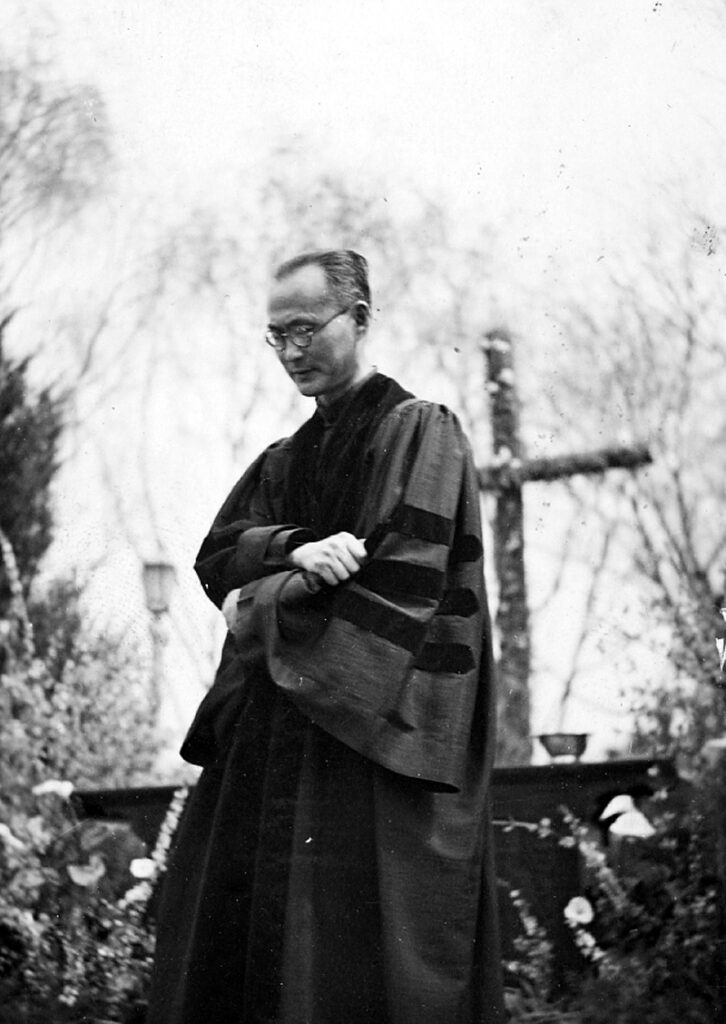
“People must be involved in the work of building up the Church,” wrote T.C. Chao (1888–1979), a famous Chinese Christian theologian and one of the first presidents of the World Council of Churches. “[Christians] do not have the authority to divide arbitrarily, because it is the will of Christ to tear down walls of separation, to split open curtains of division, and create in himself one new person,” he said, alluding to Ephesians 2:14–22. What Chao penned in 1946 has ongoing relevance for Christians around the world today, as we come together during the Week of Prayer for Christian Unity and pray that we may be one “so that the world may believe” (John 17:21). T.C. Chao gave expression to a conviction held by many Christians in the Chinese Republican Era (1912–1949), the period of time when Christianity burst on the scene unlike ever before in China. The conviction was that unity and cooperation were essential if Christianity was to survive, if Christianity was to put down roots in China.
A major obstacle to this pursuit of unity, however, came from the fact that North American and European Christians were trenchantly divided, importing this division into China. Throughout the nineteenth century, foreign mission societies refused to work alongside one another. Catholic and Protestant missionaries remained fixated on their own approaches to Christian faith, on their own doctrinal precepts and ecclesiastical teachings. Protestant denominations produced competing Bible translations and promoted their own translation efforts over and against any other. With few exceptions, Western Christians let divisions that brewed in Europe spill into China, and nurtured these divisions without supplying adequate means for letting a Chinese expression of Christianity take root. This was a deep-seated problem. The desire to preserve Christian practices from one culture (i.e. Europe) stifled the voices of Christians from another culture (China). It stifled the possibility to be enriched by what Chinese Christians themselves had to offer.
In the 20th century things began to change. Many Chinese Protestants criticized the denominational conflict of the Western Church and sought to overcome disunity through the formation of the National Christian Council in 1922. The following year, the Roman Catholic Church convened the first council of the Catholic Church in China, and later consecrated six Chinese bishops in 1926 to allow for greater control over territorial jurisdiction. These practical ways of ensuring that Chinese Christians chart the course for Chinese Christianity were followed by attempts to root Christian identity in a shared Chinese cultural heritage. Just as European Christians turned to Greek philosophers like Aristotle to help advance theological reflection in Middle Ages, Chinese Christians turned to figures like Confucius and Lao Tzu to help shape a unified vision for doing theology in China. The truth of God manifested in classical Chinese learning, argued L.C. Wu 吳雷川 (1870–1944), could be fulfilled in Jesus Christ, who was God’s Way (or Dao 道) made flesh. Just as the moon reflects the light of the sun, so could sages like Confucius reflect the light of Jesus Christ, said Y.J. Zhang 張亦鏡 (1871–1931). Christians could, and indeed, must be sincere about promoting Chinese culture, argued the polymath Roman Catholic theologian P. Joseph Zi 徐宗泽 (1886–1947), who followed the example of the pioneering Jesuit missionary Matteo Ricci (1552–1610). For the first time in history, Chinese Christians shed light on ways of being Christian that were in touch with their own culture. Christian thought and practice were being rooted not in European Christian thought-forms, but in Chinese ones. And unity among Christians of different theological persuasions was beginning to take hold.
But, sadly, throughout the 20th century, crisis and conflict continued to mount in China and sap the strength of a unified Christian effort. The Communist Revolution (1949) collapsed any and all such efforts. The newly established People’s Republic of China restructured all religious practice through official, state-sanctioned Churches, causing the activities of both Catholic and Protestant Christians to become a heavily monitored affair. In our day, with the unprecedented rise of underground house churches and unregistered Christian gatherings, Chinese Christianity has shown that it is not going away any time soon. But Christians now remain painfully divided. As with the Christian division that erupted in St. Cyprian’s day from the Decian persecutions (250 AD), Chinese Christians are divided between those who have joined official, state-sanctioned Churches and those who have refused and faced persecution as a result.
As we think about and pray for Christian unity, we remember that it is not always an easy thing to put into practice, and can indeed cost a great deal. It cannot be imposed, but most flow naturally from the lived-practices of Christians themselves who come from the diverse cultures of the world. Conscious of the things that divided Christians in his day, T.C. Chao saw discord and division in a certain light, in light of the suffering Saviour himself. The divided and broken body of Christ, the Church, sees itself as thus filling up or completing “what is lacking in Christ’s afflictions,” Chao said, citing Colossians 1:24. Christian division is that state of suffering which the Church enters into and remains in until it attains the resurrection. The Church’s bitter hardship amidst discord and brokenness is the way of the cross, a way it can embrace but which, in the end, it hopes to surmount in union with the one, resurrected Christ. This was T.C. Chao’s vision, one which has ongoing relevance for us today as we think about and pray for Christian unity.
Read other InsightOut posts.
Maria Ivaniv is a third-year PhD student at the Faculty of Theology at the University of St. Michael’s College. Her current research, done in conjunction with the Metropolitan Andrey Sheptytsky Institute of Eastern Christian Studies, focuses on the participation of the Ukrainian Greco-Catholic Church at the Second Vatican Council and its reception of the Council in North America. She holds ReMA, MA, and STL degrees in theology and religious studies from the Catholic University of Leuven, Belgium, and MA and STB degrees in theology from the Ukrainian Catholic University. Maria was a lecturer at Three Holy Hierarchs Kyiv Theological Seminary (Kyiv, Ukraine), a teaching assistant in the Theology Department at the Ukrainian Catholic University (Lviv, Ukraine), and served as Secretary of the Patriarchal Commission for the Laity of the Ukrainian Greco-Catholic Church (Lviv, Ukraine).
The Pain of Separation, the Joy of Unity
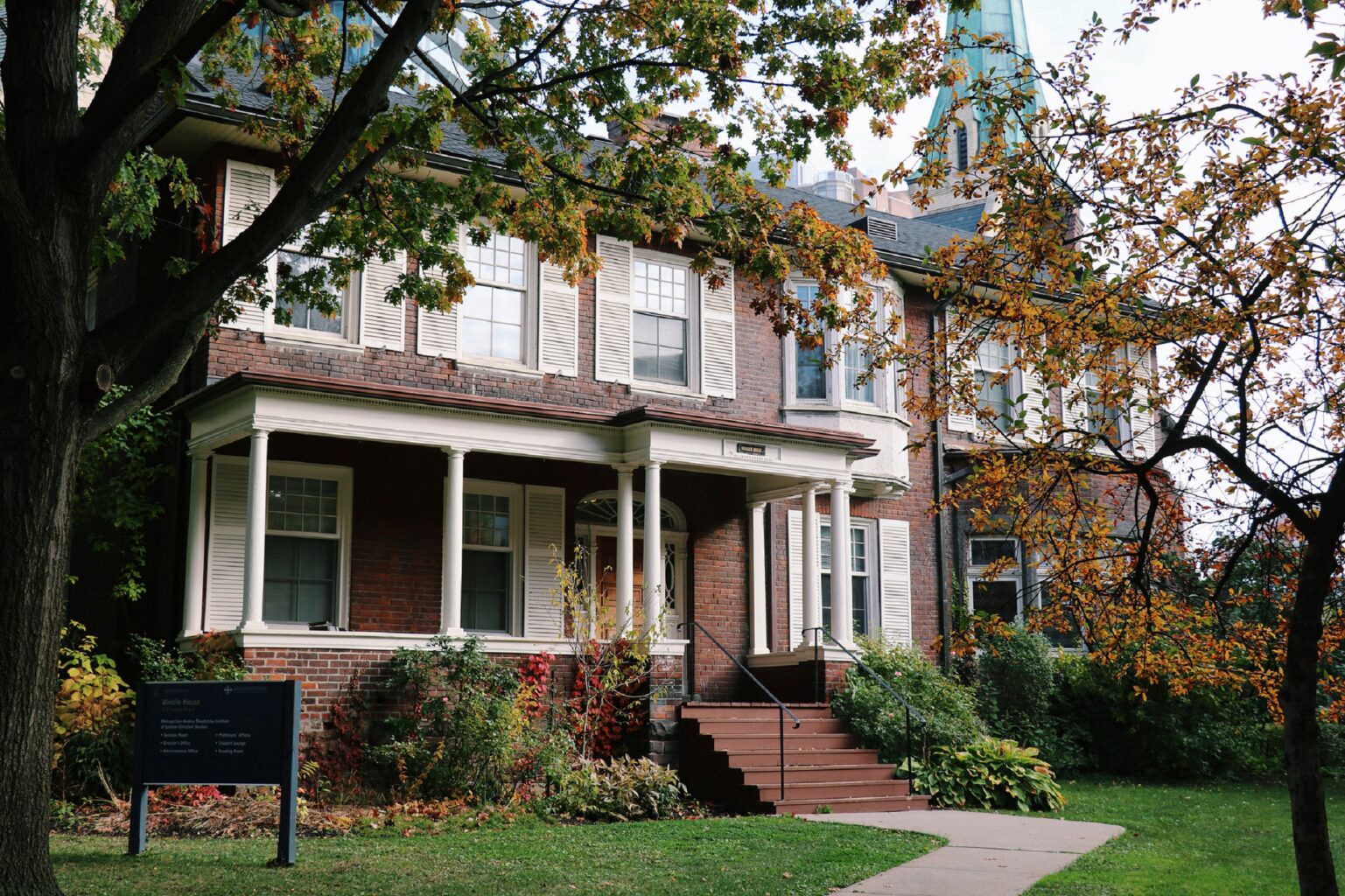
In this time of pandemic and lock-down…we are separated by public and health recommendations, law, and fear for ourselves and our loved ones. In this situation, I desire to be reunited with friends, family, and significant other. I expect that you feel the same way. This pain, which I feel in my heart, reminds me of a time when we could be together and be joyful and content in being together.
This experience can give us a chance to reflect on unity and what it means to be united or to desire unity with others. It can help us think about the question of Church unity, especially during the Week of Prayer for Christian Unity, which for more than a century has occurred every year from January 18–25. In this little blog post I will reflect on the pain of separation, the joy of unity, and my identity as a Ukrainian Greco-Catholic in the midst of these.
I can recall a few moments in my own life when I have felt the pain caused by the separation among Christians. I keep those experiences in my heart as a reason to work for unity. The first time my heart felt the pain of separation was in Amsterdam, where other students and I were attending an ecumenical conference. That was, in fact, one of my first experiences of listening to and speaking with other Christian denominations. It was exciting to see that there are a lot of themes that unite us. As a part of that meeting, we went to a Sunday service in one old and lovely English Reformed Church. There was a wonderful service and sermon. It was the Sunday of the Cross in my Church calendar, and I was happy that the preaching was about the symbol of the Cross and its importance in the Christian life as the sign of our salvation. After that, however, I was disappointed at the absence of the Eucharist in the service, and it brought me some pain. I understood that I could not have received it anyway, but the pain of not seeing the Eucharist—what I understand to be the realization of unity—as part of the Sunday service profoundly pained my heart.
Another experience that brought the pain of separation into focus came during an ecumenical conference a few years ago. The conference was an excellent opportunity for dialogue and sharing about what unites us. Common prayer was part of that conference, and one of the prayer services was a Byzantine Divine Liturgy presided at by an Orthodox priest. It was nice to pray together in one of the ways that I pray in my own parish. But the pain again struck my heart during Communion… Because of the separation, I could not share Eucharist with those who pray in the same way I do. The pain caused by these two experiences of Christian disunity remains. And it creates in me a longing for unity—a unity that heals the wounds among Christians as well as the wound left in my own heart.
Happily, my heart is also marked by other, more joyful experiences. It seems to me that pain alone cannot bring us together—we also need to feel the joy of unity. Studying at the Toronto School of Theology is one of these experiences. Being part of the University of Saint Michael’s College and studying together with other students of different Christian denominations brings me a lot of joy. Also, the presence of the Metropolitan Andrey Sheptytsky Institute of Eastern Christian Studies at Saint Michael’s brings a different voice and many opportunities for the students to experience and learn about other traditions. This experience of common work, studies, prayer, and friendship reveals a lot of differences; at the same time, simply being together unites us.
As I mentioned before, I am a Ukrainian Greco-Catholic. This means that I belong to an Eastern Church of the Byzantine Rite that is in union with Rome. There are 23 Eastern Catholic Churches in the world. Being an Eastern Catholic is beautiful but challenging in some ways. I experience all the beauty of Byzantine prayer, eastern spirituality, and magnificent iconography. I also enjoy all the beauty of the Latin Church, its theology, prayer, and teachings. Living in these two spheres simultaneously gives me the feeling that I see a glimpse of unity among the churches, and I feel the pain of separation and the joy of unity at the same time. But I know there is a long way to go, and all of our efforts are not enough if we do not call on the Holy Spirit to unite all Christians, as He did at Pentecost. Therefore, this Week of Prayer for Christian Unity gives us an excellent opportunity to be together (even if it is virtually), pray, be joyful and ask the Holy Spirit to unite us.
It seems appropriate to finish this little blog post with the words of the Kontakion of Pentecost:
“When the Most High came down and confused the tongues, He parted the nations. When He divided the tongues of fire, He called all to unity; and with one voice we glorify the all-Holy Spirit.”
Read other InsightOut posts.
Dr. Christopher Hrynkow holds a PhD (Peace and Conflict Studies, St. Paul’s College, University of Manitoba) and a ThD (Christian Ethics jointly awarded by the University of St. Michael College, the Toronto School of Theology, and the University of Toronto). Hrynkow is Associate Professor in Religion and Culture at St. Thomas More College, University of Saskatchewan, where he teaches courses in Religious Studies, Catholic Studies, Peace Studies, and Critical Perspectives on Social Justice and the Common Good. He presently serves as the founding director for St. Thomas More College’s new Centre for Faith, Reason, Peace, and Justice. Additionally, Hrynkow is Department Head, Program Chair, and Graduate Chair in Religion and Culture for the University of Saskatchewan.
A Culture of Care
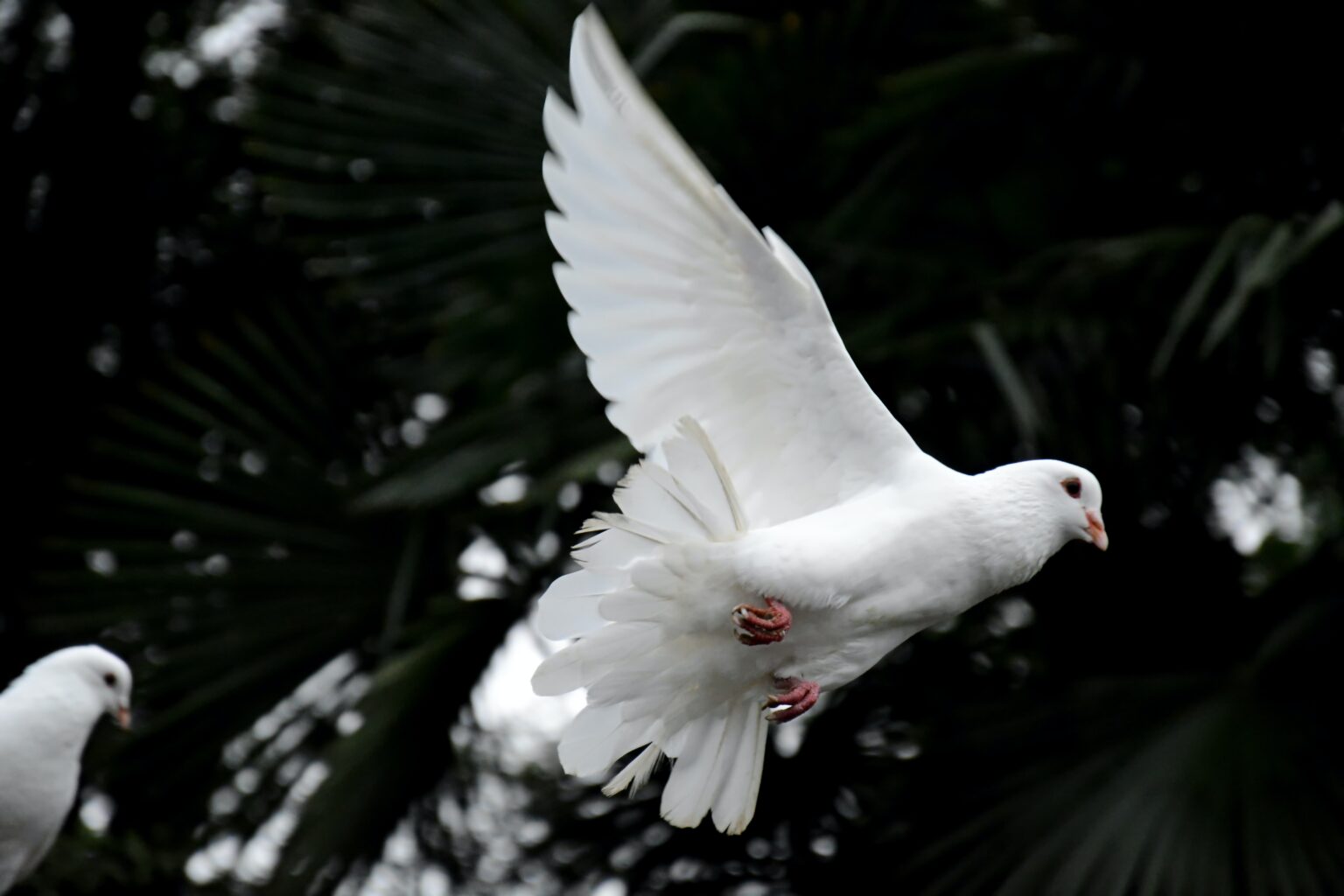
COVID-19 has provided a real opportunity for us to pause and reconsider our ways of being in the world. Such reflection can bring into focus an important question for Christians, academics, and citizens today: what kind of world do we want to see after the pandemic? In considering adequate responses to this question, I know in my heart that we cannot go back to the status quo that existed in late 2019. First of all, especially after this dark winter, we will have lost too many folks who would have otherwise survived. As such, the world cannot ever be the same. Also, my faith along with my formal studies and research in areas including peace, education, and Christian Ecological Ethics have formed not only my mind but also my heart. The cumulative effect, in no small part as result of my experiences at St. Mike’s, is that I am certain we need a transition to more just and verdant ways of being in our religion, politics, education, and action in the world. Better choices in terms of what we select to revive and what we choose to leave behind in our cultures and societies as a result of the pandemic are required to participate in the necessary transformation. From a Christian perspective, this transformation is necessary to more fully accept Jesus’ call to be pilgrims for peace, justice, and the integrity of creation on Earth. Contemporary Catholic Social Teaching can provide a guide for this most important journey. In order to ground these opening points, please allow me to go deeper into one of the most recent examples of Catholic Social Teaching with my remaining space for this reflection.
Since Paul VI established the practice, each year and in anticipation of the World Day of Peace celebrated on January 1, the Catholic Bishop of Rome releases a message. In the 54th message, written for 2021 during a time of global pandemic, Pope Francis addressed A Culture of Care as a Path to Peace. This example of Catholic Social Teaching is both innovative and important. Herein, like his predecessors, Francis considers peace as much more than the mere absence of war but as also including positively defined conditions like social justice, gender equality, care for creation, and, as he himself helped to bring into focus, cultures of encounter and dialogue. Indeed, by introducing “a culture of care” to Catholic Social Teaching, he is recalling his earlier reflections that align with, and enrich, the content of “cultures of peace” so important to peace studies. The concept of cultures of peace is both analytical and aspirational. It helps us to discern those ways that are helpful in cultivating cultures of peace. Additionally, “cultures of peace” provides a framework to exercise our moral imaginations in creative ways in order to provide a vision to drive the action of building substantive peace.
In accord with these intertwined features of cultures of peace and drawing lessons about caring for both each other and the rest of creation from the events of 2020, Francis offers “a culture of care as a way to combat the culture of indifference, waste and confrontation so prevalent in our time” (#1). Summarizing the doctrine of the Catholic Church in light of a culture of care Francis teaches, “this doctrine is offered to all people of good will as a precious patrimony of principles, criteria and proposals that can serve as a ‘grammar of care’: commitment to promoting the dignity of each human person, solidarity with the poor and vulnerable, the pursuit of the common good and concern for protection of creation” (#6). In this light, Francis articulates a duty to promote a culture of care “as a process of education” (#8) in a holistic sense that moves far beyond the four walls of the classroom to touch upon the duties toward the common good not only of teachers and professors but also of those of families, faith leaders, and politicians amongst others. For Francis, supporting the common good with a spirit of solidarity is particularly important at a time when “the massive Covid-19 health crisis…[is] aggravating deeply interrelated crises like those of the climate, food, the economy and migration, and causing great suffering and hardship” (#1). As such, the Pope teaches there can be no substantive peace without a culture of care, which “calls for a common, supportive and inclusive commitment to protecting and promoting the dignity and good of all, a willingness to show care and compassion, to work for reconciliation and healing, and to advance mutual respect and acceptance” (#9). These are prime ingredients for any recipe aimed at nourishing the incarnation of cultures of peace in this world.
To conclude, I would note that in framing cultures of care as a path toward peace Francis is implying there are other paths towards peace, a selection of which he has already engaged in other exercises of his teaching office, including with Laudato Si’ and Fratelli Tutti. Peacebuilding work is transformative because these paths of dialogue and action exist within a reality of integral ecology, where everything is interconnected, as Francis also notes in the 54th World Day of Peace Message. Indeed, that connectivity means a culture of care is transformative whether it be incarnated in small doses like sharing nourishing food with a neighbour or in large doses like ensuring the just distribution of vaccines across both individual societies and the community of nations. Thus, if Francis’ teaching has resonance for you, the global pandemic is no barrier to the necessary transformative journey named in this reflection. In fact, despite its association with restricted movements, lockdowns, and curfews when viewed through a lens informed by a culture of care, COVID-19 actually serves to stimulate this transformative journey. It only remains for us to choose a path, or paths, to peace. Then, we begin, or indeed deepen, our work as pilgrims building up cultures of peace.
Read other InsightOut posts.
Mary Ellen Sheehan, IHM, STD, earned a Doctorate in Sacred Theology from the Catholic University of Louvain in Belgium and is a Professor Emerita of Theology at St. Michael’s College of the Toronto School of Theology. Currently, she offers lectures, workshops, and retreats that relate theology to a range of questions emerging in our current cultural context. She draws on the contemplative character of theology to deepen our experience and understanding of God and to explore the meaning of committed Christian discipleship in our world today.
Keeping My Hand to the Plough
With committed colleagues and always stimulating students, I enjoyed 35 years of blessed ministry at St. Michael’s Faculty of Theology. There is simply nothing like the ecumenical and interfaith exchange at the Toronto School of Theology, where all involved learn so much from each other through theologically informed, respectful dialogue. In 2013, at the age of 75, I left Toronto and moved to Windsor. There, as my Irish-born father used to put it, I kept “my hand to the plough” by offering reflection days, workshops, and retreats on theology and cultural issues in several countries. I also became active in local Interfaith Centres, learning always and contributing, too, to these dialogues. Ah, the beauty of that endless curiosity I was born with!
In December of 2019, I made perhaps the biggest move of all: crossing the border to take up residence in Monroe, Michigan, where our IHM Senior Living Community is located. I received a warm welcome from our many IHM Sisters who live here, several of whom are my longtime friends. At the same time, I found myself engaged in considerable adjusting, recognizing through a few new aches and pains and through some energy and stamina diminishment that I am “aging” a bit! As well, I am still reckoning with the fact that I can no longer be in those stimulating classrooms at TST! However, being healthy and in the Independent Living part of our Centre, I still enjoyed my trips with friends to libraries and to the Detroit Art Museum and Symphony Hall.
But little did I know that by March 2020 everyone on our planet Earth would be adjusting! The border closed, so no annual spring and fall trips for me to Toronto to renew my friendships with colleagues and former students and to experience the rapid changes occurring in the city. In fact, I could not even go to Windsor to enjoy friends there. And increasingly, with new State health regulations, my freedom to go off our Monroe campus has been curtailed. New challenges indeed—COVID consequences—from which not even a bizarre USA Presidential Election process could distract me.
My first inclination was to go into a contemplative Celtic Anchoress state with my room as my hermitage. But that didn’t last too long! While I am sure that those Anchoresses had their informal ways to keep up with the village happenings, they did not have computers and mobile phones with global reaching apps and email! But me? I have those things and so I have figured out how to use them to contribute to the mission of our active IHM Religious Congregation, committed as we are to “the liberating mission of Jesus Christ” through preaching, teaching, and healing.
Through email, FB, Zoom, and WhatsApp, I have been able to communicate with family, friends, colleagues, and former students all over the world. We share our joys and sorrows together and thus keep the strength of Christian community—the Body of Christ, the people of God – alive and well in loving support for each other. After all, Jesus didn’t put any conditions on his claim: “Where two or three are gathered in my Name, there I am in their midst.” We have supported each other in some family tragedies that have occurred, and while we have not been able to gather for funerals and weddings and graduations, we have not been COVID-defeated. For sure, there is no replacement for a personal hug or a good cry together, but technology has kept us connected.
Here in our IHM Senior Living Community we have Sisters who suffer from physical diminishment. But how they are contemplatively connected to our loving God! So, I go to them to ask them to pray with me for people I know in need of strength and consolation from COVID challenges. Several of the Sisters write down first names and put them next to their Living in Christ liturgical readings booklet and pray each day for them. We also have a practice of writing names on a board outside our Chapel so that they are brought into common prayer time, with all the proper COVID protections in place.
Personally speaking, I have preached at our Liturgy of the Word services, a practice that brings me so deeply into the ever-creating Word of God, a Word that helps us all to remember how life emerges from suffering when there is community. I have also kept current with challenging articles and books on colonialism, white privilege, racism, local LGBTQI church injustices, and other acts of social and economic exclusion. I have also participated in stimulating and personally challenging Zoom sessions on some of these topics. I share these resources with others and we have follow-up “techy” conversations that always lead to prayerful reflection and compassionate action.
And always, I have my classical music playing, and of course, too, at times the haunting renditions of Hallelujah by Leonard Cohen and K. D. Lang. At times, too, I put on a CD of poignant lamenting Irish songs. Always in reach is the current biography I am reading and poetry books. Prayer and the arts nurture appreciation. I experience in them beauty aborning from pain, hope arising from tragedy. In a sense, we can all produce something out of nothing when we share our God-given gifts with each other. Our loving God is always creating, healing, and transforming us, leading us to hope even as we struggle with COVID consequences.
Read other InsightOut posts.
David Byrne is a doctoral candidate in theology (ethics) at the University of St. Michael’s College. David is also a professor in the Community and Justice Services program at Centennial College in Scarborough, Ontario. David lives in Oshawa, Ontario with his wife and two children.
A Year of Learning Differently

I have developed a motto over the course of the COVID-19 pandemic. A year of living differently. I have said it so many times, it has become a mantra—a way to refocus when my family and I are faced with change, or when we have to give up something we love to do. No more visits to museums or the zoo? A year of living differently! We camped instead, exploring Ontario’s provincial parks. No big family celebrations or barbecues? Just a year of living differently! So, we gathered virtually and at a distance. Postponing a trip my wife and I were hoping to take for our ten-year wedding anniversary, opting instead for a long bike ride and dinner at home… a year of living differently… though, that one with less panache.
As a professor at Scarborough’s Centennial College and a father of two young children, for us there is no place that the impacts of this year of living differently have been more noticeable than in the classroom. Mornings used to be rushing around to get everyone ready before dropping them off at their schools and driving into Scarborough to teach, coffee in hand. Now, with my wife and I working from home, and our children doing online school, mornings are waking up slowly and making sure everyone is fed and set up with their technology before our various Zoom meetings start.
Though I appreciate the extra time that this change has provided, it has been a hard adjustment. My children miss their friends and teachers, and I miss my coworkers and students. My wife would happily return to the office if able. There is nothing that technology can do that can replace the transformational experience of working and learning together, face to face, despite the enormous efforts of educators over the last eight months. And in many ways, it is getting harder, as we all grow tired of the seclusion and endless hours spent staring at screens.
Though, the pandemic has not been the only major adjustment for our family this year. In the spring, after months of testing, my daughter was diagnosed with a learning disability. As a baby and toddler, my daughter shone brightly. She walked early, she talked early, she was creative and engaging. Though, despite her social skills, we noticed that she struggled with some aspects of learning. Though she would carry on conversations with anyone who listened, she struggled to recognize letters. By the time she reached Third Grade, she was a year or two behind most of the other kids. This meant that in an educational environment where grades are prioritized, we had to adjust our expectations and support her as she struggled through her work, knowing that even with her best effort her report cards would be more a moment of recognizing and celebrating small victories than big ones.
Even with her diagnosis, and the creation of an Independent Educational Plan (IEP), my daughter would struggle in a regular classroom environment. There, with a single teacher whose attention is split between twenty or more students, our daughter cannot receive the support she needs to thrive. Though my daughter’s teachers have been fantastic in their efforts to support her, there is no way in our education system to provide the level of flexibility it takes to meet the demands of children who face complex barriers to learning. So, even though the psychologist who diagnosed my daughter asserted that my daughter could a get a PhD with the right accommodations, I found that hard to believe.
Then COVID struck, and with it the longest March Break in history.
With all of us at home, my wife and I took turns helping our daughter with her work. We supported her to get organized. We taught her to use a laptop with voice technology to help with her reading and writing. We helped her to overcome the frustration that accompanied her constant feeling of inadequacy. It was not a smooth or linear process. There were lots of strategies we tried that did not work. Lots of days where the demands of our own jobs meant that our daughter was on her own. But over time, we saw a change.
Tears became less frequent. Her reluctance to try new strategies gave way to excitement for new learning technology, especially the programs that let her express herself creatively. She started answering more questions in class and, to our surprise, helping her fellow classmates to understand their assignments. And when her recent progress report came out, the results reflected what we were seeing—our daughter was “getting it” for the first time.
I witnessed the positive impact of a flexible, empathetic and unconventional approach to learning. I watched my daughter shift from apprehension to enthusiasm. And, as a professor, I immediately thought to my own students. Especially those who struggle the most—and thought, how might a similar level of support and flexibility benefit them? What do they need to unlock their hidden potential that they have not had provided to them?
As a doctoral candidate in theology at USMC, whose research is rooted in liberative theological ethics, an approach to doing ethics that begins with the concrete experience of people as a primary source for ethical reflection, I was called to think more deeply about who my specific students are. I teach in a program at a school in a community where many of the students face barriers to learning. Many of my students work full time to afford their education. Many provide care for parents and young children. Many are first- or second-generation Canadians. And many are the first from their family to attend post secondary education. Few of them enjoy the same level of support and stability that my daughter does.
What I have found is that in this year of living differently, with my life unrecognizable from a year ago, I am called to embrace how to learn differently, too. As everything I know about education shifts, as I am shaken from my habits, as an educator I am called to change. To change the way I lecture, the way I assign and assess work and the way I view the different approaches to learning of my students. I need to look for ways to identify their unique needs and provide them with accommodations. I also need to see this task as an opportunity as opposed to a burden—one that I admit makes me feel vulnerable, but one that also enables me to see the face of my daughter in each one of my students—the little girl who found her love for learning in a radically different space than the one I imagined.
Read other InsightOut posts.
A tight job market for teachers led Marie Green to chat with a professor she had taken a course with at St. Michael’s Faculty of Theology.
This Saturday, November 14, she will not only be granted her doctorate in theology, she will also be the recipient of the Governor General’s Award for achieving the highest academic standing.
After having completed her Master of Theological Studies degree at Wycliffe College, Green then earned a Master of Science in Adolescent Education at New York’s D’Youville College. But when she returned to Toronto, she learned that high school teaching jobs were hard to find, and she hoped that Dr. Darren Dias might help her brainstorm on how to find a position. She had a calling to teach, and was keen to start.
But the conversation took a turn when Dr. Dias began to speak enthusiastically about a new doctoral degree that was to be offered conjointly with the University of Toronto.
“After two master’s degrees I thought I was done writing essays, but after our conversation I spend the next two months prayerfully considering (the doctorate), while still waiting to find a teaching job.”
Ultimately inspired, she applied to the doctoral program, and began work in 2015. This Saturday, Nov. 14, she will formally become Dr. Marie Green.
Green’s thesis topic, Examining the Experience of Racialized Students in Southern Ontario Catholic Schools, has led her to design a university course she hopes to teach at a later date: Black Lives Matter in the Classroom.
“My topic and search were inspired by my experience in school. I had some great teachers, but I also experienced racism and was stigmatized,” says Green, who was born in Jamaica and moved to Toronto at the age of 13.
“Why can some teachers make all students feel valued and do this so well, while others create a negative climate?” she asks.
It is this question that prompted Green to study the Catholic school system specifically because it offers a faith-based approach that asserts that all students should be viewed with the understanding of Imago Dei, that every person is made in the image and likeness of God. If we embrace that belief, she says, then how do we work in the classroom to ensure that we are treating students with that level of humanity, and doing it evenly?
Partly, the challenge of changing attitudes comes from figuring out how to widen our knowledge base and deal with a culture steeped not necessarily in malevolence but in ignorance, she says. What is key, she adds, is to ensure that lessons offer every child an opportunity to recognize him/herself in the lessons being taught.
If Green sounds passionate about teaching, she says she learned a great deal from the professors and community she encountered while at the Faculty.
“The professors clearly have a passion for teaching, which comes from loving what you’re doing. That leads you to want to see students strive for their best,” she says.
She says she made lifelong friends at the Faculty, and credits time on both the Faculty’s Student Life Committee as well as her time serving as the Vice President, External on the TST Graduate Students’ Association as a wonderful way to build a supportive community and, in time, to mentor younger students.
“In real estate they use the old term ‘location, location, location’ but in academia it’s ‘relationships, relationships, relationships’” she says, noting that the friends you make and the people you meet can help in everything from getting support in doing research to finding outside connections.
Marie is currently teaching computer skills in the corporate world, and when people she encounters find out her educational background they are often puzzled, but she says there’s a clear link.
“As philosopher Jacques Maritain and educator Paulo Freire advised teachers, if you can see others’ humanity, you can nurture the knowledge that already exists inside of them. Theology is at the base of so much. It really helps everyone.”
Visit the Faculty of Theology’s Fall Convocation 2020 page to learn more about this year’s graduates and to celebrate their unique achievement.
Douglas Day Kaufman, who will be granted his Master of Theology degree on Saturday, November 14, was drawn to study at St. Michael’s Faculty of Theology because his interest in ecotheology.
“I came because of The Elliott Allen Institute for Theology and Ecology (EAITE) as a way to have a deeper understanding for articulating a Christian approach to environmentalism,” Kaufman says. “When I met Dr. Dennis Patrick O’Hara, I knew he would be an excellent guide for me and so he proved to be.”
As he reflects on his time at the Faculty, several things resonate: the weekly worship, the diverse community, the beautiful University of Toronto campus with its multiple libraries and the opportunity to grab a fast bite, often from another culture’s cuisine.
When asked what he will take away from his studies, he cites a quote from Thomas Berry, whose work in ecotheologian who inspired the EAITE: “ ‘We must say of the universe that it is a communion of subjects, not a collection of objects.’ I experience that communion and community in my daily walks in the woods near my home, and that helps empower my ongoing activism for the sake of creation.”
Now, Kaufman looks forward to employing what he has learned in his role as Director of Pastoral Ecology at the Center for Sustainable Climate Solutions, a partnership in Goshen, Indiana, encouraging Anabaptists/Mennonites to see climate change as the moral equivalent of war. A pastor himself, at Benton Mennonite Church in Goshen, he lead retreats at the centre on climate change for Anabaptist pastors and leaders.
“ I consider it a privilege to have been part of an elite institution like the University of Toronto and St. Mike’s,” he says. “There are so many resources and yet it did not feel elite to me. The library staff, for example, was so amazing to graduate students. I treasure my time there.”
Visit the Faculty of Theology’s Fall Convocation 2020 page to learn more about this year’s graduates and to celebrate their unique achievement.
“The University of St. Michael’s College Faculty of Theology serves the Church by educating and forming its sons and daughters, and I am proud to call myself an alumnus of this Faculty,” says Hugo Tang, who will be granted a Master of Theological Studies degree on Saturday, November 14.
Tang says he wondered whether he was making the right choice when he decided to enrol, wondering whether the Faculty might be “too liberal” and fearing “that I was not capable of such mature and high-level discussion, given my relative youth and inexperience.
“I noticed, however, a spirit of fraternity combined with academic rigour which attracted me to apply to the Faculty,” he says, and that feeling was supported by the recommendations of several members of his parish who had graduated from St. Mike’s.
When he started classes he was encouraged by the academic rigour, combined with a sense of community and a small yet diverse student body.
“The diversity of the student body produced some interesting and fruitful “theologizing” in class and beyond,” he recalls. Whether lay or religious, fresh graduates or mature students, each brought a new and unique perspective to the table. Being a bit of a nerd for theology, and warmly welcomed by all, I soon felt at home amidst the other students and faculty.”
As St. Mike’s is one of the seven member colleges of the Toronto School of Theology, Tang had the chance to meet students from other colleges, including the two other Catholic schools — Regis College and St. Augustine’ Seminary.
“In our classes, I witnessed that it’s alright for people to disagree. People can (and should) co-exist fraternally even if they hold different opinions,” he says. “We should, however, be ready and willing to challenge and support our opinions and beliefs with arguments, facts, and references to source documents. I think as a society today, we have too often lost the ability to agree to disagree, that we put up walls around us. Rather than fulfilling us, these walls suffocate us and darken our world.”
Reflecting on his time at the Faculty of Theology, he says, humbly, of his Master of Theological Studies degree, “The degree is a bit of a misnomer: I am not a ‘master’ at theology. I have not and will never master theology, for theology is the study of God, God who is omnipotent, omniscient, and omnipresent. I truly believe that everyone is a theologian, because each one of us, whether intentionally or not, is seeking God in his or her own way, through the pursuit of all that is good, true, and beautiful.”
Hugo says his studies have given him the framework and vocabulary to allow him to continue to grow. He says among the skills he has gained are an enhanced ability to argue a point, the ability to express himself and speak for an extended period of time, and writing lengthy papers.
“Everyone should study theology— maybe not a full master’s degree, but at least a few courses. Catholics, myself included, are largely under-catechized. I did not realize this until I began this degree. Given that our faith is more and more countercultural, we need well-formed disciples to live and preach the Gospel in the world. We need to do more than simply memorize the faith but make it our own through reason.”
Visit the Faculty of Theology’s Fall Convocation 2020 page to learn more about this year’s graduates and to celebrate their unique achievement.
“I was drawn to study at St. Michael’s Faculty of Theology because of the reputation of the institution,” says Tina-Marie Lockyer, who will be granted her Master of Religious Education degree on Saturday, November 14. “I wanted to learn more about my Catholic faith, and I felt that St. Mike’s was a good fit for me. “
One of the things that really struck Tina-Marie as a student was how small the faculty actually feels.
“The University of Toronto is a world-class university and thousands of people are there every day. Somehow when you enter St. Mike’s you feel as though you are part of a family that cares for each other. Even as a part-time student, I always felt as if I was an important member of the school.”
Another thing she appreciates about St. Mike’s is that while it is Catholic-centred, “there is a communion with other faiths and institutions in the Toronto School of Theology, and we are always open and willing to learn and understand others through dialogue.”
When people ask TIna-Marie what is involved in earning a theology degree, she says she tells them it is “a lot of hard work, but I loved every minute of it: the readings, the writing and the friendships made me a more well-rounded person with a strong Catholic faith. The professors and support staff at USMC made all the difference in my program. It was so wonderful to walk the halls and have professors actually know me by name. Also, the relationship a grad student has with the library is important, and at St. Mike’s we literally have anything we need from the library at our fingertips. It is extremely helpful.”
But the main lesson Tina-Marie says she will forward is that her is that “we are meant to be with Christ. Decisions you make should be a part of who you are, and that has to involve Christ. If you endeavour to have a relationship with Christ you will always achieve love, moral decisions and justice, because that is what Christ calls us to do, and we want to please Him because we love Him.”
Lockyer chose the MRE for personal enrichment and faith development.
“My degree will also support my work in my parish and pastoral care at the hospital,” she notes. “As a religious educator, this degree will allow me to expand my leadership potential.”
While she enjoyed her time at the faculty. one of the highlights was the opportunity to study in Israel at Bat Kol, a centre of Jewish studies for Christians using Jewish sources.
“It was an experience that I will always remember fondly,” she recalls. “I learned so much about Judaism and it deepened the understanding of my faith. Being in the places where Jesus and the Apostles walked, and having access to special places because we were Bat Kol students, is something I will be forever grateful for.”
And lest anyone think this is good-bye, a final note: “I do not actually want to leave USMC,” she says, “and am considering coming back for another Master’s degree in the future….”
Visit the Faculty of Theology’s Fall Convocation 2020 page to learn more about this year’s graduates and to celebrate their unique achievement.
For Minnesotan John Solheid, it was the Faculty of Theology’s reputation that drew him to study at the University to St. Michael’s College. Add in the size and resources of the John M. Kelly Library, as well as a “generous financial package” and he was sold.
This Saturday, November 14, he will be granted his doctorate, officially becoming Dr. John Solheid, with his thesis entitled The World in the City: Biblical Scholarship and Reading Culture in Origen’s Psalm Homilies from the Codex Monancensis Graecus 314.
“I was immediately impressed with how welcomed the faculty made me feel,” he recalls. They helped me …acclimate to Canada, to Toronto, and to campus. I never felt out of place or as if I didn’t belong.
“St. Mike’s is a wonderful place to learn and develop personally and spiritually. There is a very collegial atmosphere at St. Michael’s. It is ideal for anyone who want to be part of a scholarly community.”
Solheid, whose goal is an academic career as a professor and scholar, says one of the key lessons he learned while at St. Mike’s was a sense of responsibility to participate in the broader scholarly community, doing such things as attending lectures and presentations from peers, even when the subjects aren’t related to his own research.
“I always appreciate how much I learned from those presentations and lectures, and especially those whose subject matter was not related to my field.”
An added bonus? “I made some friendships that will last a lifetime.”
Visit the Faculty of Theology’s Fall Convocation 2020 page to learn more about this year’s graduates and to celebrate their unique achievement.
When Josefine Nobel first pondered theological studies, a friend put her in touch with a graduate of the Faculty of Theology whose assessment of the school prompted her to apply and enrol.
“I have always felt like I am home here, and especially when sitting and engaging with my peers and faculty,” says Noble, who will be granted a Master of Divinity degree on Saturday, November 14. “This sense of community is often cemented with events arranged by the Student Life Committee, the liturgies, the extra-curricular outings such as the Ordinandi Dinner and events put on by the Toronto School of Theology as a whole.”
That sense of community, she says, made her entire experience transformative.
“At first, I did feel that my faith—and all I had thought I knew about the Church and God— was being challenged, I also learned that faith is able to be challenged! In fact, it grows stronger! Somehow, as my old frameworks of meaning were challenged, I begin to stretch the ‘envelope’ of my faith and this did not diminish it rather it enriched it.”
Because of this, she says, she feels she has been transformed on many levels—spiritual, personal, and intellectual— “and I know that I have also become a better human being and a Christian.”
Another huge lesson for Noble at Saint Michael’s has been the lesson of community, she says.
“I have often chosen to work alone and have not been so drawn to communities and group events. I worked in my church behind the scenes and thought that I preferred that. Saint Michael’s changed me. I have become aware that there is richness to be found in community and this is a very large part of what enhances one’s faith and faith walk. I boldly offer then that any who desire their educational experience to be further enriched by the power of community will be sure to find it attending Saint Michael’s.”
Today, Josefine has begun work on a Master of Theology degree, continuing onward to see where her education takes her.
“I am honored and blessed to be a part of Saint Michael’s and I hope to continue to grow here in fellowship, friendship and faith.”
Visit the Faculty of Theology’s Fall Convocation 2020 page to learn more about this year’s graduates and to celebrate their unique achievement.
Nick Cotman did his undergraduate studies in philosophy and political science at the University of Ottawa. He then completed his Master of Theological Studies at St. Michael’s Faculty of Theology in 2019. It was at this time that he began working in the chaplaincy leader position at his alma matter, Holy Cross Catholic Secondary School in Kingston, ON.
Encountering Opportunity in Restriction
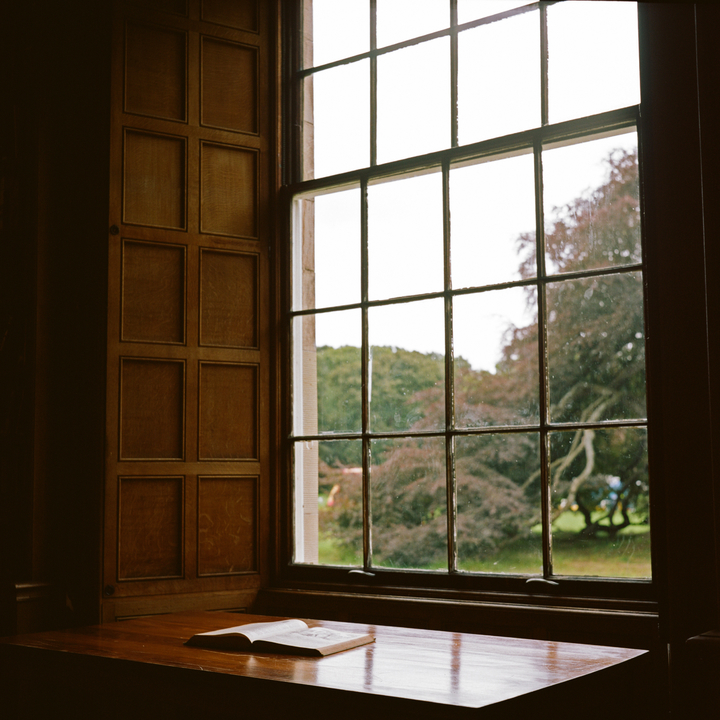
As we have come to expect from most things in 2020, public education in Ontario’s schools looks a little different from most years. In Kingston, secondary schools are following an octomester model, meaning that there is one class each day for 22 straight days. Lunch periods are staggered for each grade in an effort to avoid congestion around the school. Additionally, teachers are livestreaming their lessons to ensure remote learners are getting the needed material. All of these adjustments have required a significant mental and pedagogical reorientation from staff and students. Having only begun my high school chaplaincy career in the fall of 2019, and being out of the school by this past March, these first months back have felt more like the second volume of my first year as I relearn the role.
Being (physically) back in school has affirmed something I had been reflecting on since COVID first began to reshape our daily lives: that a single thing can be both restrictive and freeing. The colleagues and students I have the privilege of spending time with each day are showing me there are unexpected opportunities to be found in the constraints we are currently navigating. I think it is important to note, however, that any “pleasant surprises” we encounter in no way diminish or undermine the unique challenges each of us has faced. Nonetheless, we should acknowledge that by being forced to reconsider the way we approach many things, 2020 has also shed light on the shortcomings of previous practices and provoked new, more effective methods. Being in school has made this especially clear to me.
There are a few experiences I’d like to recount. The first is one which is bound up closely with my position in the school: the absence of school Masses. This has forced a significant shift in focus to other liturgical practices. I have been doing regular class visits to lead lectio divina readings and the Ignatian Daily Examen with students. Although we will be thankful when the day comes that we can celebrate Mass as an entire community, this unplanned hiatus has led me to recognize the richness of these other liturgical approaches. Mass in school was always an appreciated community event, but it was evident that further foundational efforts in spirituality and liturgical understanding would enrich the experience. The event of a school Mass may have become overly familiar, causing a lack of deliberate and reflective participation. J.R.R. Tolkien wrote that we often need “to clean our windows; so that the things seen clearly may be freed from the drab blur or triteness of familiarity.” This break may inadvertently serve as opportunity to form our liturgical sensibilities as a community through other practices, allowing us “to clean our windows,” and more fully appreciate Mass when we can gather once more as an entire community.
Another example that is small but noteworthy is the new inclusion of an end-of-day prayer. Prior to current circumstances, we would recite a simple grace over the PA before lunch. Now, however, with each grade now getting out of class at different times, this was ruled out to avoid further interruptions. In the absence of a lunch hour prayer, we decided to begin doing a prayer at the end of the school day. This small change has been incredibly well received. We join in a meaningful prayer to give a definitive conclusion to the school day and to look forward to the evening ahead. This is a practice we will likely carry forward beyond these unusual circumstances, though we may have been unprompted to explore it without the current conditions.
Without Masses, retreats, or community outreach to coordinate, my priorities within the school have shifted. More than ever, it seems that chats in the staff room and chance encounters with students in the halls are of greater pastoral importance. When there was more room to complete tasks and plan outreach events, I began to let behind-the-scene to-do lists take the front seat. I’m thankful I’ve been required to shift my focus to relationships within the school. When things return to normal, I’ll be sure to maintain this focus.
There are an array of other instances I could talk about, such as our amended graduation ceremony, virtual coffee houses, and the music class using the cafetorium so as to social distance more effectively (allowing halls throughout the school to enjoy their practice). Students seem more open to seek me out to chat (though perhaps they just want out of class since they’re now in the same room all day!) and are displaying impressive consciousness of the well-being of those around them. They are dutiful in mask wearing, have embraced the octomester model, and even surpassed any previous food drives during our Thanksgiving collection.
These are all just small instances of the pleasant surprises I’ve seen over the past months. We have all encountered them in different ways, but I am especially thankful to see them occurring in Catholic education through the lens of chaplaincy. When we learn to embrace unanticipated circumstances, we can open ourselves up to viewing things in new ways and create room for God’s grace in areas we might lack control. In the chaplaincy work ahead, I’ll be sure to continue looking for the pleasant surprises and opportunities for growth that our current restrictions can bring.
Read other InsightOut posts.
John Fraresso is completing his Master of Theological Studies degree at St. Michael’s Faculty of Theology. He completed his undergrad at UTM in the 90’s in Crime & Deviance and Sociology. He currently serves as the Community & Spiritual Life Coordinator for the community of L’Arche Hamilton.
God Keeps Laughing as I Make Plans
If you really want to make God laugh, tell God your plans.
Sometimes God taps you on the shoulder, other times God throws a brick at your head.
Add to these—paraphrasing Gary Zukav— in order to be authentic, your personality must serve the will of your soul, and you get a glimpse into my journey of returning to school in my mid 40s. They actually define my life story, but that’s a book and not a blog.
From the time I was a young boy, I always felt called to be in service to others. If the call to have children wasn’t so strong within me, the call to priesthood might very well have won out in my teens. I listened to that call to have children and was blessed with three beautiful kids. Since they were (and are) my highest calling, I launched into corporate life in my 20s and had a highly successful career. Though it was gut-wrenching in many ways, it served my kids well by providing a very comfortable life for them. On the other side of this coin, making millions more in sales and margin dollars for a multi-billion dollar company did nothing to serve the least of my brothers and sisters, nor my soul’s calling.
About five years ago, I was discarded like yesterday’s news by the company I had poured my life and soul into. That monumental event—which at the time seemed devastating—set me on an incredible journey up to this day, a journey that continues to unfold. What is evident in it, though, is that the will of my soul is getting the upper hand, as my personality is listening to it a lot more than it used to. God keeps laughing as I make plans. Sometimes God taps me on the shoulder and I listen; more often than not God has to throw a brick at my stubborn head.
Richard Rohr wrote an entire book, Falling Upward, on what happens when we hit mid-life as we start to reassess our values and where we’re heading. Circumstances started to line up for me to follow my dream of returning to school so that I could follow a vocation to be in service to others—which, you will note, sounds entirely different from a “career change.” I enrolled in St. Mike’s Faculty of Theology to do a Master of Theological Studies degree.
Many people have said to me, “Wow, that’s quite a change. What made you decide to go in that direction?” My answer is always that it wasn’t a “change” per se; it is simply a matter of honouring what has always been deeply seeded in my DNA, the will of my soul.
I decided to do the “responsible thing” and continue to work full-time so I could make money while doing school part-time. I didn’t really need to; my financial situation had allowed me to go full-time, but I didn’t listen. Result? The new company I was working for shut their operations down. God. Brick. Head. I listened, and dedicated to school full-time.
I decided to do a field placement in my degree. My professor suggested, after a period of discernment and discussion, that I do my placement at L’Arche. Turns out—and he was bang on—that someone like me, so stuck in my head, could learn a lot from people who live from their hearts. In the ten months I have been at L’Arche I have learned more than my entire education, going all the way back to junior kindergarten.
Yet even in this journey of the past few months, I continued to make decisions with my head and didn’t listen to my heart. Put another way, my personality wasn’t serving the will of my soul. God showed up again, brick in hand. L’Arche had to remove all volunteers from their homes when COVID struck, including me. A week later, they offered me a relief assistant position. I struggled with taking it, because my head told me that perhaps I should find something full-time for the summer (a nice cerebral decision that didn’t consult my heart). My heart eventually won out, and in no time I was getting more hours at L’Arche. Fast forward a couple of months, and the person who was my supervisor at L’Arche—their Community and Spiritual Life Coordinator—was retiring, and they needed someone to fill the position.
Guess what I’m doing now! Of course, as a result of listening to my heart, it all works out well with my studies: I can balance both this position and my studies. Though it is highly regretful that classes aren’t in person—I didn’t return to school after 20+ years to do it online—the fact that they are virtual, and that I don’t need to commute from Burlington to Toronto for classes, allowed me to take this service position at L’Arche.
This is literally a microcosm, a small sample, of the incredible events that have conspired to allow for this to come to fruition. My super-stubborn self has learned (more accurately, is still learning) the valuable lesson that you can’t stand in the way of the will of your soul. I guess with more brazen effort and deafness one could. I am sure many do. I know I have. But when you surrender even just a little, gain a little humility, ask God to guide you, simply go with the flow, and let go of the wheel so that The One with a better driving record can take it, miracles happen.
Again a couple weeks ago as my head was trying to run the show, God sent another messenger to remind me. Without even knowing I needed to hear it, she shared Proverbs 3:5-6 with me: “Trust in the Lord with all your heart, and do not rely on your own insight. In all your ways acknowledge Him, and he will make straight your paths.”
Thankfully I noticed this subtle tap from God, gave control back to God, and saved myself another brick to the head.
Read other InsightOut posts.
Nick Olkovich is an Assistant Professor and holds the Marie Anne Blondin Chair in Catholic Theology at St. Mark’s College in Vancouver. He completed three of his four degrees at the University of St. Michael’s College where he met his wonderful partner Julia, a graduate of Christianity and Culture and the Faculty of Theology, in a course exploring the thought of Bernard Lonergan.
Nick and Julia’s Victory Garden
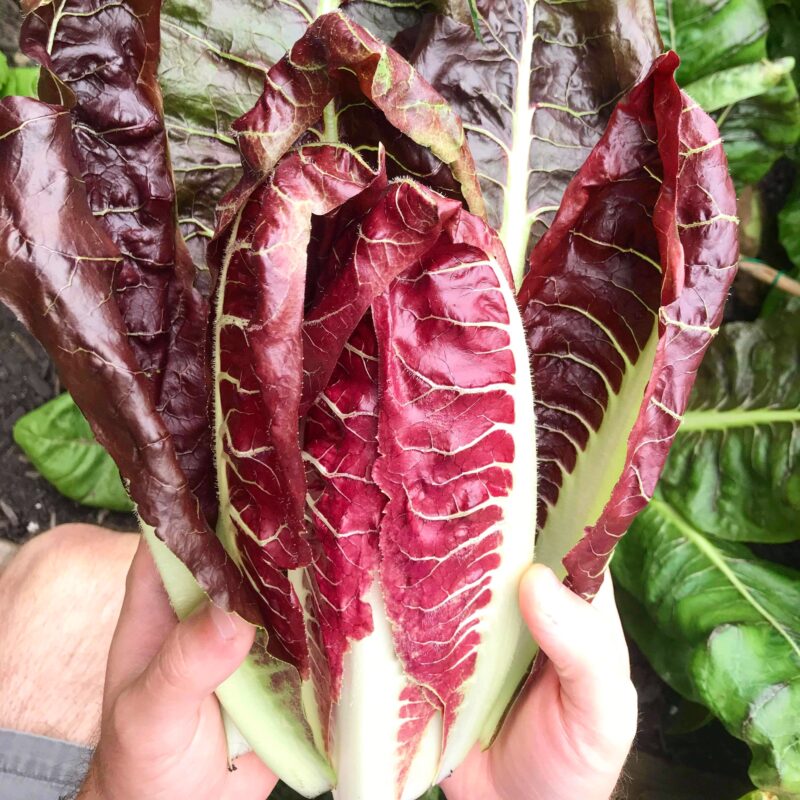
I’m sitting in my living room looking at what’s likely to be the last tomato from the small garden we planted at St. Mark’s College here in Vancouver. Shortly after everything shut down on March 16, 2020—and well before the ground was ready in Toronto—Julia and I found ourselves sowing seeds—two types of lettuce, arugula, radicchio and puntarelle—and planting tomato, eggplant, pepper and cucumber seedlings.
Anxiously awaiting signs of germination and growth, we’d close our laptops around 5 p.m. every second day and drive up to the College to check on our pandemic garden. Slowly but surely our seeds sprouted and their shoots began to look like miniature versions of themselves. Within weeks we were eating arugula while Toronto was still under a pile of snow. Yet, our tomatoes had barely grown; the cucumber seedlings kept dying; and I was convinced that my pepper plants were shrinking. I was frustrated. Anxiety over the pandemic combined with the pressure to work harder and accomplish more. I was hard on myself like I was hard on the garden.
As the lockdown wore on, workdays and then weeks began to blur into one another and yet time stood still in a different way when we’d call it quits, earlier and gradually with much less guilt, and head up to the College. We’d go when we were miserable or angry with each other. It was quiet and it helped. We’d go on the weekends sometimes when the sun was shining and it helped even more. Julia needed her steps and so we’d walk after pulling weeds and talk in ways that our pre-pandemic weekdays never seemed to allow.
As time went on our near daily trips became routine. We’d pack our tomato ties, our scissors, and big ziplock bags that I’d wash after each use. Soon we lost access to a hose and so we started bringing a watering can that one of us would fill six or seven times behind St. Mark’s Parish whenever Fr. Rob wasn’t hearing outdoor confessions. As summer finally started to arrive in Vancouver the garden became a hot spot of activity. We met neighbours who told us they liked our greens (thanks?); neighbours we traded stories and plants with; other gardeners on the UBC campus who envied the shade our lettuce got; neighbours’ children and their pets. I began running into work colleagues, one who tended two of the College’s four garden beds, and others who still had access to the main building. These chance encounters and the short conversations they prompted—so everyday and yet so oddly meaningful—broke up the monotony of daily Zoom calls and online happy hours. Soon enough the garden started to produce and everyone we ran into or visited got a bag of lettuce or clippings of chard. What had started out as a pet project had become a way to connect.
In the end, not everything worked out. The eggplant and peppers never grew. Most of the tomatoes will never ripen. But over time my frustration with the garden turned to acceptance and then celebration. Look at all the delicious things we got out of two overcrowded and partly shaded boxes. Over time I’ve grown to be easier on myself and to celebrate all the little ways Julia and I have grown over the past six months. None of it was expected. None of it was easy. All of it was grace.
Read other InsightOut posts.
Nisheeta Menon is a graduate of St. Michael’s Christianity & Culture program and holds a Master of Divinity degree from the Faculty of Theology. While studying theology she served as the Social Justice Co-ordinator and Student Life Committee Vice-President. She is now a high school Religion teacher in Mississauga, where she hopes to continue her co-curricular work serving her school community in the areas of equity and diversity education and chaplaincy.
Wandering in the Desert
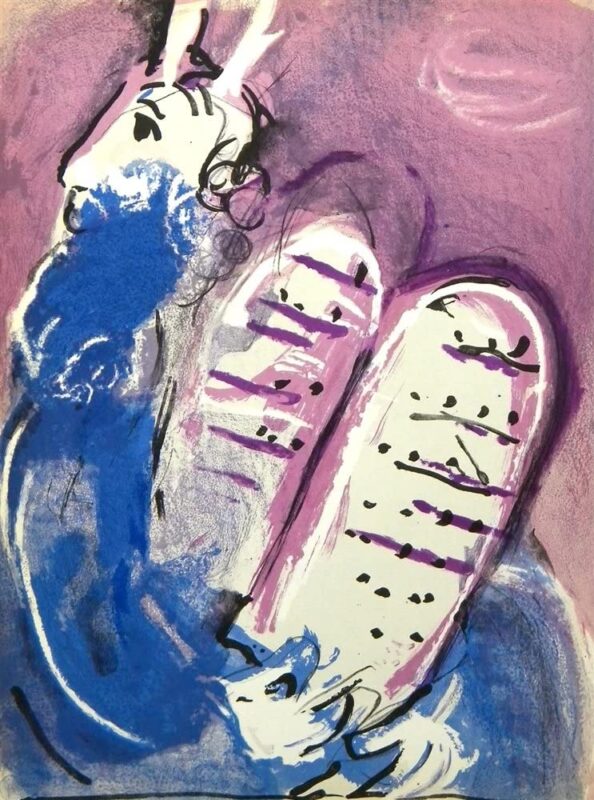
Autumn is a time of year I have always loved. As a student, I looked forward to transitioning back into school and the start-up of all of the clubs, sports, and activities. Now, as a secondary school teacher, my appreciation of this time of year has only increased. It is around this time that the life of a school starts to take shape—student leadership, chaplaincy, athletic teams, volunteer and outreach initiatives, arts programs, etc. Plans turn into reality and the school begins buzzing with activity, creativity, and life!
This autumn, as you might imagine, looks very different. The beginning of the school year was tumultuous, to say the least, and some of us only received our teaching assignments in late September. A number of teachers, like me, were designated to teach the online cohort and, with that, we have sunk into the routines of virtual teaching with considerable reluctance.
Students continue to be moved in and out of our courses due to a host of scheduling issues while the quadmester is rapidly progressing toward its end date in the second week of November. The tight timeline forces teachers to compress the curriculum, either speeding through important concepts or eliminating them entirely. The students “attend” class daily but are behind their screens while we are behind ours, and, even when our cameras are on, there is a palpable discomfort.
In a regular classroom, these students would know each other quite well by Grade 12, and they would continue to build connections with one another throughout their time in a class like mine. In the virtual environment, however, students in my classes are from all over the school board and, despite my efforts, their interaction is limited. As well, during the average school day, my colleagues generally remain isolated in their own classrooms (for good reason), leaving the staff lounge and department offices empty. The school is eerily quiet and the few faces you may pass are hidden behind masks. This is a far cry from the Thanksgiving liturgies, staff potlucks, and Student Council Haunted House tours of the past.
For most teachers, even those with in-class cohorts, the laments are the same: feeling disconnected from the students, being unable to teach and assess in an effective way, concern over students with access issues or learning challenges, and a general lack of guidance and support. At the same time, we watch the news as reports of COVID-19 cases in schools rise and we check in with some of our close friends and family as they await the results of their tests. We miss the loved ones who are outside of our social bubbles, and we worry about them, and ourselves. It is difficult to be hopeful.
One day, as I discussed these grim realities with a colleague, I confessed I was having a difficult time staying optimistic and energized, but that I was simultaneously feeling guilty about this because I also acknowledge how privileged I am in many ways. She offered one of the most helpful comments I have heard throughout this pandemic: “Of course you’re having trouble staying hopeful! What do you expect? We are the Israelites in the desert! This is not the Promised Land!”
Coincidentally, it was at that very time that I was in the midst of discussing the Exodus story with my Grade 12 Religion class. We had talked about how the Israelites in the desert must have felt a sense of hopelessness, fatigue, monotony, and an underlying fear that they might never actually reach the Promised Land. It is difficult to imagine that they ever woke up optimistic and chipper, ready to spend another day wandering in the desert!
During this pandemic, part of the struggle which so many of us put ourselves through is trying to make our lives as close to what they were pre-pandemic as possible. Of course, this is nearly impossible, and our failure to meet our self-imposed standards only heightens our anxiety. By acknowledging that we are “in the desert,” perhaps we can give ourselves permission to feel a little lost, at times hopeless, and generally unable to think more than a few steps ahead at any given time.
My most gratifying class thus far occurred when I shelved the curriculum for one day and chatted with the students about how I was feeling. As a teacher, and one of the only adult influences outside of their home they have regular access to right now, I know that modelling for my students the fact that it is okay to be struggling is perhaps the most important lesson that I can offer. After sharing with them a little about what was weighing on me, my students quickly piped in with words of validation and encouragement, which led to other students sharing their particular burdens, which in turn led to more encouragement from the group. Despite the distance between us and the glitchy internet connection, our discussion rolled on until the end of the period. There was laughter, exclamations of, “Oh my gosh! Me too!” and quiet, muffled sniffles at times. We never got around to our lesson on the Book of Exodus that day, and yet I am certain that we came to a better understanding of how the Israelites were able to survive—and find deep meaning in—their time in the desert together.
Read other InsightOut posts.
Rev. Dr. Matthew Durham is a Roman Catholic priest and experienced hospice palliative care administrator. An alumnus, Fr. Matthew earned an MDiv and a DMin at the Faculty of Theology, and is currently the Executive Director, Hospice Palliative Care and Community Development for SE Health. Formerly, he was the Director of Community Engagement & Advancement at The Hospice of Windsor & Essex County Inc. This article was co-authored with Hana Irving, MA.
Helping the Most Vulnerable at the End of Life
While discussions of how to create a system that supports Canadians who wish to live and age at home have been at the forefront of health care agendas for decades, this discussion has only become more necessary in the midst of the COVID-19 pandemic. Discussions of viral spread, social and physical distancing, the importance of wearing a mask, washing hands, and disinfecting surfaces to prevent infection have become commonplace in households nationwide. At the same time, as a society, we are becoming more aware of the social and economic disparities that have put certain vulnerable populations at greater risk.
Ubiquitous yet largely ignored, in every major city there are thousands of Canadians who are homeless and lacking access to adequate resources to follow public health guidelines about social distancing and hygiene (Jadidzadeh & Kneebone, 2020). Furthermore, people experiencing homelessness are often at greater risk for virus transmission due to crowded living conditions in temporary housing or shelters, or congregate settings, and overall face a 5–10 times greater mortality risk than the general population (Tsai & Wilson, 2020). Those risks only increase for individuals with compromised immune systems or who may be approaching the end of life.
For people experiencing homelessness, access to palliative care has traditionally been a challenge, which has only been exacerbated by the COVID-19 pandemic. Hudson, Shulman and Stone (2017) note that
the delivery of high-quality care in mainstream settings for homeless people is complex for many reasons, including mistrust of health services, isolation, the impact and chaos associated with substance or alcohol misuse and, for some, alcohol-related early cognitive impairment. These factors, alongside the relatively young age at which homeless people may benefit from palliative care, means access to hospice and care homes is currently rare. As a result, homeless people often receive inadequate care and support. (p. 54)
This is a problem that Journey Home Hospice has been addressing for a little more than two years as Toronto’s only hospice serving homeless and vulnerably housed individuals. The hospice, which is a partnership involving Saint Elizabeth Foundation, Hospice Toronto, and Inner City Health Associates, provides 24/7 hospice palliative care, including complementary therapies to patients at the end of their lives, with a typical admission having a prognosis of approximately three months. More than pain and symptom management, Journey Home Hospice also offers formerly homeless patients the opportunity to experience “home,” sometimes for the first time in decades. The small clinical staff, complemented by specially trained volunteers, often become a “found” family for patients who are typically estranged from their loved ones. Volunteers especially fill an important role: reading stories aloud, singing favourite songs, cooking memorable dishes, playing cards, or even watching movies with patients.
Equally important, Journey Home Hospice becomes a place of healing, even as patients approach the end of life: regular meals; a clean, safe place to stay; coordinated pain and symptom management; programs such as art and music therapy, legacy work, and a visiting dog program all help patients to reconnect with their humanity after years of hardship and struggle. The psychosocial and spiritual care program also helps patients reconnect with loved ones if they wish and provides a welcoming space to express their faith or find a connection with their chosen religion.
Every patient who has stayed at Journey Home Hospice comes with a story. As each patient begins to feel at home, they will often share their story with a trusted team member or volunteer, and each life history comes with its own unique heartache. Whether fleeing an abusive family or relationship, struggling to cope with mental health issues and addiction, or facing financial setbacks from a divorce or workplace accident, our patients never intended to be homeless. However, once they found themselves without a permanent address, the struggle to find or maintain employment, save enough money for deposits on a new apartment, or even access social services became almost insurmountable challenges for many.
For many persons who have experienced homelessness, the overwhelming shame and fear associated with appearing “needy and dependent” prevents both men and women from asking for help. This is only compounded by our generally negative view of dependence and aging as a society. A recent study in Montreal found that individuals aged 50–64 were the largest growing demographic of the homeless population, as ageism often made it difficult to find new employment, and age prevented them from accessing social services and support programs designed for older Canadians (Burns, Sussman and Bourgeois-Guérin, 2018).
Journey Home Hospice becomes even more important in this context as a beacon of hope for patients, and as a potential teaching and learning facility on a local, national and international scale. Both from listening to our patients’ experiences and leading research into the factors affecting homelessness, we know that it is largely structural issues that cause and perpetuate homelessness. We are socially conditioned with capitalist values that emphasize individual responsibility, work ethic, and suggest that the only factor that determines success or failure is an individual’s motivation to work towards a goal. In reality, there are political and social factors that shape individuals’ access to opportunities, education, resources, and the necessary support and social services. Poverty and homelessness are closely tied factors that are caused by an inequitable distribution of wealth and opportunity (Murphy and Eghaneyan, 2018).
Our hospice is creating a truly safe space for people who have experienced homelessness, with a specially trained team able to respond to their unique life stories, physical, psychosocial and spiritual needs, as well as to offer care in a flexible environment responsive to the needs of the individual. COVID-19 has demonstrated more than ever that health care solutions in Canada must be innovative and responsive; we are proud that in the midst of this pandemic, not only have we been able to offer patients a safe respite at the end of their lives, we are also expanding to serve more people in the future. Currently, Journey Home Hospice is renovating our existing site to add six more hospice beds and hopes to be open in late 2020.
References:
Burns, V.F., Sussman, T & Bourgeois-Guérin (2018). Later-life homelessness as disenfranchised grief. Canadian Journal on Aging, 37(2), 171–184.
Hudson, B., Shulman, C. & Stone, P. (2017). ‘Nowhere else will take him’ – Palliative care and homelessness. European Journal of Palliative Care (24)2. 54.
Jadidzadeh, A. & Kneebone, R. (August 2020). Homeless shelter flows in Calgary and the potential impact of COVID-19. Canadian Public Policy. S160–S165.
Murphy, E.R. & Eghaneyan, B.H. (2017). Understanding the phenomenon of older adult homelessness in North America: a qualitative interpretive meta-synthesis. British Journal of Social Work, 48, 2361–2380.
Tsai, J. & Wilson, M. (April 2020). COVID-19: a potential public health problem for homeless populations. www.thelancet.com/publichealth (Vol 5). e186–e187.
Read other InsightOut posts.
Fr. Don McLeod is a Basilian priest, an alumnus of USMC (College and Faculty of Theology) and a member of the Collegium since September 2013, serving as Chair from 2017 until the present. He has a particular interest in institutional governance and in ensuring that the proper role of the Collegium in University governance is clearly outlined. He has taught and been an administrator at both the high school and university levels, most recently at St. Joseph’s College in the University of Alberta. He continues to exercise his passions for aviation and cycling, Catholic Social Teaching and the study of Scripture and Biblical languages, while residing with the Basilian Fathers of Presentation Manor in Scarborough.
“Piloting” USMC
Two or three weeks ago, someone asked me if serving as Chair of the Collegium was burdensome, especially during the current COVID-19 crisis. After a few moments’ reflection, I replied that although Collegium had recently had to confront some very challenging issues, I would not describe my role as “burdensome.” To the contrary, the past four-plus months have been challenging but not burdensome.
To help clarify, permit me to draw an analogy with aviation. When people learn that I am a licensed pilot, they often ask if I fly solo—to which my usual response is “yes and no.” “Yes,” if that means that I am the only person in the aircraft. “No,” if the implication is that no one else is involved in a flight. Although it sounds counter-intuitive, even if the pilot is the only one aboard the airplane, there is no such thing as “solo.”
Most people who fly commercially know that a safe and successful flight requires professional pilots “up front,” equally competent and professional flight attendants in the cabin and good ground crew—and that is certainly true. However, there is much more to aviation than that.
First, even a small aircraft comes with a very detailed Pilot’s Operating Handbook—in the case of the Cessna 172, the aircraft I fly, nearly 200 pages of very dense information. Included in this are several checklists covering nearly every conceivable situation, from before engine start through to shutdown—and the pilot who ignores or omits even parts of these does so at his or her own risk. These documents reflect literally thousands of person-hours of designing, building and testing, without which no aircraft ever makes it to the flight line, let alone into the air.
Further, behind the scenes of any safe flight are the people who service the aircraft and keep it airworthy. This includes mechanics, dispatchers, fuelers, cleaners and airworthiness inspectors—all of whom are required to ensure that the aircraft is indeed safe to fly.
Most of my compatriots fly out of and into what in Canada are known as certified aerodromes—airports, for short. These facilities require ongoing maintenance to ensure that taxiways and runways are safe and clear of any debris, including snow and ice in winter, that pavement markings including runway numbers are clearly visible and that all ground signage is accurate. Much of this work goes unnoticed but is essential to safe operation—and is regularly inspected.
Once the aircraft is ready, the airport safe to fly out of, the pilot (and maybe passengers) belted in and the engine started, the pilot is still dependent on many people to ensure a safe flight. If the airport has traffic controllers the pilot must obtain clearance both to taxi and to take off and must rely on the men and women at the other end of the radio waves to ensure safe separation of all aircraft. Even at an uncontrolled airport, the pilot must rely on other pilots and even people on the ground to advise of their positions and intentions. The same is true, in reverse order, when preparing to land.
In short, from long before engine start to after shutdown, safe and enjoyable flying is dependent on the skills, attentiveness and commitment of a significant number of people filling a wide range of roles—the pilot is one of these people, undoubtedly an essential cog in the machinery, but far from being the only one. In other words, the pilot in reality is never “solo.”
To return to my analogy, one could suggest that the Collegium, and in particular the Chair, might be viewed as the pilot who is charged with ensuring that the University is able to fulfill its mission. However, just as with the pilot of an aircraft, a successful “flight” of the University is dependent on the commitment, dedication and competence of many more persons than the relatively few that a casual observer might see seated at the Collegium table.
This has been even more apparent to me as we have dealt with the impact of the COVID-19 pandemic. From the very beginning, every member of the USMC community, regardless of their particular role, has given more than generously of their time and talent to ensure that we “fly” successfully through this unprecedented turbulence. I may by analogy be one of the “pilots” for this adventure but am well aware of the enormous debt of gratitude my colleagues and I owe to so many who have contributed to our safe and level “flight.” To them I say simply, “Thank you!”
Read other InsightOut posts.
Andrew Selvam is currently the Acting Chaplaincy Teacher at St. Joseph CSS in Mississauga. He is also a science and religious studies teacher with the Dufferin-Peel Catholic District School Board. He is currently pursuing his Master of Religious Education degree at St. Michael’s Faculty of Theology. He enjoys music, hanging out with friends and family, and travelling.
A Language of Love, Unity, and Joy
The day was March 12; I remember it clearly. I had just finished with our chaplaincy team meeting in the library when a student asked me if it was true…that they would be closing schools for three weeks because of COVID-19. I immediately went to my computer to confirm what I hoped wasn’t true and, lo and behold, it was. We would be away from school for at least three weeks. Immediately the news cycle was flushed with what was becoming a worldwide pandemic and, as each given week passed, it seemed more and more likely that the school year would happen away from the school.
After March Break, it was a very slow waiting game. Retreats, social outreach programs, and student engagement activities would have to be put on hold. The way relational ministry would have to be delivered would look very much different. I had been reading all the emails from our school board offering all of the different platforms for learning, but I stood there for a moment and wondered “How do I connect with students?” From the beginning, it became a get-go of mine to make sure that, in as many ways as possible, I was going to make it feel as much as it could for students like we had never left. My first digital daily reflection went out on the feast day of the patron of our school, St. Joseph, more important than ever as the patron saint of families and the universal church. The Holy Spirit that I always felt travelling through a school would be called upon to help me figure out this new upper room. And that was just my motivation. I needed the Holy Spirit also to do the work of expanding this upper room, now neighbourhoods apart from each other and along a digital superhighway.
As each new day rolled out, each reflection and activity would focus more on refocusing our “new reality” into something positive, something to come alive through the Spirit. Meeting with students using videoconferencing applications made it as close to kids coming by the office as I could. Three-and-a-half months later, it has transformed into an opportunity for us to hear each other, talk about the struggles of the day, of the week and of the month, and offer support when needed. With the chaplaincy team back in full swing, I was ecstatic that, more than ever, kids were looking for ways to be engaged outside of the classroom. Each discussion we had and prayer we said felt like therapy for the mind and the soul, for the kids and for me.
But distance-learning causing frustrations wasn’t the only thing on the minds of staff and students. The number of deaths of relatives of staff and students was on the rise, and I asked the Spirit to just give me the right words to say when I picked up the phone to offer my condolences and support in any way that I could. It also became apparent that many of our families had parents unable to work, raising the possibility of not being able to put food on the table. The St. Vincent de Paul society helped us out, as did our generous staff, to provide food and gift cards for our neediest families.
I have to say I had my reservations. I did not know what distance chaplaincy would look, but it has been more than enlightening. It has shifted me out of my comfort zone in a way only the Holy Spirit can, and moved me to find energy reserves I did not think I had. We had just celebrated Easter at the beginning of this pandemic, and we know that we are an Easter people called, as Christ did, to work to make anew. More than anything, though, we have been called to be a Pentecost people—gathered together, filled with our blessed gifts, so that people outside our Upper Room can hear us speak in a language that they could understand—a language of love, unity, and joy.
Read other InsightOut posts.
Throughout the seasons of Lent and Easter, Dr. Darren Dias, OP, who teaches systematics at the Faculty of Theology, has shared his homilies with the broader university community. For the Feast of Pentecost, he spoke on the subject of race and renewal.
Pentecost 2020: Act 2:1-11; 1 Cor 12:3-7, 12-13; John 20:19-23
Today we celebrate the renewal of creation when the risen Lord appears amidst his disciples and breathes life into them, as God first breathed life into Adam (Genesis 2:7). But today the last words of George Floyd—a 46 year-old father of 2 brutally murdered by police because he was black—echo in our midst: “I can’t breathe.”
This week the Ontario government warned that confinement and distancing regulations will not be relaxed as expected because of the increase of COVID-19 cases. We see these especially in lower income and new immigrant areas of the city where pockets of racialized persons live. We have spent the entire Easter Season in confinement and now at its completion, it looks like it will be prolonged.
Perhaps not unlike the disciples we lock our doors out of fear of the real dangers lurking about; locked in our homes or in the bubbles created by masks and gloves and safe distance. Yet Pentecost in John’s Gospel account is the moment when Jesus appears to the disciples, meets them in their fear, and releases them from it by breathing the Spirit of new life into them, and then sending them into the world on a reconciling mission. But we remain locked up, anxious about COVID-19 , and for racialized persons like me, fearful of the lurking plague of violence. So what kind of Pentecost can we celebrate this year?
In the narrative from Acts we read another account of the giving of the Holy Spirit. A violent wind fuels the tongues of fire that appear over the disciples. These are external manifestations of the Holy Spirit’s presence in the community. Likewise, the disciples’ preaching, understood by speakers of various foreign languages, Parthians, Medes, and Elamites, Libyans, Romans, Cretans, etc., is a manifestation of the Spirit’s power.
Pentecost is often seen as a remedy to the confusion of the multiple languages that resulted from the destruction of the tower of Babel in Genesis 11. Now we don’t have readings from the Hebrew Bible during the Easter season, but if you remember in Genesis 11 the whole earth is said to have spoken one language. This makes the people of earth powerful and they decide to build a tower to the heavens as a testament to their power. In response the Lord comes and scatters the people, replacing the single language that seemed to be constitutive of their powerful abilities with many languages. The people become confused because they are unable to understand one another due to the multiplicity of languages and their building project is left unfinished. If a multiplicity of languages that resulted in confusion was divine punishment for the Promethean building project, then Pentecost might be understood as its remedy.
For example, Gregory of Nazianzus writes:
“But as the old Confusion of tongues was laudable, when men [sic] who were of one language in wickedness and impiety, even as some now venture to be, were building the Tower; (Genesis 11:7) for by the confusion of their language the unity of their intention was broken up, and their undertaking destroyed; so much more worthy of praise is the present miraculous one. For being poured from One Spirit upon many men, it brings them again into harmony.” (St. Gregory of Nazianzen, Oration 41)
But in the narrative from Acts 2, Pentecost does not result in a single language like Babel but is about being able to understand one another. Multiple languages are not replaced with a single language: all are speaking their own language but they understand one another.
In his reflection on Genesis 11 and Pentecost, Gustavo Gutierrez, OP, claims that the builders of Babel are punished not because of a rivalry with God and God’s ensuing jealousy, but because Babel is a “political attempt, totalitarian in nature, to dominate people.” Clear allusions to the imperial project of the tower’s construction are seen in Peter Bruegel’s painting of the Tower of Babel. Bruegel (1525-69) paints the Tower of Babel to look like one of the greatest symbols of western imperialism, the Roman Colosseum. Though a Catholic himself, Bruegel alludes to the singularity of the Latin language in the Roman Catholic Church in depicting a stylized version of one of Rome’s greatest landmarks, compared to the myriad of vernacular languages used by Protestants in the low countries of his time.
That human community is expressed through a single language is a fiction. Gutierrez argues that a single language aims at a more efficient domination of the other through “the flow of orders coming from the central authority.” Dominating and oppressive imperial projects are impeded by diversity, especially diversity in language. A single, imposed language is an abuse of language and power. Pentecost, on the other hand, is about the life giving option of diversity. This diversity of languages makes dialogue, mutual understanding, inter-personal exchange and unity possible precisely through the diversity.
The gift of the Holy Spirit did not change the immediate situation of the disciples. They still struggled with Jesus’ new mode of presence and they still feared the authorities and their message was met with resistance. But they were able to establish new ways of being community together and beyond themselves. The disciples were able to move beyond themselves to build relationships with those who were most different, strangers and foreigners.
As Pope Francis reminded us during Holy Week, the world has been sick in many ways, even before COVID-19, but many of us with privilege thought that we would not get sick. Evils like white supremacy that render human persons into things with no worth, existed before George Floyd breathed his last. But many of us imagined that we were either not susceptible to or not implicated in structures of power and race. This Pentecost we are reminded that we too can get sick and that the violence of racism looms large.
The gift of the Holy Spirit compels us to creative and bold ways to build-up human relations in their wonderful diversity. Three examples come to mind from this past week. First, this weekend the College Theological Society decided to hold its annual conference online due to COVID-19. This virtual gathering made it possible to relate to one another, to break out of our confined spaces, and to become a community of teachers and learners once again. Another example is the Atlanta Chief of Police who met with protestors in the wake of George Floyd’s murder. She did not condemn them or order them to go back home. Instead she listened to them and affirmed them in their justified fears. Protestors and police spoke peacefully and meaningfully to one another. Last, today in our zoom Eucharist we find ourselves constituting community in a new way to share in word and sacrament across special divisions. I’ve never heard so many of you say that our weekly time together has become the highlight of their week. COVID-19 reveals the depth of our need to become community.
Every Pentecost is the re-birth of the church anew into a particular time and place and context, each with its own joys and sorrows. The visible manifestation of the Holy Spirit in Pentecost today may be very similar to the first Pentecost: reaching across boundaries to understand those who live differently, speak differently, experience reality differently. Through speaking and the use of language—which is always first by listening—we exchange breath. Every language exchange includes the exchange of breath (but no ‘moist’ speaking). In these times when it has become dangerous to breathe, we are called to exchange life-giving breath as the disciples did, using language to build in inclusive community.
Our Spirit-given diversity challenges singular and dominating forms of power that dehumanize, and that ignore the breath of divine life, the Holy Spirit, who dwells in all creation, in every human being. This gift offers us countless and bold ways to build communion and inclusive community where diversity breathes life.
Gustavo Gutierrez, “Between Babel and Pentecost,” in Gustavo Gutierrez, Essential Writings ed. James B. Nickoloff (Maryknoll: Orbis Books, 1996)
Because Sunday Mass has been cancelled due to the coronavirus pandemic, Dr. Darren Dias, O.P., has shared his homily for this, the Fourth Sunday of Lent.
Dr. Dias teaches in St. Michael’s Faculty of Theology, specializing in Trinity, Religious Diversity, and teaching methods. He is currently working of a SSHRC funded project with colleagues Gilles Routhier (Laval) and Michael Attridge (St Michael’s) entitled: “One Canada Two Catholicism: Divergent Evolutions in the Catholic Church in Quebec And Ontario, 1965–1985.”
Finding God in Challenging Times
John 9:1-41
Amid this global COVID-19 pandemic, isolation and physical distancing are necessary to diminish the spread of the virus. In our time we can definitely understand the link between illness and isolation. In Jesus’ time, illness, and particularly something like blindness, was believed to be a punishment for the sins of one’s parents or ancestors. Thus, the question of the disciples to Jesus about the man born blind: “Who sinned this man or his parents?” Of course, Jesus’ answer is neither one; the very question misses the point. The man born blind would have been marginalized because his blindness was thought to be the product of divine punishment and so he would have been excluded from the normal network of social relations. We read that he had to beg for his livelihood. Like many other healing accounts, when Jesus heals this man he not only cures him physically but removes the reason for him to be excluded and isolated from his community. Jesus heals him and tells him to purify himself in the pool of Siloam so that he might be re-born into his community.
In the narrative the man born blind is cured of his blindness but only gradually begins to see. When initially questioned by Jesus’ critics about who opened his eyes, the man responds rather journalistically by recounting the events as they happened, not even mentioning Jesus by name. When pressed his questioners ask, “what do you say about him?” The man responds with the conviction: “He is a prophet.” His questioners react with a strong judgment against Jesus, calling him a sinner because he works on the Sabbath. Yet again they ask the man how is it that he now sees. Seemingly frustrated by their criticism of Jesus — and with firm conviction — the man says that Jesus is not a sinner but one who obeys and worships the true God of Israel and to whom God listens. The man’s questioners, those in power and authority, are scandalized that this poor beggar, a man born in sin else he would not have been blind, someone neither named nor vouched for by his own parents, would dare to teach them and so “they drove him out.” The man born blind, cured by Jesus, about to leave the isolation of his blindness behind, on the cusp of entering into social relationships, is driven out of the community he was never really a part of but longed to have a place. It is at this point, a low point for the man who has just been healed of his blindness, that Jesus seeks him out and finds him. In the brokenness and vulnerability of the man born blind, someone who has just gone from marginal to outcast, Jesus shares himself by revealing who he is: I am he, the one speaking to you is the Son of Man. Jesus chooses to reveal his true identity not to the powerful but to the outcast. Because of this intimate moment the man can finally answer the question that had been put to him throughout the narrative about the person who cured him. The man now sees who Jesus really is.
In our Gospel selection today the man born blind, though he had a powerful experience of healing, is only gradually able to see God’s vivid presence in his midst in the person of Jesus Christ. In these days, weeks and even months ahead, many will experience the difficulty of isolation and loneliness, and be challenged to see the God who seeks us and finds us in our vulnerability and fear. But just as Jesus revealed God’s presence in his very person, maybe God’s presence reveals itself to us in the midst of this present crisis: in the selfless dedication of medical workers; in the store workers who ensure our access to food and other supplies; in neighbours who check in on the elderly or vulnerable; in our prayerful solidarity with those who are ill from the virus.

If there’s a club for people holding three degrees from St. Mike’s, move over and make space for the newest triple alumna, Rosemary Boissonneau.
Rosemary will be awarded her MA in Theological Studies from St. Michael’s Faculty of Theology on Saturday, Nov. 9, 2019, having received a Master of Theological Studies in 2017, and a BA, with a major in French and a minor in English, in 1987.
“It was interesting when I came back to St. Mike’s (in 2011) because I was a mother and a teacher and my oldest was in university herself,” she recalls. “What I found was the same hospitality, the same sense of welcome as my undergrad days, but because the Faculty of Theology is small, the sense of community was more pronounced, the sense of Catholicity more informed.
“There’s a real sense of identity and, given the size of the place, it’s easy to get to know people.”
The faculty impressed her for multiple reasons. One of the first courses she took when she returned to school was with Old Testament scholar Dr. John McLaughlin, who, as Rosemary describes, “sets rigorous standards” not only for the content of work submitted but also in his expectations regarding the mechanics of papers. They were standards, she notes, that she applied to all subsequent work to ensure she was meeting the McLaughlin bar and making the most of her education.
There was the fact that classroom topics would be addressed from a range of viewpoints, whether it was one of feminist theology or eco-theology, as well as the expectation that students would use inclusive language as much as possible.
She had the opportunity to learn the workings of a university by serving a term as a student representative on the Collegium, St. Michael’s board overseeing governance of the university.
And then there was Eco-theology Faith and Practice, a week-long course held at the Villa St. Joseph Retreat Centre in Cobourg, taught by Sisters Linda Gregg and Mary Rowell, CSJ. The course confirmed Rosemary’s interest in eco-theology, and led her to studies with eco-theologian Dr. Dennis O’Hara at St. Michael’s Elliot Allen Institute for Theology and Ecology.
“I always cared about the environment but the summer after Laudato Si’ came out I saw Dennis on a panel, which included a talk about the need for climate activism, and since I was working half-time to complete my studies, I felt I had the time to get involved.”
Her goal was to combine spirituality with justice, and that led to her work with ClimateFast, a volunteer organization whose goal is to encourage politicians to take greater – and faster – action on climate change, as well as work with #FridaysforFuture, the group behind the student climate strike.
It also played a hand in her MTS thesis, entitled The Christological Symbolism of Water in the Gospel of John.
“Rosemary is not merely intelligent but also thoughtful and morally motivated. She cannot only grasp complex ideas but she reflects on them in order to integrate them with other knowledge that she has gained,” says Dr. O’Hara. “This invariably prompts her to action, to reframe her own life and encouraging others to follow suit in their own way. She will willingly pay the price for a right course of action. This is why most professors relish her presence in class.”
Reflecting on her time at the Faculty, Rosemary says it enhanced her worldview.
A deeper understanding of Scripture, for example, has “helped me articulate what I believe,” she notes.
It has also left her an even busier woman, because even though she’s back to teaching full-time, she’s finding it impossible to set aside the volunteering she started when she was working reduced hours to complete her studies.
As she talks about finding a way to balance the rest of her life with the possibility of returning to do doctoral work, there’s little doubt she’ll find a way.
By Catherine Mulroney
When student Therese Hassan offered her reflection at the Faculty of Theology’s Commissioning Mass earlier this spring, she shared a great awakening she had about her time spent studying, an insight that likely resonated with many of her colleagues.
“What I can tell you today is that … I have much deeper and profound questions to ask and venture to understand – and I love that this is the case,” the Master of Theological Studies student explained.
The annual tradition of the Commissioning Mass is one of the most moving moments of the Faculty’s academic year, a time for the community to offer prayers of support and blessing for those students poised to graduate and begin their lives of ministry. After Mass, students, faculty and family gather for a reception.
“One of the important aspects of studying theology is that community becomes like family. It’s important to get to know each other because we learn, in part, through relationships,” explained Fiona Li, who co-chaired of the Student Life Committee (SLC) this past year and was instrumental in planning the post-Mass reception. Fiona will complete her Master of Theology (ThM) degree this year and move on to doctoral work. She earned her Master of Theological Studies degree from St. Mike’s in 2016.
For Fiona, who describes her time at the Faculty as “transformative,” the Mass would prove to be a “bittersweet moment,” one last time to attend liturgy with classmates and professors, “one last time to serve as a reader or an acolyte. … This is the community sending us off, telling us ‘We think you’re ready for the world.’ It’s a beautiful experience.”
Scott Harris, who chaired the SLC’s Liturgy Committee this year, looked forward to the blessing and act of being sent forth that is offered at the Commissioning Mass. He’s grateful for the opportunity to serve as committee chair, noting that it “deepened my experience with Church life.” As chair, he was required to invite presiders for Mass, arrange for readers and acolytes, select hymns and write petitions, as well as plan non-Eucharistic liturgies—all skills he will be able to call on in the future.
Chairing the committee meant “I became more immersed in the community. It meant, for example, having to take others’ views in mind rather than just planning liturgies that met my taste in music, for example. It gave me an entirely new perspective on liturgy.”
The Commissioning Mass is a wonderful opportunity to reflect on how the study of theology transforms how we look at the world and our place in it, says Fr. George Smith, CSB, who presided. Fr. Smith was himself offered a blessing at the reception by Fr. Peter Galadza of the Metropolitan Andrey Sheptytsky Institute of Eastern Christian Studies, an acknowledgement that Fr. Smith’s time as Superior General is coming to a close, with new duties with the Basilian Fathers beckoning.
Citing the Vatican II document Gaudium et Spes, Fr. Smith noted before Mass that “too often these days we see ourselves as Church against the modern world” rather than, as the English title of the 1965 document reads, the Church in the Modern World.
Theological study offers the opportunity to examine the great challenge of what it means to be a Church in service to the modern world, he said, noting that it builds upon Church tradition. Self-awareness and self-knowledge lead to an understanding that the centre of ourselves is God, he noted.
“Theology opens up the conversation to magisterial teaching of the Church, bringing rich tradition into conversation.” Pope Francis, for example, gives life to his own pastoral theology without dismissing the teachings of Pope Benedict before him, he noted.
For Therese and her classmates, that conversation is just beginning. As she told the congregation at the Mass, “this thing we do called theology isn’t just about coming to or acquiring knowledge. It’s about living in the questions themselves.”
And so, reflecting on late nights writing papers, struggling with complex readings and trying to keep on top of all the demands of student life, Therese told her colleagues that if they still have a desire to learn more and engage with the Mystery that is God, “congratulations: you are doing this right.”
Catherine Mulroney is the Faculty of Theology’s programs co-ordinator.
By Catherine Mulroney
When David Byrne opted to attend a conference as an MDiv student a few years back, little did he know that the conference would lead not only to further studies but also to a fulfilling career.
The conference Byrne attended was on restorative justice, an approach that sees criminal offenders make amends with victims and the broader community. Fascinated by what he heard, Byrne sought to do his mandatory MDiv field placement – an extended period of service learning that stems from a theological question — in this area, landing a spot with Peterborough Community Chaplaincy, about 135 kilometres northeast of Toronto.
One of the programs under the Peterborough chaplaincy umbrella was a local chapter of Circles of Support and Accountability (CoSA), a national program designed to offer a network of support to sex offenders who have served their sentences, helping with weekly meetings to re-integrate them into community life while reducing the risk of recidivism.
That was 2009. Today, not only is Byrne the executive director of Peterborough Community Chaplaincy, he also serves as chair of CoSA Canada, the umbrella organization overseeing local chapters, while also continuing as a doctoral student at the Faculty of Theology, working on a thesis on the ethical, moral and spiritual questions surrounding chemical castration of sex offenders.
Under Byrne’s leadership, CoSA Canada received a $7.48-million grant from the federal government earlier this year under the National Crime Prevention Strategy to assist 14 CoSA sites across the country as they help offenders accept accountability and responsibility for their actions as they complete their sentences and return to the community.
Byrne credits mentor and thesis advisor Dr. Dennis O’Hara with helping him to find the confidence and self-awareness to discover his calling and recognize his skills.
“Dennis saw something in me that I hadn’t seen in myself,” he reflects. “Dennis provided the one-on-one guidance I needed to help me identify my strengths and interests.” Byrne also credits Dr. Marilyn Legge, of Emmanuel College, with being another great mentor for him.
That ability to offer guidance to another is a skill Byrne now employs in his workplace when he comes in contact with clients.
“We can help, but sex offenders need to be willing to work with us,” he explains.
Byrne’s workplace responsibilities are numerous, and include managing a staff of 15, and overseeing local residences, including a 10-bed palliative and long-term care home for released offenders. People who are incarcerated “age out” more rapidly, Byrne notes, due to a complex set of factors ranging from diet and exercise to issues of mental health.
One of the biggest challenges he faces are societal. For example, “revulsion stands in the way of treatment,“ he notes. Current research, he adds, indicates far more people than once thought have a propensity for pedophilic tendencies.
While he finds his work infinitely rewarding, one of the most important pastoral skills he learned while working on his MDiv was understanding the importance of leaving work behind, an especially important gift, as his wife works for a non-profit agency as well.
“When we get home, we’ll spend 10 to 15 minutes de-briefing, and then it’s all about family,” says the father of two.
Byrne finds many of the skills he developed while working on his MDiv to be applicable to his work life: he leads retreats and meetings, for example, and uses the research and writing skills he’s developed whenever he drafts a grant application. He’s also taught Additional Qualifications courses for teachers at the University of Ontario Institute of Technology in Oshawa, and taught ethics at Fleming College in Peterborough, ON.
This article was authored and submitted by the University of St. Michael’s College Faculty of Theology
By Catherine Mulroney
Internationally noted theologian Gregory Baum, one of Canada’s last links to the Second Vatican Council and a former University of St. Michael’s College, Faculty of Theology professor, has died in Montreal at the age of 94.
“Gregory Baum was a major theologian, an interpreter of Catholic Social Teaching and papal documents, and a key communicator of the change of Vatican II, “explains Dr. Lee Cormie, a former Faculty colleague of Baum’s and a friend for 50 years.
Born in Berlin, Baum arrived in Canada in 1940, a refugee who then spent time in an internment camp in Quebec. He began teaching at the Faculty of Theology at St. Mike’s in 1960 but headed to Rome to serve as a peritus, or theological advisor, in the secretariat for Christian Unity at the Second Vatican Council, which ran from 1962-1965. During that time, Baum, the child of a Jewish mother and a Protestant father, entered the Catholic Church as a young adult. He contributed to the first draft of the ground breaking document entitled Nostre aetate, or The Declaration on the Relation of the Church with Non-Christian Religions. He also was involved in the sessions that resulted in the documents Unitatis redintegratio (On Ecumenism) and Dignitatis humanae (On Religious Liberty), topics that were to fascinate him throughout his lengthy academic and publishing life.
“Because he was an advisor to Vatican II he had an inside track on how much was changing; he was a leading light on what had happened at the Council and what it meant for the Church,” notes Cormie, who team-taught a course with Baum at the Faculty on theology and the social science.
“He was a very big presence on campus,” engaged in countless lectures, conversations and teaching, Cormie recalls, adding that in the early 1970s, Baum began to teach graduate courses in sociology and religious studies at the University of Toronto as well. It was at this time that Baum began to immerse himself in social justice issues, inspired by Catholic Social Teaching.
After moving to Montreal in 1986 to begin teaching at McGill University, Baum also became in important interpreter for those outside of Quebec regarding what was happening in the Church in Quebec in light of the Quiet Revolution, Cormie notes.
“He was also an unbelievably friendly and warm person, someone who carried on an ongoing conversation with an incredible number of friends,“ Cormie recalls.
Noting that Baum labelled himself a “conversationalist”, Cormie adds that the label “speaks to the renewal that came with Vatican II, making us a communication of people in conversation with each other.”
A prolific writer, Baum published books on topics ranging from the Church in Quebec and Muslim theologian Tariq Ramadan to critical theology and the signs of the times. He was also the founding editor of The Ecumenist, a Canadian periodical dedicated to theology, society and culture.
In 1990, when he was made an officer of the Order of Canada, his citation described him as “a guide and inspiration to generations of students of many different faiths and backgrounds.”

